
Best Sailling Route Around the World

Sailing around the world : Step by step guide for the best catamaran itinerary
Sailing around the world on a catamaran is not a crazy dream: couples, families with three ou four children on board Nautitech 40 or 46 prove at this very moment that adventure is within reach.
Because this adventure does not present, far from it, the same level of sporting, physical and mental demand as the Vendée Globe. Because it’s entirely possible, as many sailors have told, it is quite possible to sail around the world without encountering a single storm, not even the slightest gale.
Only thunderstorms or squalls, sometimes going with strong gusts of wind.
Best time to cast off on a sailboat, practical guide and tips
Obviously, when you look at a chart to find the best possible route around the world, sailing a catamaran, the first question that arises, in addition to the one of the budgets, is not so much of where to go, but when leaving for this journey of a lifetime. Which naturally leads to a prerequisite: how much time do we have?
Aboard their Nautitech 46 Open catamaran Kumbaya, the Dolley family was off for a three-year journey. As a matter of fact, they’ll spend four years to complete it. Of course, it’s still possible to race against the stopwatch, but as you’re not exactly on a Jules Verne Trophy or a world record, its better, with a sailboat, to plan with a wide margin, even if you’re not going on a cruise: three years is a reasonable amount of time, we’ll see why.
Routes and Winds: Understanding the Trade Winds for your Trip.
Another obvious observation: the best route around the world when sailing a catamaran, is the one where the wind always blows in the right direction, in other words the one where you’re heading. With following seas. With the wind and waves on the stern, catamarans are made for sailing an average of 160 to 200 nautical miles per 24 hours. Now, nature being well made, this route exists, it’s the one that follow the trade winds. In both hemispheres, Highs have the good idea of basking between the tropics and mid-latitudes.
HOW DO WINDS WORK IN EACH HEMISPHERE?
In the Northern Hemisphere anticyclones, the winds rotate clockwise around the high-pressure bubbles. And in the opposite direction in the South. Thus, by following a course south of the Highs in the Northern Hemisphere and north of these in the Southern Hemisphere, you are sure to benefit from this wonderful find of Nature that is the trade winds, a real all mapped out itinerary.
As the Atlantic islands are located right in the trade winds of the Northern Hemisphere, and the Pacific and Indian ocean islands in the trade winds of the Southern Hemisphere, the would be circumnavigator tells himself that all he has to do is leave and let himself and his sailboat be carried away by the warm and steady breezes which the Anglo-Saxons call trade winds, the winds of commerce.
The importance of weather when planning
All that remains would be to be more specific about the most idyllic route around the world aboard a catamaran, for a trip that would be remembered for the rest of one’s life.
But it’s not that simple. Of course, tropical regions do not experience winter. But in summer, they suffer nasty disturbances called hurricanes, cyclones, or typhoons, depending on the part of the world where these dreadful whirlwinds are rampant.
And everyone knows that summer in the Northern Hemisphere is winter in the South, and vice versa. This leads the candidates around the world by catamaran to build a route that, much more than a choice of departure and arrival dates, simply avoids cyclone season in both hemispheres. Or at least one that rules out the possibility of crossing an ocean during this infamous period. You are now faced with the choice of dates, route, and destinations. It’s the moment when you dream… while keeping your feet steady on deck !
The ideal crossing of The Atlantic for a round-the-world sailing trip
From la rochelle to the canary islands : start of the trip.
So, let’s leave La Rochelle and France in the summer. Our Nautitech is ready. The got his sea legs during short weekend sailings or brief vacation cruises. We set sail, heading to 240° to exit the Bay of Biscay without too much delay. It’s not that the Bay is hostile during summer, quite the opposite, even if a stormy low can sometimes make it look threatening. It’s that here, on occasions, the sea can be very unpleasant. The Atlantic swell bounces off the edges of this chamber pot and often produces a kind of messy chop that jostles the hulls of the boats and their crew.
When to cross the Atlantic with a sailboat ?
You might as well pick up your moment by looking at the swell maps. If, for the best reasons in the world, you can’t leave in July or August, don’t linger too long in early autumn. A departure at the end of September or beginning of October is obviously still possible, but be wary of the stopover in A Coruna, in the northwestern corner of the Iberian Peninsula. You can get stuck there for days on end with the big autumn lows.
It is therefore better to aim directly for Cascais, at the mouth of the Tagus, which can be reached in five days on average from La Rochelle. On the way, you pass Cape Finisterre, our own Cape Horn and, Portuguese trade winds filling your sails, you sail downwind to the Blue Country and to Lisbon, a stunning capital city that offers everything you need to prepare for the next stage of your itinerary, the Canary Islands.
In the summer, the 600 nautical miles crossing (allow four days or less) to Graciosa or Lanzarote let you get used to the open seas without risking weather traps, which is not always the case in autumn. The anchorage of Graciosa, at the end of the crossing, offers a delightful transition before heading to one of the three beautiful marinas of Lanzarote. There, you’ll be able to prepare for the next crossing.
From the Canary Islands to Le Marin marina in Martinique, transatlantic crossing
Better to cross the Atlantic in November, hoping that the trade winds will have settled in, which is not always the case in this season.
If the schedule is a bit tight and the route more flexible, you will embark directly on the crossing to the West Indies. The best thing to do with a Nautitech catamaran is to aim for the south of Martinique, a little less than 3 000 nautical miles away. This will take fifteen or twenty days on average. Dropping the anchor in Sainte Anne, at the end of the crossing, offers a magical transition. The boat is stationary, the water is still. Then, you can reach Le Marin marina, where the local Nautitech dealer will be able to check your catamaran and fix the possible small damages of the crossing.
Let’s sail to Dakar and explore a captivating Africa
On the other hand, if you have eternity ahead of you or almost, leaving Lanzarote for a crossing -sometimes not free from calms- of a thousand miles towards Cap Verde Islands or Dakar has several advantages. If you are aiming for Mindelo, in front of the captivating Santo Antao, in the northwest of the archipelago, you continue learning the open sea with a crossing roughly twice longer than the previous one. Then, you dive in the Cape Verdean melody, made of smiles, music and strong traditions.
Set sail for Dakar and the amazing country of Senegal and discover an incredibly vibrant Africa. And give yourself the opportunity to sail up the Sine Saloum River, a day’s journey from Dakar, where the shallow draft of the catamaran will allow wonderful explorations in the land of the lions of Teranga.
Leaving Africa for America
A new choice then opens up : either set a course 220° for the shortest possible Atlantic crossing – 1650 nautical miles towards Jacaré marina in Brazil, between Recife and Natal, with crossing the Doldrums and the equator, which can take up to two weeks on average, or sailing to French Guyana, which lengthens the crossing by about 600 nm (approximately four days) following course 255°, but gives access to a piece of Equatorial France, from the Salvation Islands to the Kourou site, with a little further north, the possibility of sailing up the river Maroni. There, the catamaran once again proves to be a perfect fit.
Note that you can choose this American tour on the way back, if you’ve decided to sail round South Africa rather than daring to sail the dangerous Red Sea and the Suez Canal… Also, bear in mind that Cayenne being located at 4°52 North, the weather there is equatorial, with very muggy, very humid, and boastful conditions.
The good news is, the next goal being to sail to the Caribbean, if the trade wind is lazy, a branch of the North Equatorial current leads northeast to the West Indies with up to two knots of speed.
From the West Indies to Panama, an essential stop on the journey
You sail up to the island of Grenada, a little-known pearl of the West Indies, that some consider the most beautiful of all. There, you can prepare your Caribbean Sea crossing toward Panama, at the southern tip of Central America. Before departing for this leg, you can moor in the Grenadines islands (which depend on Saint Vincent) then visit on the way the Dutch ABC islands (Aruba, Bonnaire, Curaçao), a striking change of scenery, and finally stop in beautiful Carthagena, Colombia, then the San Blas archipelago, reaching at last Shelter Bay marina, in front of Colon, in Panama, where you have all the time and resources you need to prepare the boat and crew to cross Panama Canal.
Best itinerary across the Pacific Ocean
Explore the mythical galapagos, an iconic south american location.
Once crossed this strange cargo ships elevator, you won’t hang around Panama City too much. It is preferable to prepare the crossing and the route to the Galapagos islands (consider the cumbersome and expensive administrative procedures mandatory to enter there) in the Perlas islands archipelago, for instance.
The 850 nm crossing to the mythical Galapagos (course 232°), a true wonderland off the coast of Ecuador, can be done very quickly, in less than a week, especially during the favourable period, from February to May. However, it is possible to encounter headwinds that force you to tack and therefore seriously lengthen the route in South American waters. Keep in mind that currents can also complicate this maiden crossing of Pacific waters.
Entry formalities into the archipelago, listed as World Heritage site, can only be done on the main island of San Cristobal. Don’t forget that, if you do not wish to make a paid visit to the archipelago, the duration of the ship’s stopover is limited to 72 hours. This is enough to secure food and water supply before undertaking the first major crossing of the Pacific, but maybe a shame, considering the richness of the magnificent islands.
Heading for a dream destination: Tahiti
The next leg to the Marquesas is about as long as the crossing between the Canary Islands and the West Indies (a little less than 3000 nm on course 258°). With a big difference: in the Pacific, the trade winds are generally less strong than in the Atlantic. Especially since you start from the equator on which the Galapagos are located, and you only sail down to 9° south. Which means the south-east trade winds are sometimes poorly established. Therefore, counting on an average of twenty days at sea for this leg is a reasonable, if not conservative, approach of the ideal route.
Jacques Brel, the singer, showed that you could spend your life in Marquesas. The circumnavigators have other countries and other islands to visit. Nevertheless, many will be surprised to discover that since the beginning of navigation on the Pacific, offshore wanderers often meet from islands to islands. For the good reason that the alternation of seasons dictates the moments of crossing by sailing boat.
Thus, the best time to reach Tahiti from the Marquesas is from April to June. About 800 nm long, the route cuts through the Tuamotu archipelago, approximately three days crossing from Hiva Hoa (520 nm on course 235°). Long dreaded by navigators, the crossing of these atolls and reefs on which the great swell of the Pacific breaks has not become a formality with the GPS – the lagoon entry passes remain tricky to take by sailboat- but close to. Stuck aboard their catamaran Nautitech 40 Open by the Covid 19 lockdown, the Laudet family spent a month and a half in this paradise without experiencing a second of boredom…
Continue the round the world trip to the Fiji archipelago
Tahiti, Moorea, Bora Bora… the seduction of the French Polynesia islands is undeniable and hardly needs publicity. Once again, a round-the-world trip on a catamaran cannot be satisfied there with a simple Formula One pitstop. So, you have to allow yourself to stay there a few weeks, or even a few months, bearing in mind the rest of the trip and giving yourself a departure date. The best season to continue sailing to Fiji, New Caledonia, and possibly New Zealand (like Kumbaya) is from June to October. This means that it’s possible to reach the antipodes, roughly half the distance of the journey, in a year or a bit more. As long as you never hang around. But then again, the whole thing is not about breaking a record.
Speaking of distance, precisely, at this point of the journey, you realize that the Pacific is very big. The Fiji archipelago is located in the west of Tahiti, at 1800 nm, or two short weeks, even only ten days, of catamaran sailing. From there, you can sail down to New Caledonia (650 nm course 245°) and its legendary lagoon. Then set the course -for the first time since leaving France- to east of south (150° precisely) to reach Auckland, in New Zealand, at 950 nm. Needless to say, these archipelagos -Fiji, New Caledonia, New Zealand- deserve to spend weeks there.
Last leg of the Pacific crossing, bound for Australia
However, the issue deserves a careful review of the dates and routes of the continuation of the trip. Because the best itinerary for the rest of the round-the-world trip suggests sailing up to the Torres Strait, between Australia and New Guinea. Again, then, the best time to leave the Pacific and to cross Torres before making a stopover in Darwin, in the north of Australia, before heading to Bali and possibly Indonesia, is also from July to October. As the Torres Strait is nearly 2500 nm from Auckland, keep in mind it takes at least 15 days of sailing. And that the cyclones season begins in December, November is already estimated late in the season. But with all the time in the world aboard a sailboat, who would want to skip Sydney (1300 nm away, course 277°) and the Great Barrier Reef, hundreds of miles long (there are still 1500 nm to sail to reach the Strait)? In short, stopping in New Caledonia, New Zealand, Australia for several weeks or even months is not an option to be ruled out at this stage of the trip.
Best Route across the Indian Ocean
Choice of route by sailboat: north or south.
Once at the gateway to the Indian Ocean, a new choice arises, potentially difficult. Is it better to aim for an exit through the North, in other words through the dangerous Gulf of Aden and the even more dangerous Red Sea, then the Suez Canal and the Mediterranean Sea and all its treasures, or through the South, round South Africa and across the South and North Atlantic ?
The North route, a perilous journey
The North choice allows to visit fabulous destinations: Sri Lanka and Maldives islands, 2500 nm away from Bali (course 286°), then following the 250° course, Seychelles islands, 1200 nm from Maldives, before sailing north-westward towards the infamous Gulf of Aden, then sailing the 1200 very tricky miles of the Red Sea, with its very rough weather and political hazards. This last stretch is not trivial in terms of safety. Even though pirates’ attacks have been rarer these days, they have not disappeared. Crossing the Gulf of Aden in a convoy of boats imposes many constraints, specifically a mandatory engine speed. It’s best to collect as much information as possible before opting for this solution. Not to mention the new dangers of the Red Sea.
When crossing the Indian ocean through the North ?
Concerning the ideal season to sail across the northern part of the Indian Ocean, it runs in theory, from November to April.
Knowing that in the Seychelles, for example, the south-east trade winds blow from May to October while the prevailing winds blow from the northwest from December to April, you’re getting a little closer to the puzzle. In theory, at least, because off-seasons in the Seychelles -October and November then April and May- promise steady winds of 10 to 15 knots on average and good weather. But you must keep in mind that in the South, the hurricane season which can threaten Mauritius island, Réunion island and Madagascar begins around the 15th of December…
In short, which looked like an obvious and peaceful route into the Pacific, becomes a bit complicated in the Indian Ocean. This is the reason why it’s a good idea to plan to spread out your round-the-world trip over three years by sailboat is a good idea. Both for the catamaran and for the crew.
Choosing a crossing through the South
You can then aim for Mauritius, Reunion Island, and then South Africa (with a possible detour to Madagascar) at the best possible moment, that means between June and October. From Bali, the route goes through Christmas Island, less than 600 nm away (course 260°) then the Cocos Keeling archipelago (roughly same distance and same course). Then, count 2500 nm to Mauritius (still the same course), and its neighbor Réunion island (100 nm away).
Cape town is now 2200 nm away. But it could be wise to plan an alternative route to Durban (1500 nm) and/or Port Elizabeth (1800 nm). This is arguably the most delicate moment of a round-the-world trip in a catamaran. South-African waters can be very rough: they are swept by powerful currents, such as the A admin gulhas current, and strong contrasts in large air masses, between the hot African air and the freezing one coming from the Antarctica. That’s why wisdom commands you to take your time. That won’t be wasted time. Don’t hesitate to plan some stopovers. South Africa is one of the most beautiful and endearing countries in the world. There is no record to set, only beautiful memories to build.
From the island of Saint-Helena to La Rochelle, the perfect sailing back home across the Atlantic
Then, around the beginning of January, it will be time to get back on track and resume sailing across the South Atlantic. Saint-Helena is 1500 nm away from Cape town (course 310°), meaning a week or slightly more sailing a catamaran, with a steadier south-east trade winds blowing from the back of the boat. After the historical stopover in Saint-Helena, the logical route to avoid having to beat against the north-east trade winds -not a good idea with a catamaran- this route goes back to the Caribbean, with the option of new stopovers in Brazil -possibly sailing up the Amazon? a catamaran can do it- and in French Guyana. Then back to the West Indies, sailing up to Antigua and Barbuda, and in May, crossing towards the Azores. This route, following a 54° course, is 2100 nm up to Horta, in the Faial Island, is now preferred to the one which takes a detour through Bermuda, even if it means taking extra cans of Diesel on board the catamaran, to motor through the calms of the high which lay right in the middle of the path! On the other side of the high pressures, you’ll find again the westerly winds all the way to the Portuguese archipelago. There are then 1300 nm to sail to return to France, and La Rochelle at the beginning of summer, around the world completed, three years lived to the fullest and million stories to tell.
Our Catamarans
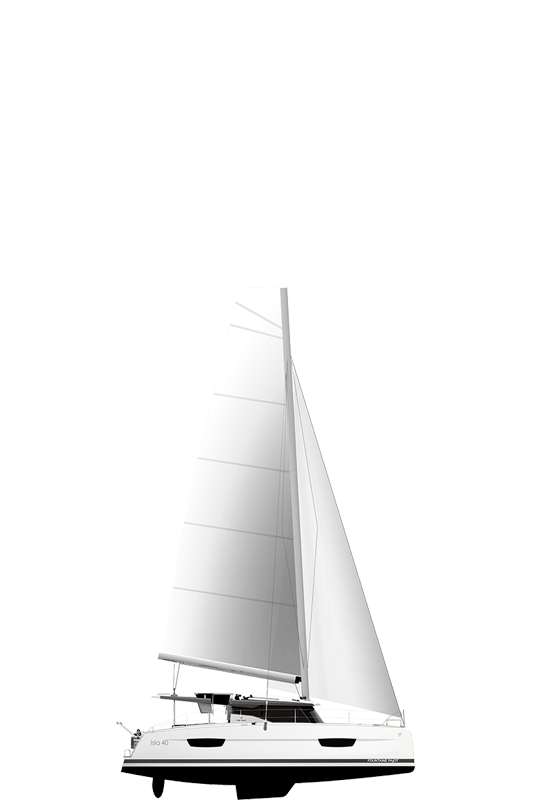
Explore our models in a different way thanks to the virtual marina
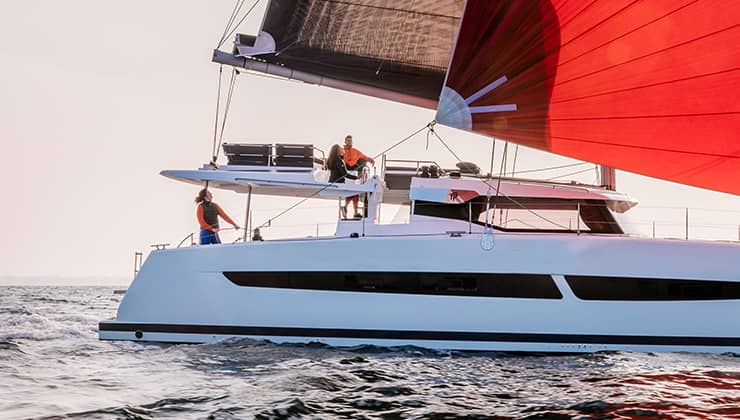
Efficiency through design
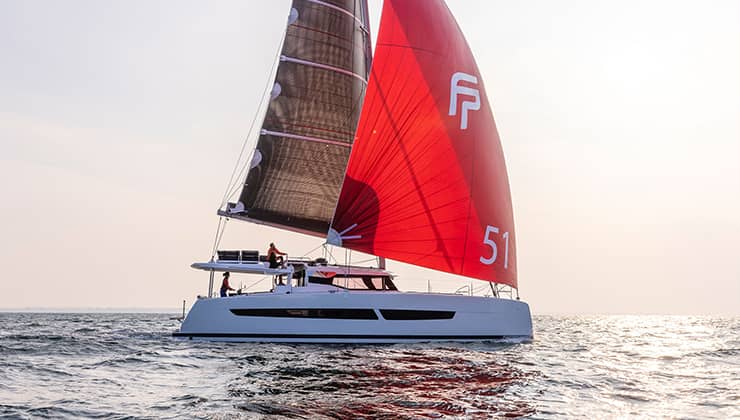
A feel for the sea: sailboats first and foremost
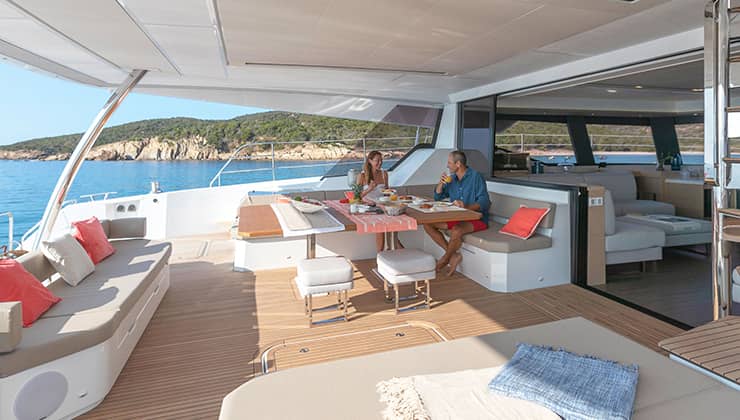
When volume transforms to real space
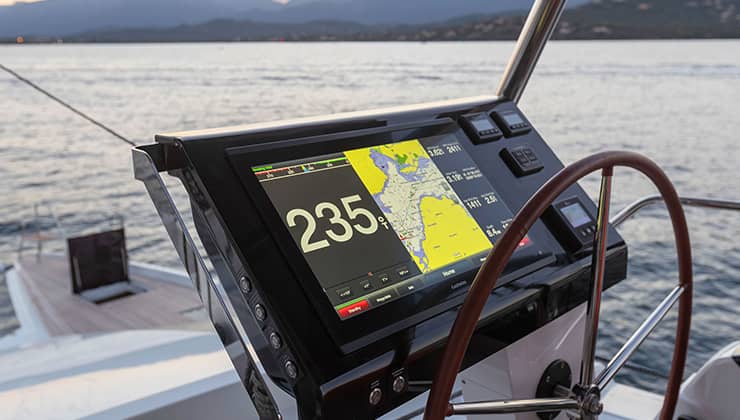
Innovation as a foundation
- Smart Electric
- Virtual marina
- Experiences
A circumnavigation sailing trip on a catamaran : a 1,546-day adventure across 27 countries
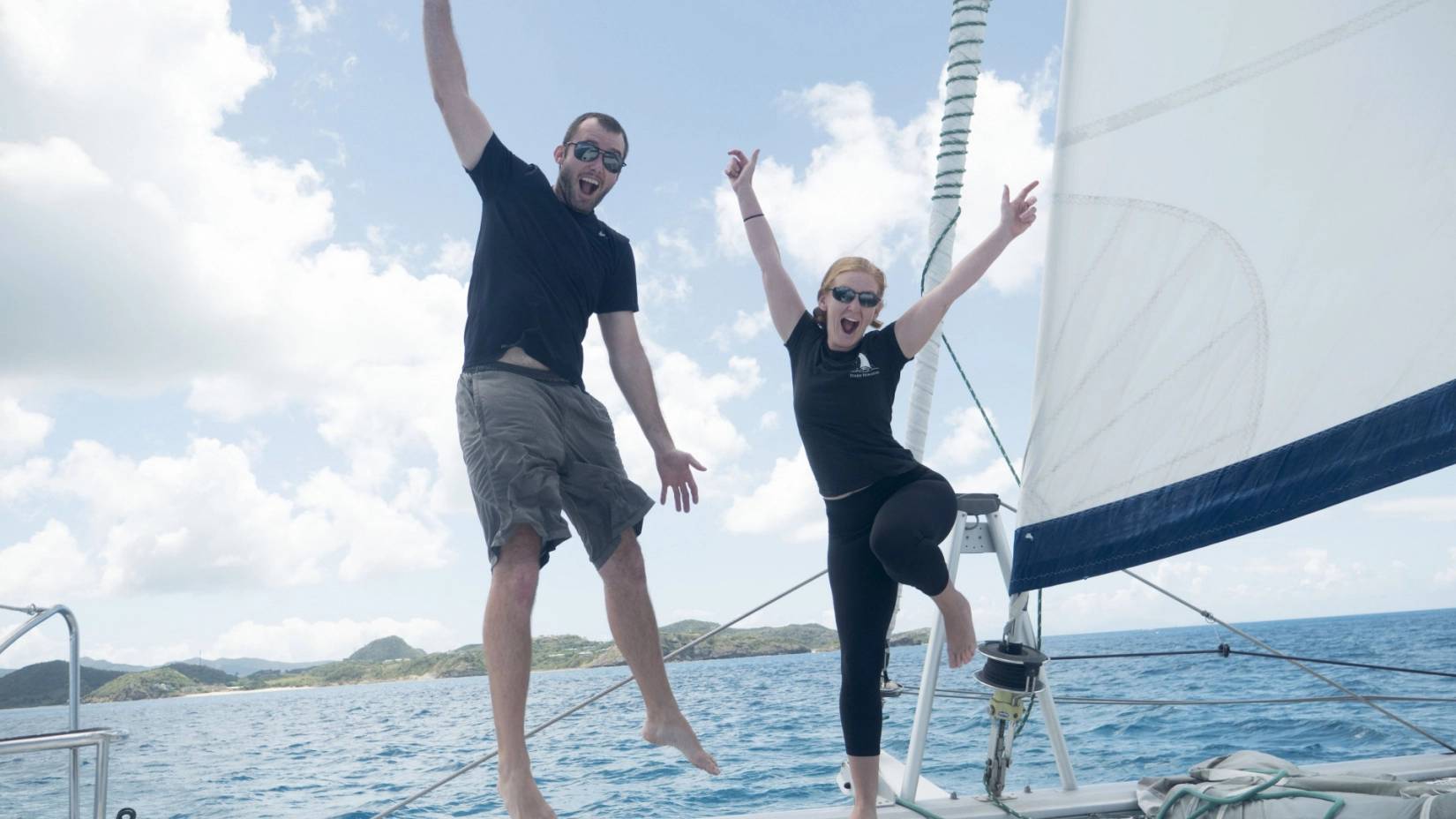
David and Amy
Round-the-world
Trip duration
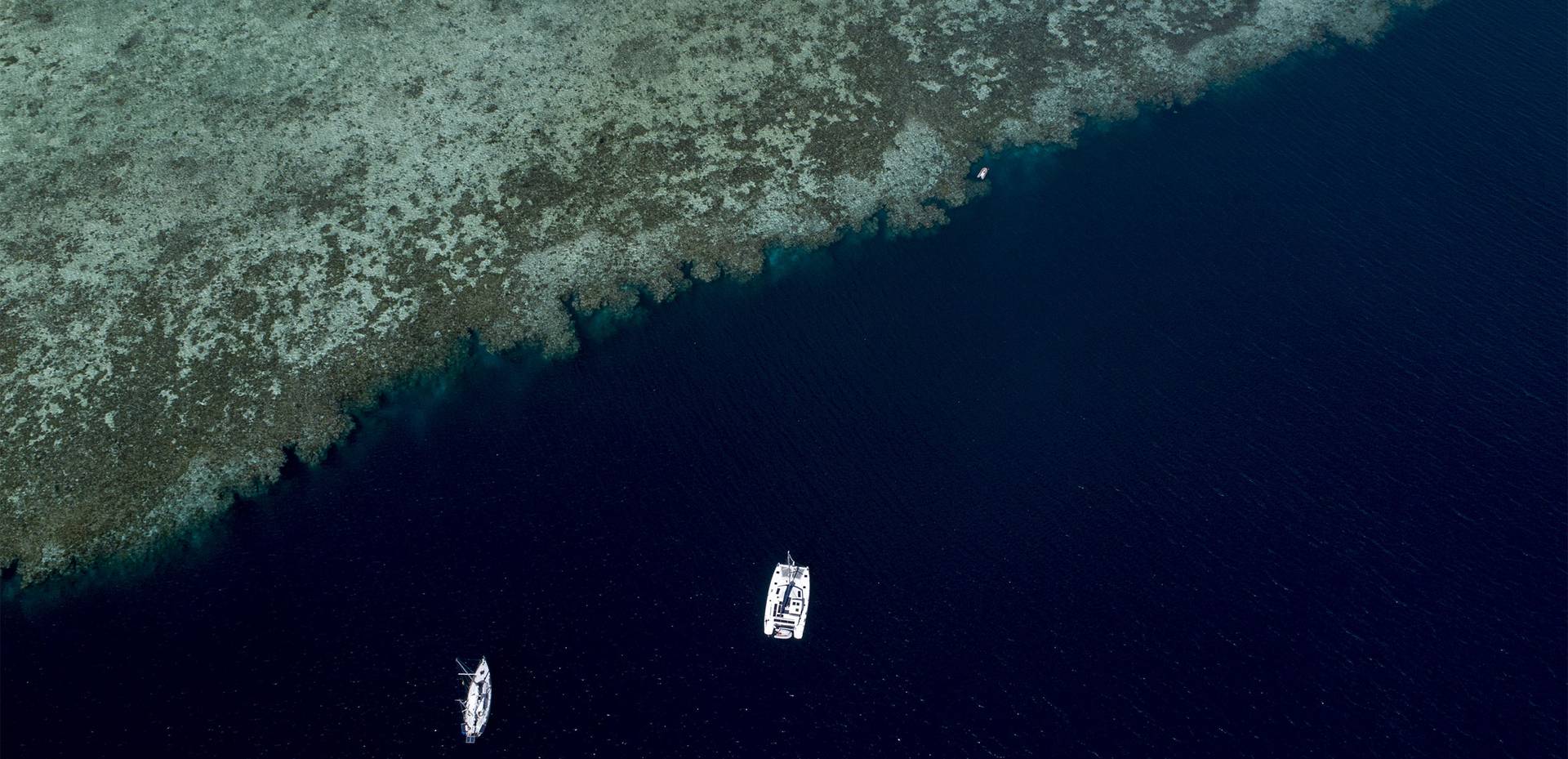
A round-the-world in 1,546 days
Onboard their Fountaine Pajot Hélia 44 “Starry Horizons”, the couple criss-crossed the seas and oceans for no less than 546 days, covering more than 34,140 nautical miles and 27 countries from the port of Antigua in the Caribbean, forming a loop around the equador.
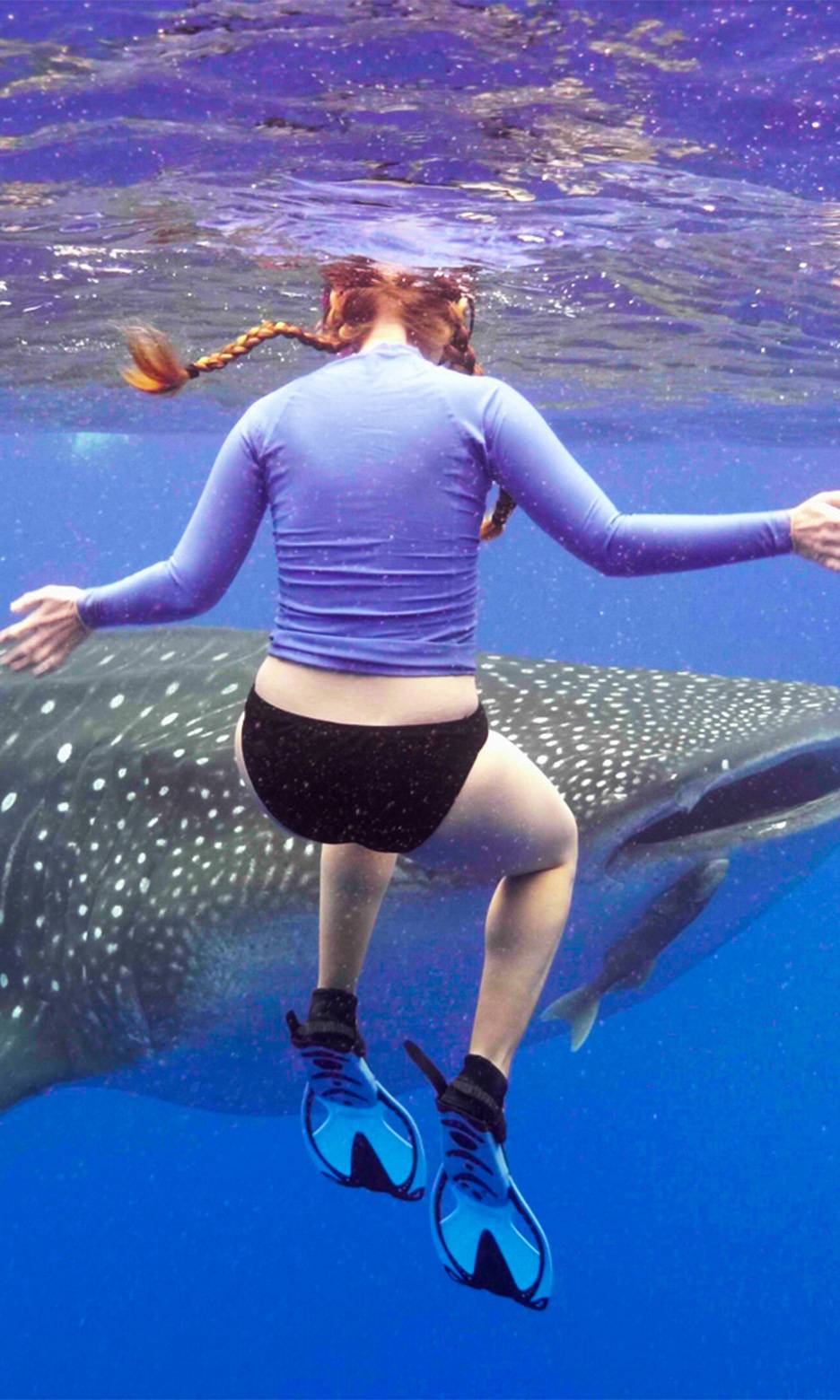
Presentation of the crew
“We are David and Amy Alton, two thirty-something-year-old Americans. When we met, Amy was an engineer and David was in the oil and gas industry in finance. While Amy had grown up around boats all her life, David had only been sailing once! Soon after we met, Amy took over the family business in the maritime industry.
Eventually, we both got our USCG 100 Ton Master’s licenses and David came to work for Amy driving her boats. This is why we call her the Admiral!”
Preparation for the circumnavigation
“Since we were both licensed captains and had been day sailing around Galveston Bay on our previous 30 feet catamaran, we had an advantage over cruisers who are starting from scratch. We did want to get more experience on bigger boats, so we chartered down in the Caribbean.
Of course, we read a lot of books, blogs, and magazines. There were hardly any sailing YouTube channels out at the time, so that wasn’t a big thing for us.”
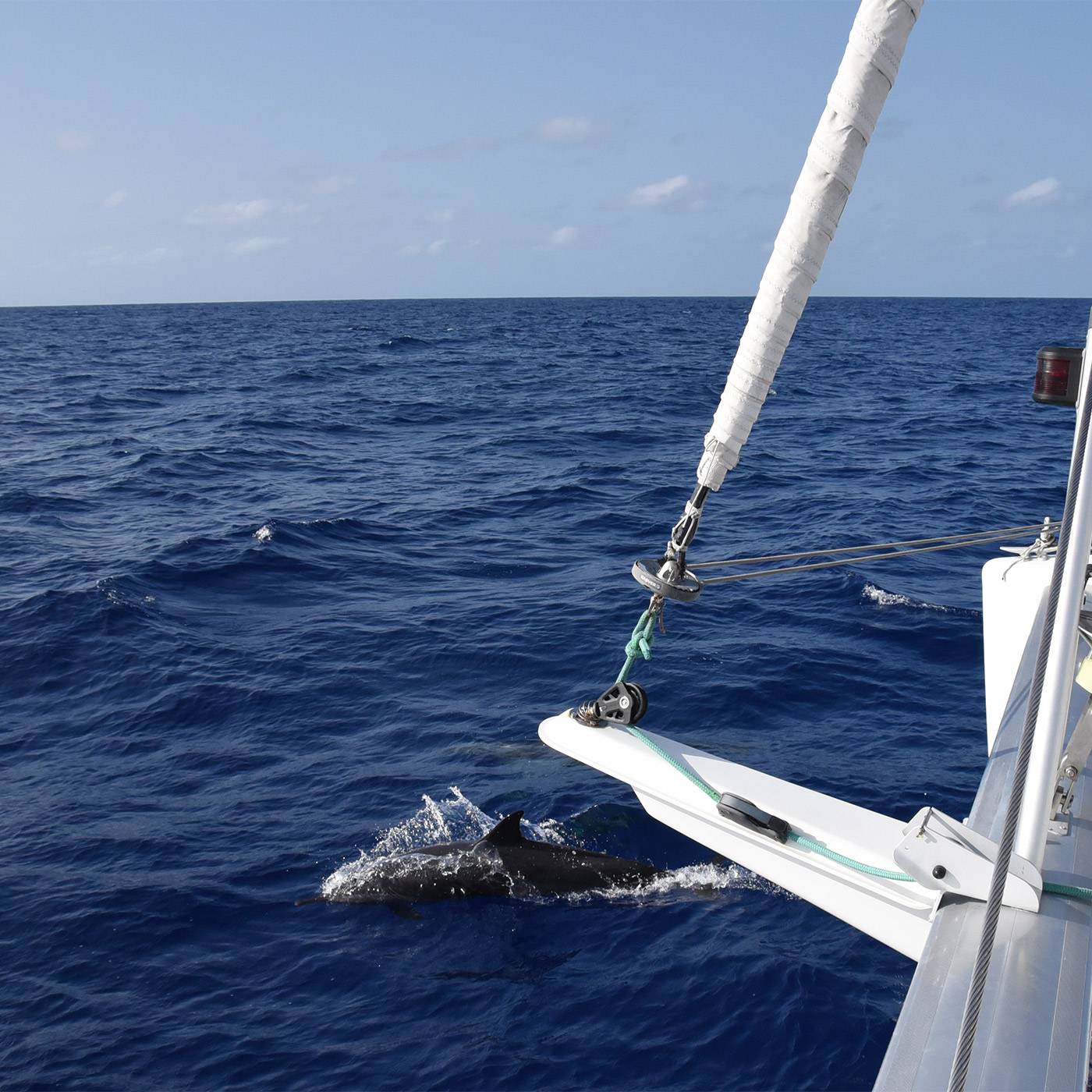
A cruise of more than 34,140 nautical miles
“We picked up our boat from the factory in La Rochelle in October of 2014. From there, we did a self-delivery, bringing the boat to Florida in three steps to do some outfitting to kit her out for a long-term cruising boat.
From Florida, we sailed the Bahamas, then up to Nova Scotia and Maine before heading down to the Caribbean. Three months later, we passed through the Panama Canal and spent two seasons in the South Pacific.
After seven months in Australia, we sailed up through Southeast Asia, then across the Indian Ocean, exploring lots of remote islands. In December of 2019, we passed the Cape of Good Hope in South Africa, and in March of 2020, we docked in Antigua, crossing our wake and completing our world circumnavigation. “
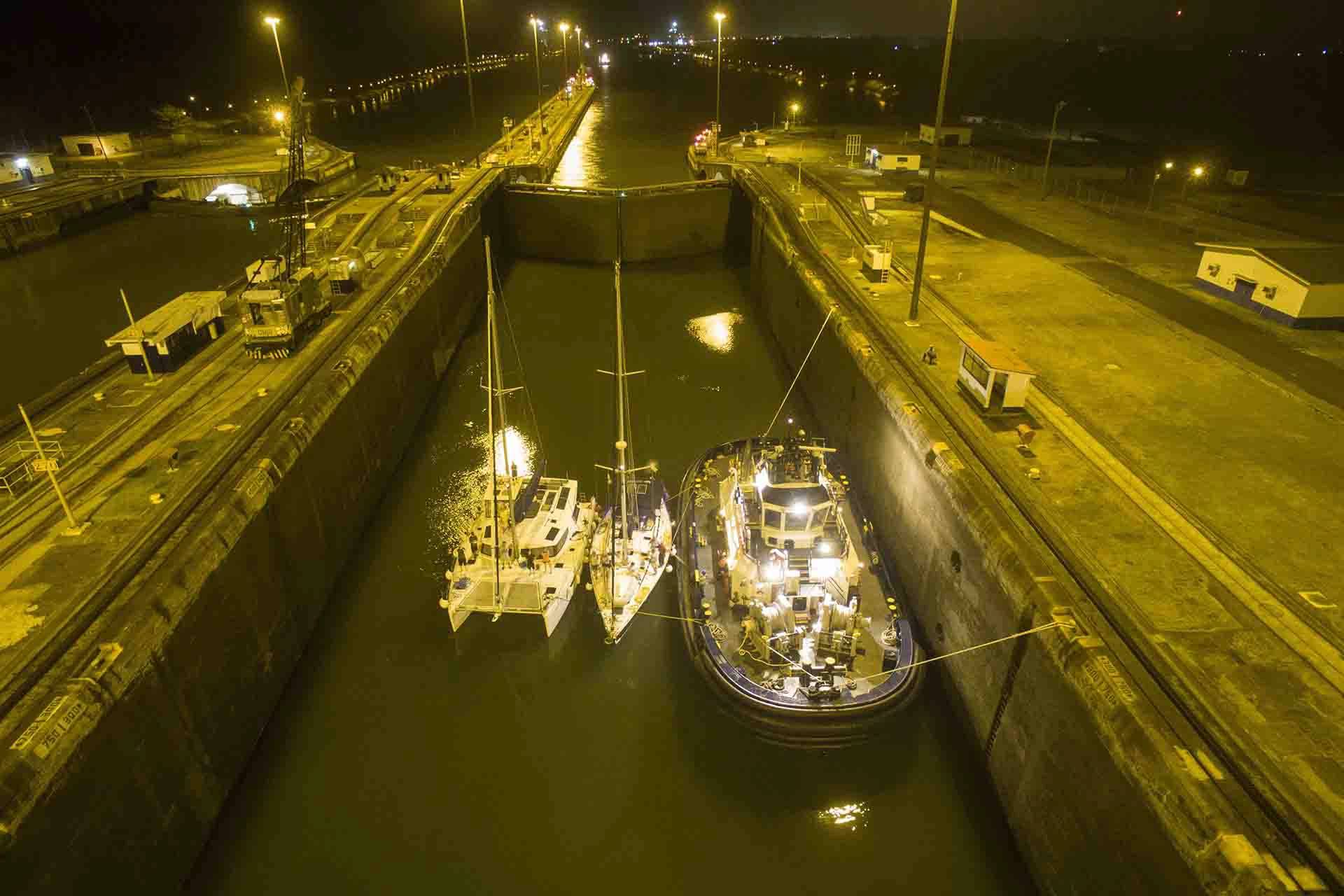
Favorite sailing areas
“The South Pacific is easily our favorite sailing ground. The islands are remote and incredibly beautiful, and the people are amazingly friendly. French Polynesia is a dream destination, with rugged islands in the Marquesas, or idyllic atolls in the Tuamotus. Bora Bora exceeded expectations with crystal clear water and manta rays.”
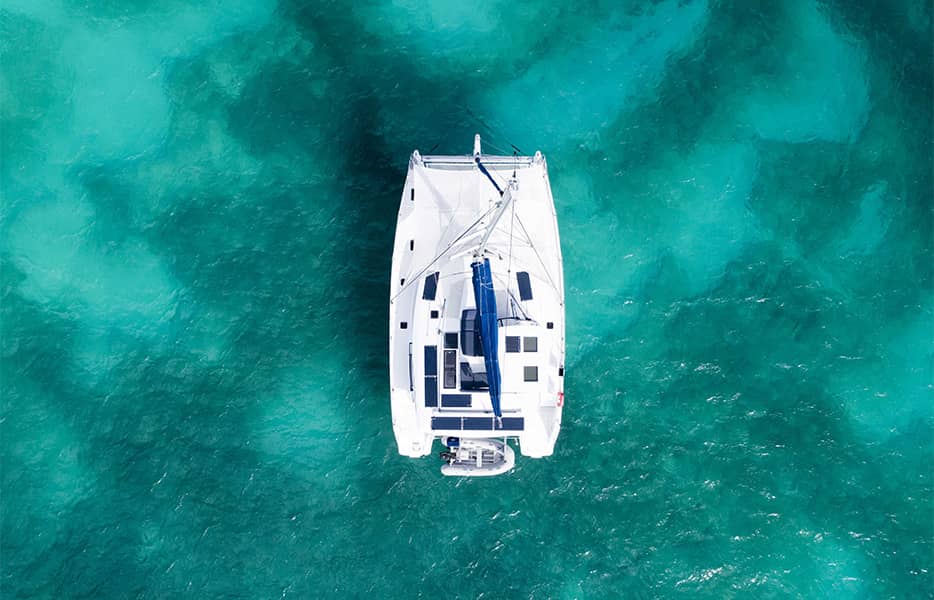
Choosing the right catamaran for a circumnavigation
“When we were boat shopping, we had a list of requirements that we wanted. We did primarily look at the biggest production yards because we wanted to keep a strong resale value and yards like Fountaine Pajot have a good reputation – they’ve been building great boats for so long.
We went to the Annapolis Boat Show with a few models in mind, and when we got on the Helia is was an easy decision. The layout of the boat is amazing, and while she’s got plenty of space, she is definitely on the faster side for cruising boats.
All around the world we have meet Fountaine Pajots of all ages and sizes. Starry Horizons has held up very well in the nearly six years we have owned her, so we’ve been very pleased with our purchase.”
Circumnavigate on a catamaran
“On our entire circumnavigation, we spent less than 13% of our nights at sea. This means that 87% of the time we were stationary, at anchor or in a marina, taking advantage of the space our catamaran offered us.
Moreover, when we were sailing, we were mainly sailing downwind. Although we didn’t have much experience with monohulls, many friends complained about the performance of their boat downwind. Starry Horizons is super comfortable downwind.
It is also extremely performant and very safe, we always had confidence in our boat, even when the sea was rough, in squalls or tropical storms.”
Next adventures
“Right now, Starry Horizons is taking a well-deserved rest on the hard for hurricane season. We are back in Texas visiting our families.
We will launch again sometime within the next twelve months and cruise close to home; the Bahamas, Chesapeake Bay, or other nearby places. After that, we don’t have any plans!”
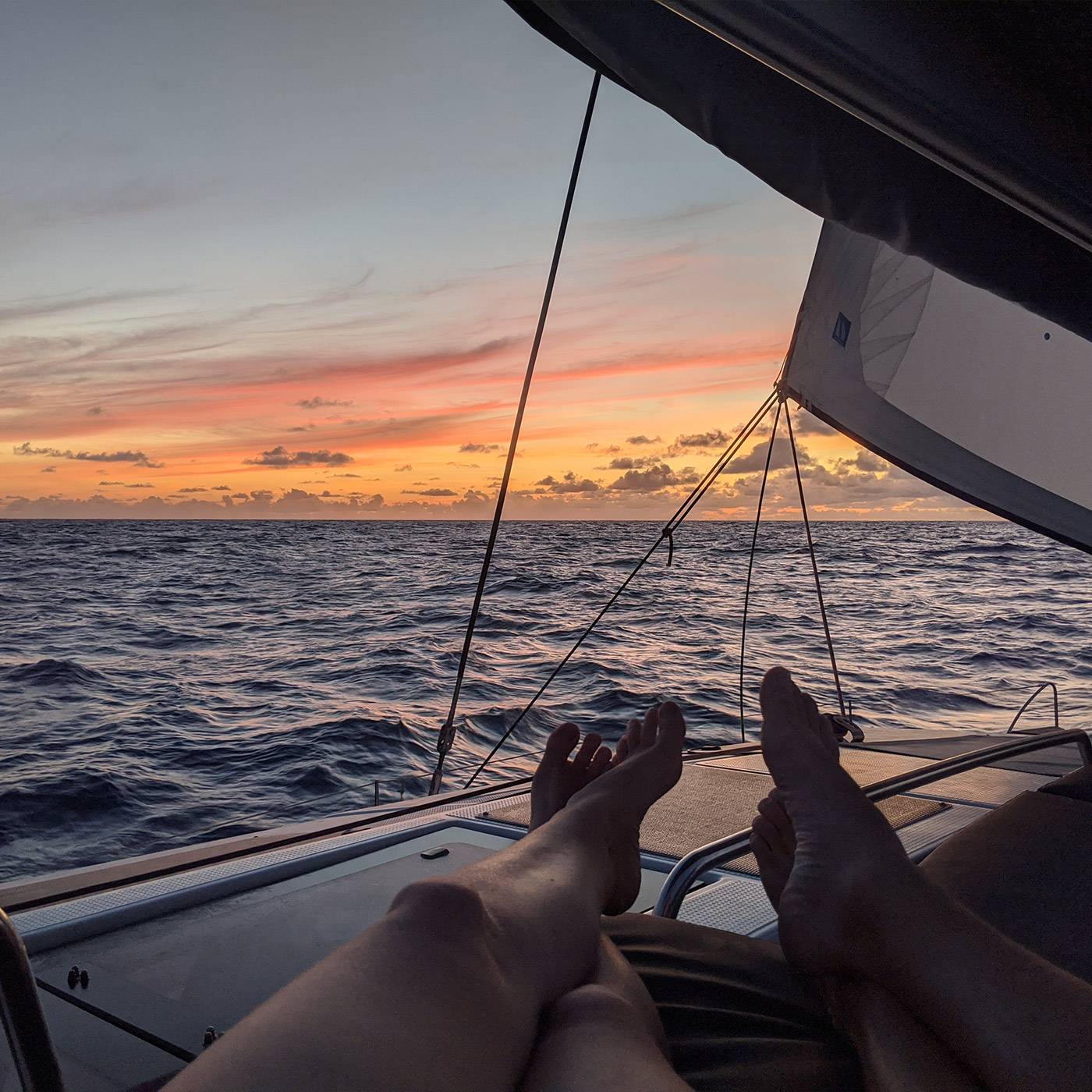
David and Amy regularly share tips and surprising anecdotes on their blog to accompany you in your navigations, the preparation for long cruises or simply to share their most beautiful sailing experiences and anchorages.
Starry horizons’ circumnavigation in a nutshell
- Leaving Antigua on December 30, 2015
- 10 navigations au long courslong-range navogations (1,000+ nm)
- 1,546 sailing days
- 4 crossings of the equator
- 22 nautical miles/day in average
- 34,140 nautical miles travelled
- 6 hauls out
- 27 countries and territories crossed
- 7 home returns
- 93.5% of the miles sailed as. a duo
- Arrival in Antigua on March 26, 2020
Subscribe to the newsletter
Follow the adventures of Fountaine Pajot Owners, discover the latest news and upcoming events, and take part in the development of the Boat of tomorrow!
Compare models
Catamaran Isla 40
Catamaran Astréa 42

Hosting capacity
Motorisation
Technical information
User-friendly areas
Sunbathing Non
Kitchen Non
Sunbathing Oui
Discover the prices
Double rooms
Your contact details
One last step before reaching the next page & discovering the prices proposed & main options for this version! You'll then be able, to schedule a live chat with your local dealer to discuss all the options and configurations available for this model!
Your home port
Any questions?
No pack information currently available online for this Flagship model. We will get back to you directly. Thank you
Would you like to configure this model’s options or set up another model?
Make an appointment with your nearest dealer and choose the boat of your dreams.
- BOAT OF THE YEAR
- Newsletters
- Sailboat Reviews
- Boating Safety
- Sails and Rigging
- Maintenance
- Sailing Totem
- Sailor & Galley
- Living Aboard
- Destinations
- Gear & Electronics
- Charter Resources

Best Cruising Catamarans
- By Cruising World Editors
- Updated: July 1, 2021
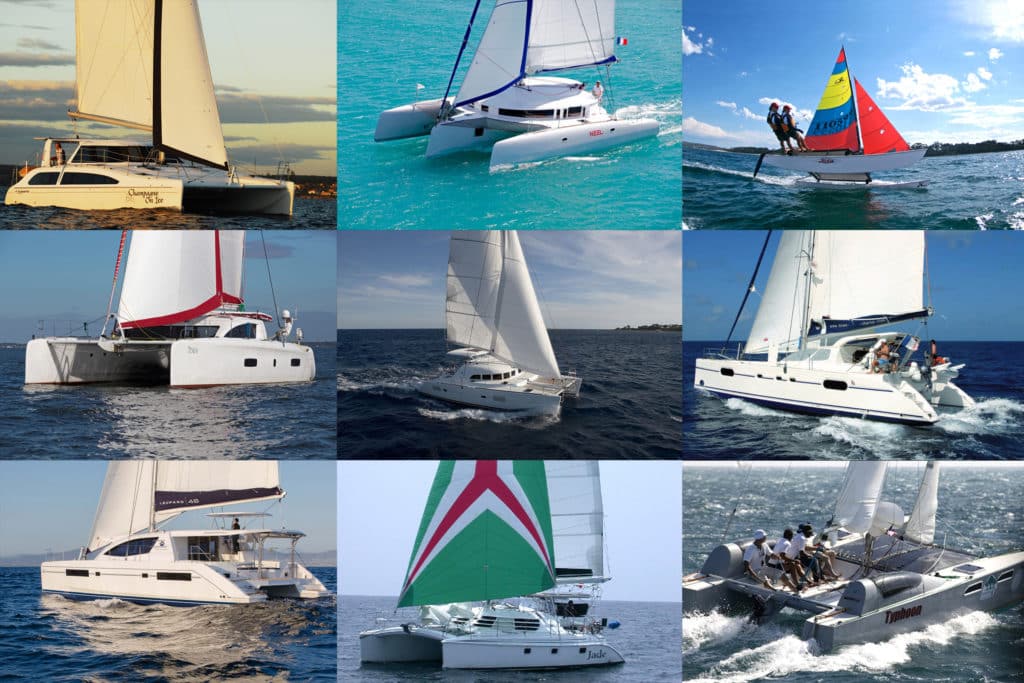
Cruising catamarans have been around for decades, but early models—often plywood and fiberglass vessels built by their owners from plans and kits, kept the boats on the fringes of mainstream sailing. That all changed, though, as big roomy cats were discovered by sailors who went off to charter in the Caribbean, where the multihulls proved their worth as comfortable liveaboard and party boats.
Today’s bluewater catamarans roam the globe, carrying families to exotic destinations across the Pacific and beyond. Just as with their monohull cousins, there is no best catamaran. Instead there is a wide variety of designs, ranging from small catamarans that offer the ease of maintenance a couple might enjoy to performance catamarans capable of easily knocking off 250-mile days. Today, the best catamaran brands offer a range of size models and layouts that can be optimized for an owner sailing with family and friends, or for the charter market, where there’s a demand for four, five and even six cabins worth of accommodations.
The most prolific catamaran manufacturers are in France and South Africa where yards include both large-run production builders and niche companies building fewer than 10 boats a year.
The best cruising catamarans offer good load-carrying ability and respectable performance. As with any sailboat , a modern catamaran’s design is a result of compromises. Daggerboards or keels? Galley up or galley down? Spacious owner’s cabin or extra bunks? There are lots of options to choose from—and that’s what makes looking at these sailboats fun!
Here, then is an eclectic A to Z list of some of the best catamarans that have helped shaped the evolution of how we live and sail on two hulls.
Antares 44i
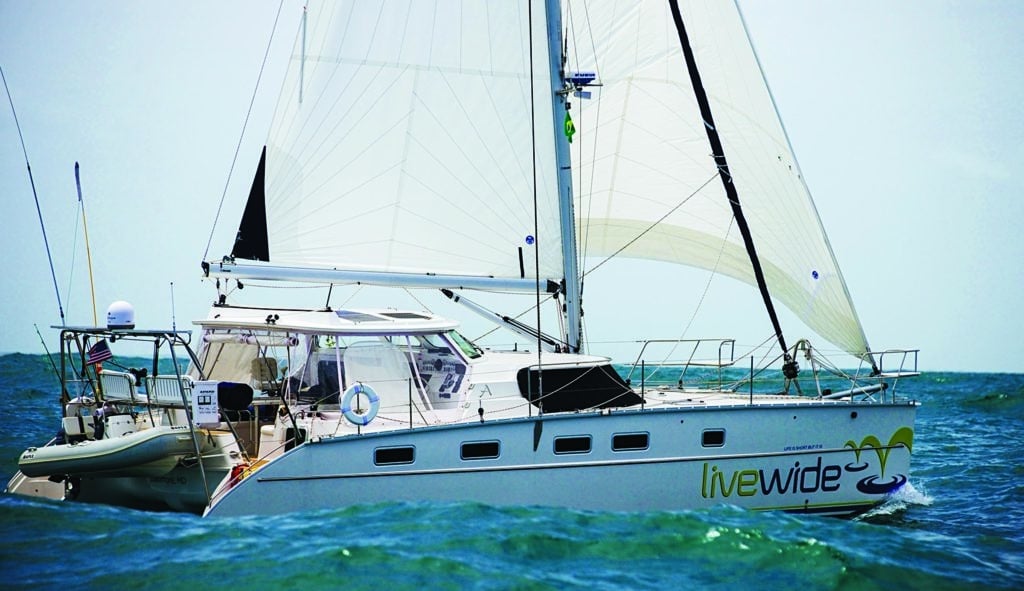
Now built in Argentina as a full-fledged, bluewater catamaran and cruiser that can be safely operated by a shorthanded couple or family crew, the Antares 44i features a fully covered cockpit with a quartet of big, standard solar panels recessed within the hardtop, one example of a yacht capable of long-range passagemaking.
Atlantic 42
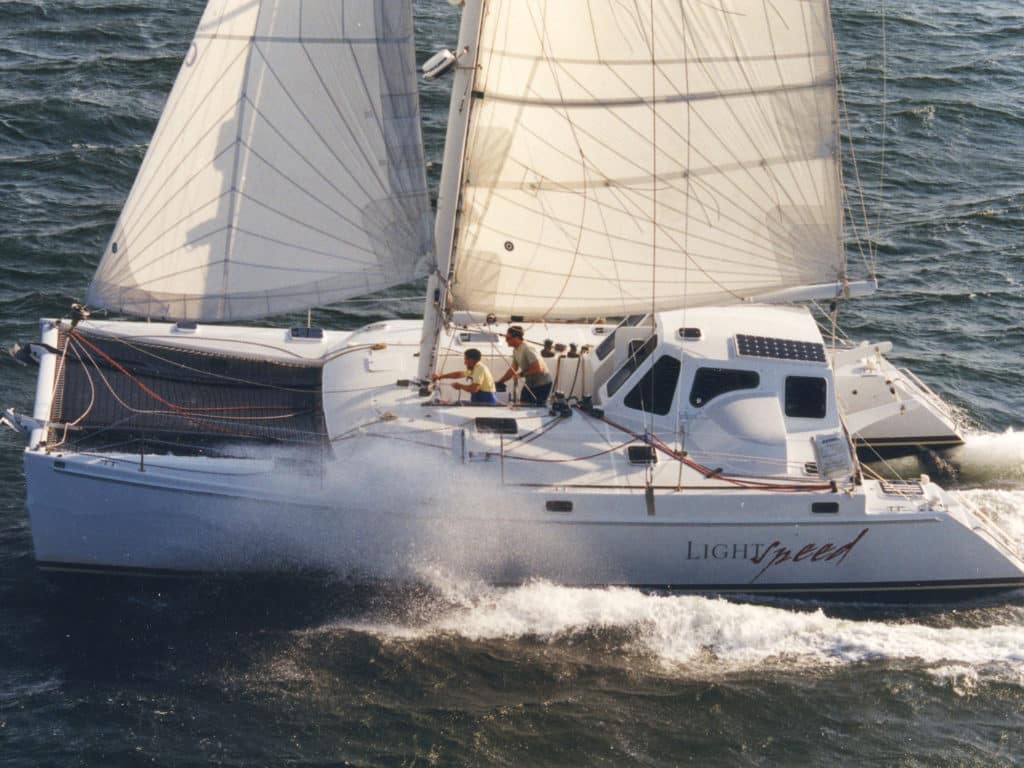
Almost 30 years ago, yacht designer Chris White revolutionized catamaran design with the first in his series of Atlantic cats, the primary feature of which was the innovative mid-ship sailing cockpit forward of the main cabin. The smallest in the Atlantic line, the 42 remains White’s most popular design ever.
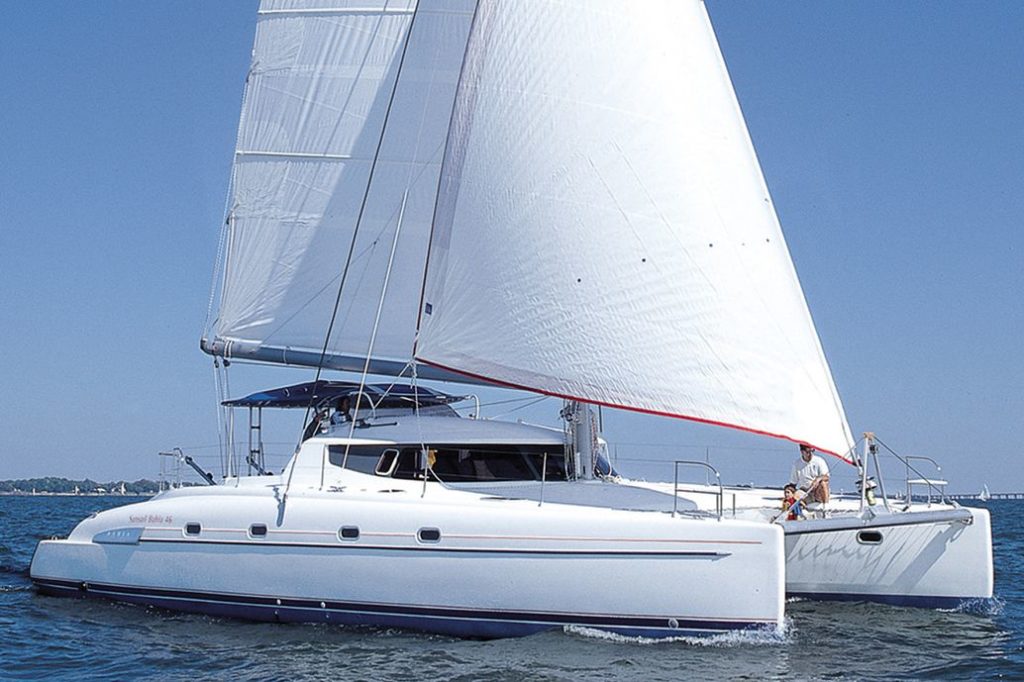
Fountaine-Pajot has built so many outstanding cruising catamarans that it’s difficult to narrow down any single boat, but we’ve always been fans of the good-looking, well-thought-out Bahia 46. At 46 feet, the boat is large enough for offshore forays and has plenty of volume; with its simple but powerful sail plan, it’s also an excellent performer.
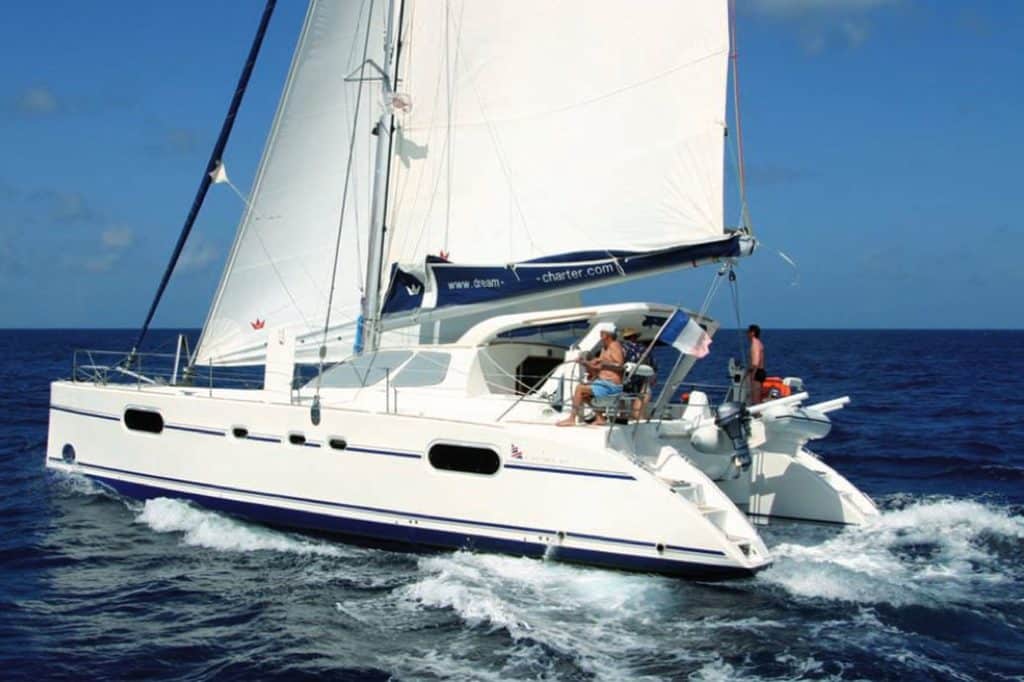
Beginning around 1996, the French builder Catana was one of the first companies to manufacture fully found cruising cats for private ownership, and this Christophe Barreau design, which enjoyed a nearly 10-year production run from 1997-2006, was emblematic of this first generation of safe, fun, long-legged offshore voyagers.
Click here to see more cats from Catana.
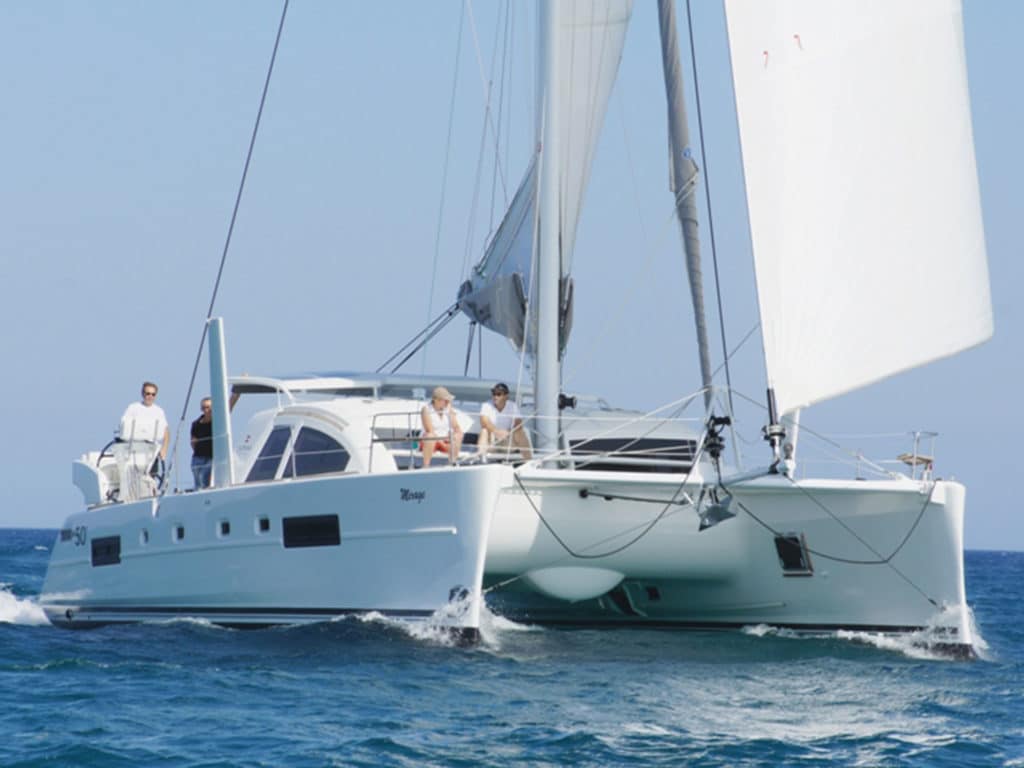
When it comes to speed, light boats are fast ones. And if you wish to save weight, that means exotic modern materials like carbon. Catana now infuses the laminates of their entire production line with carbon fiber, and for this list, we’ve chosen the Catana 50 Carbon, one of the zippiest cats now crossing oceans.
Click here to read about a couple’s charter aboard a Catana 50.
Gemini 105M
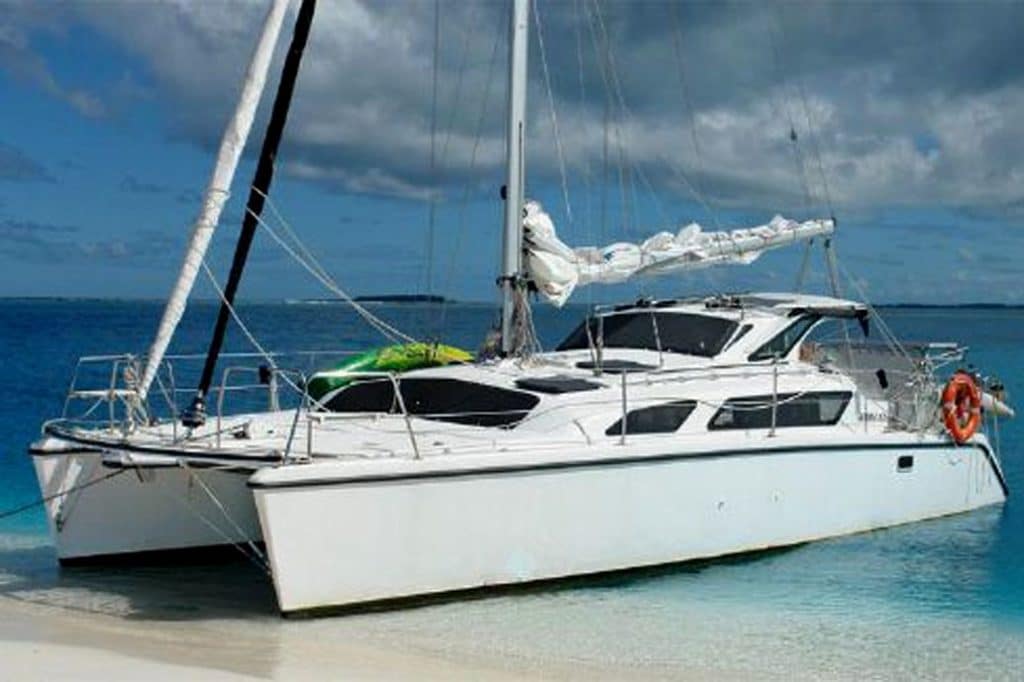
Pioneering catamaran sailor, builder and designer Tony Smith launched the first of his 33-foot Gemini 105M’s (10.5 meters = 33′) in 1993, and soon after found a ready and willing stream of sailors enamored of the boat’s compact size, affordable price tag, and such innovations as the nifty lifting rudder and transom steps.
Click here to read about the Gemini Legacy 35.
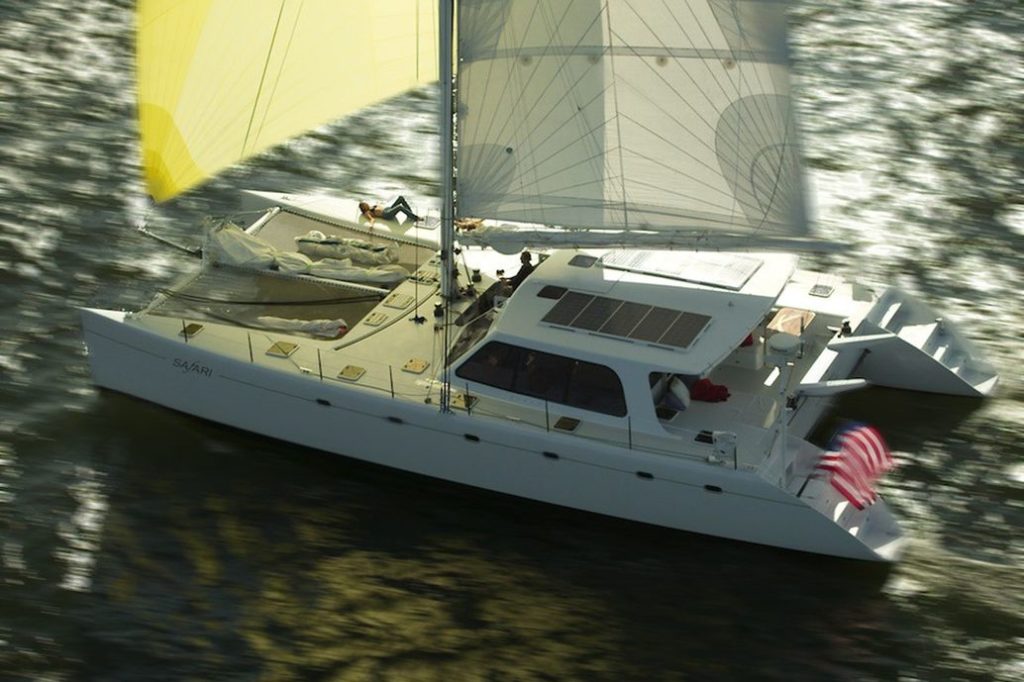
Built between 2000-2005, the Gunboat 62 firmly established the Gunboat brand: go-anywhere cats that applied race-boat technology to a world-cruising platform. Hull no. 1, Tribe, was built for company founder Peter Johnstone, who then spent a year-and-a-half cruising with his family, smiling all the way.
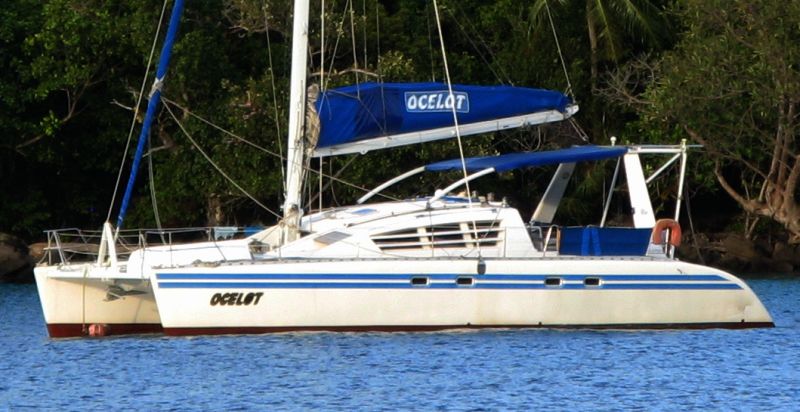
French builder Henri Wauquiez is best known for his long career building monohulls, but the Kronos 45 cat, which he launched in 1992, was ahead of her time. Classic lines, the aft “targa bar” over the cockpit, the louvered coach roof windows, even the distinctive stripes on her hull: the Kronos 45 remains timeless.
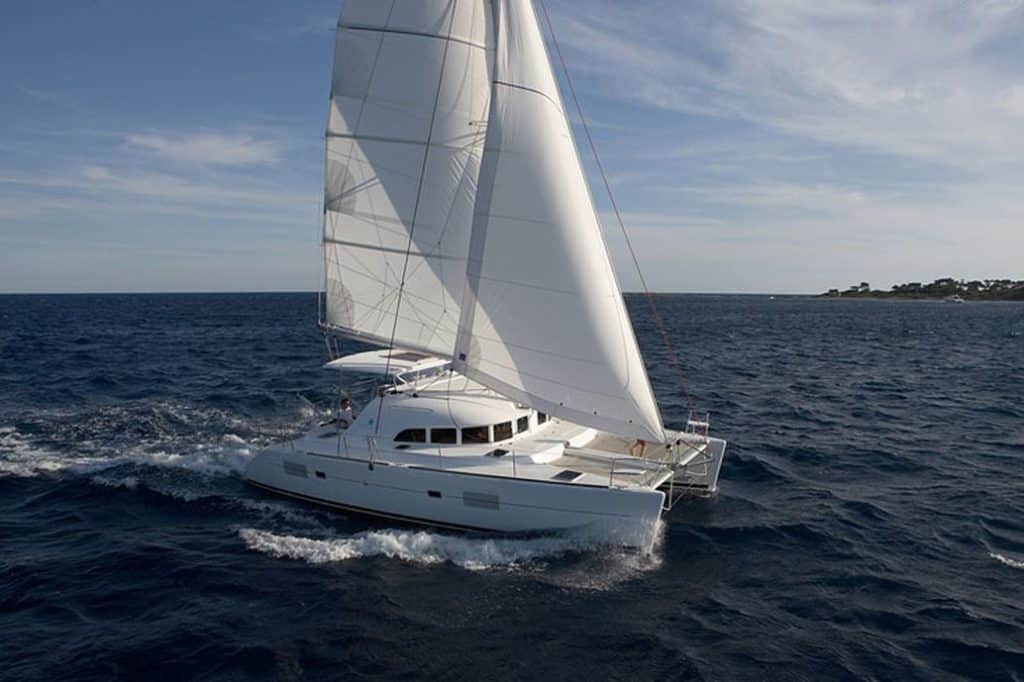
No roundup of cruising cats would be complete without several Lagoon entries, and the best of that impressive bunch might well be the Lagoon 380. Originally launched in 1999, and revered for its combination of quality, volume and performance, with over 740 boats built the 380 is still going strong.
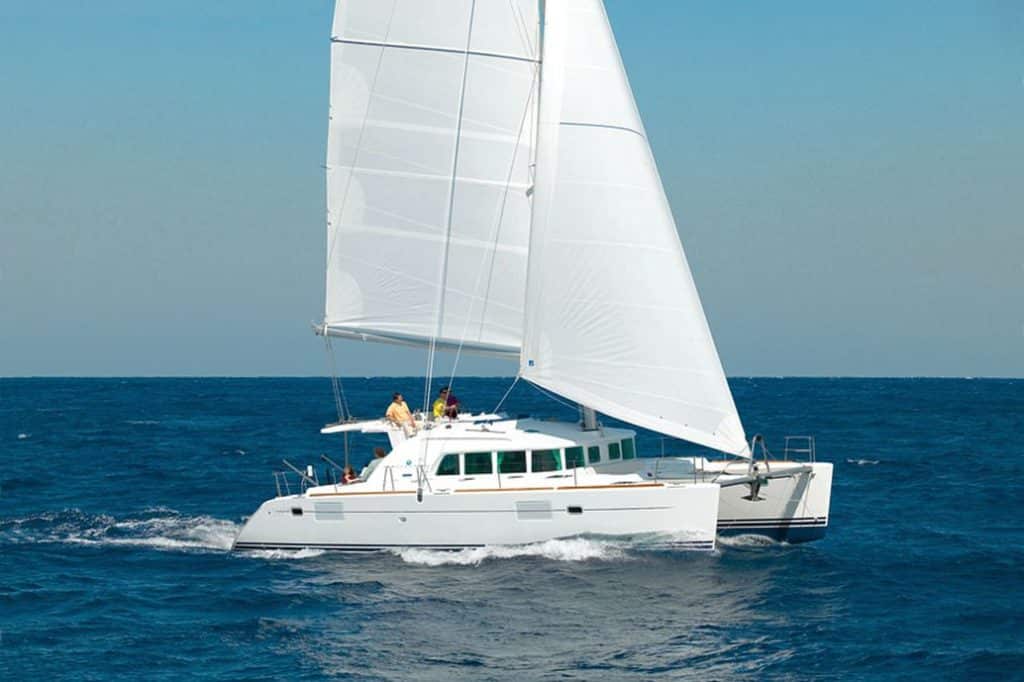
Launched five years after the breakthrough 380, the Lagoon 440 was an evolutionary design that featured a raised flybridge helm station, a unique “gullwing” configuration below the bridge deck, expanded windows in the hull and much more. With 400 boats built in a 6-year production run, the 440 was an unqualified success.
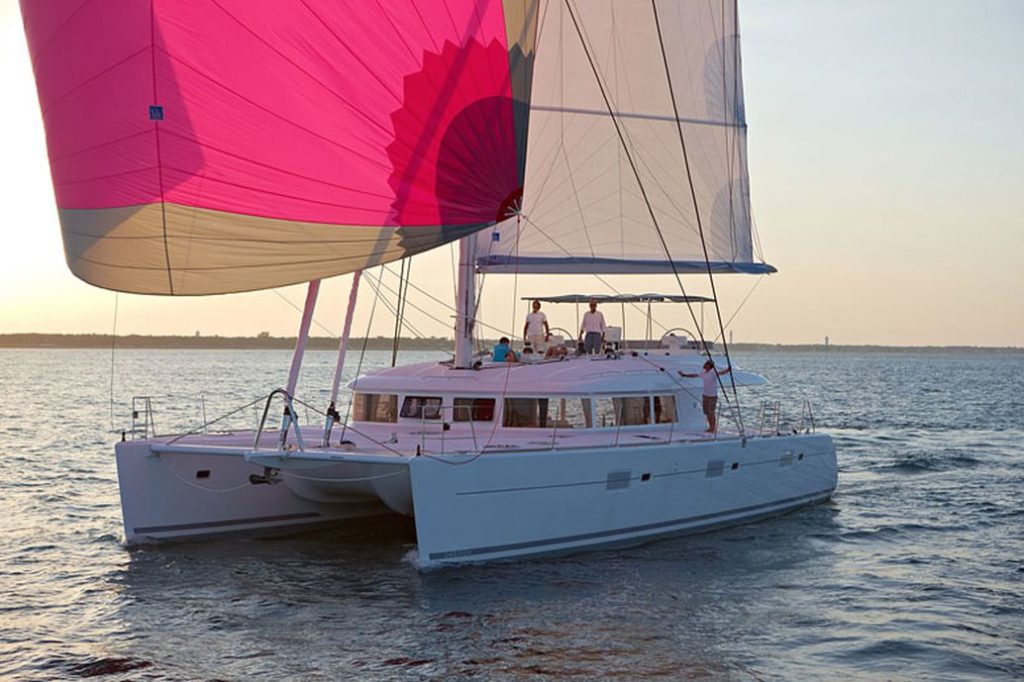
How big can a production cat, still operable by a short-handed crew, really be? The builders at Lagoon discovered that 62-feet hit a sweet spot in the marketplace, and have sold over 70 boats since its introduction in 2010. The centerpiece of this design is the sensational steering station atop the flybridge, with expansive views of the sea and sky.
Click here to see more cats from Lagoon.
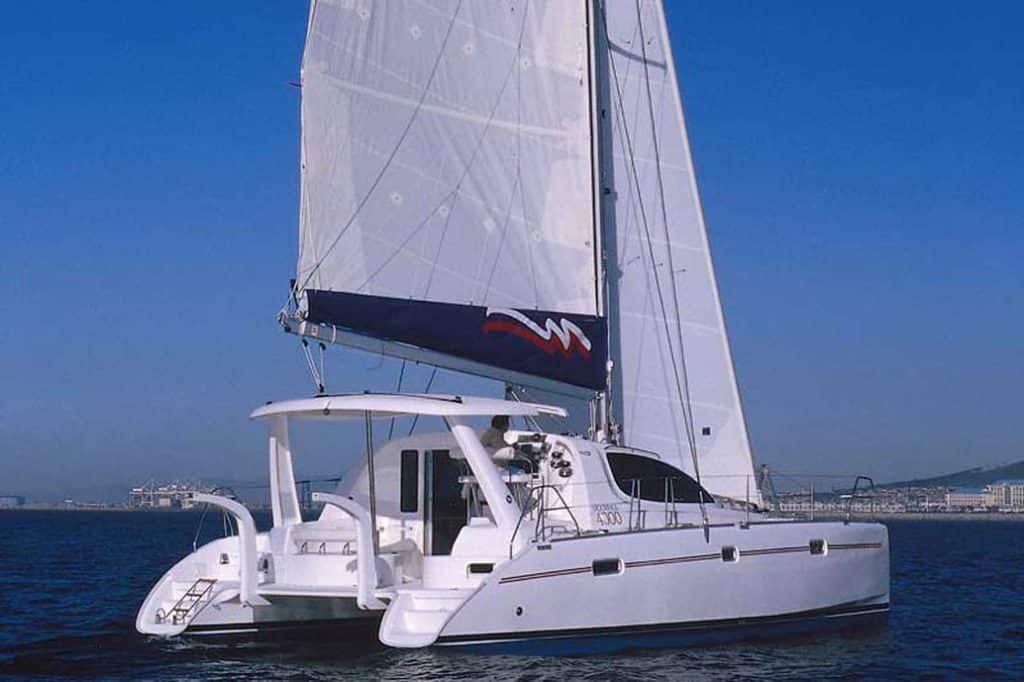
With an unmatched pedigree – designed by premier multihull naval architects Gino Morelli and Pete Melvin, built by the prestigious Robertson & Caine boatyard in South Africa, and commissioned by chartering giant The Moorings – the Leopard 40 was, perhaps unsurprisingly, Cruising World ’s Import Boat of the Year in 2005.
Louisiane 37
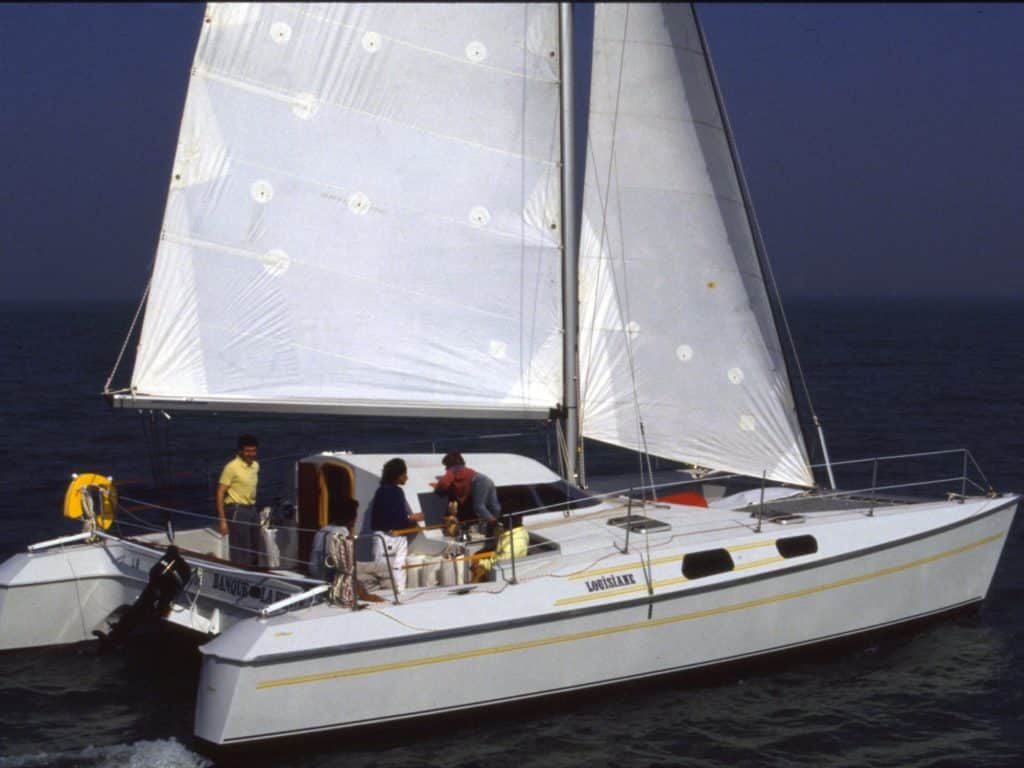
Based on the famous French racing cat Charente-Maritime, the Louisiane 37, designed by Joubert/Nivelt and launched by builder Fountaine-Pajot in 1983, was a light, fast liveaboard cruiser with full accommodations that represented a radical departure from the hefty British cats that preceded it.
Maine Cat 30
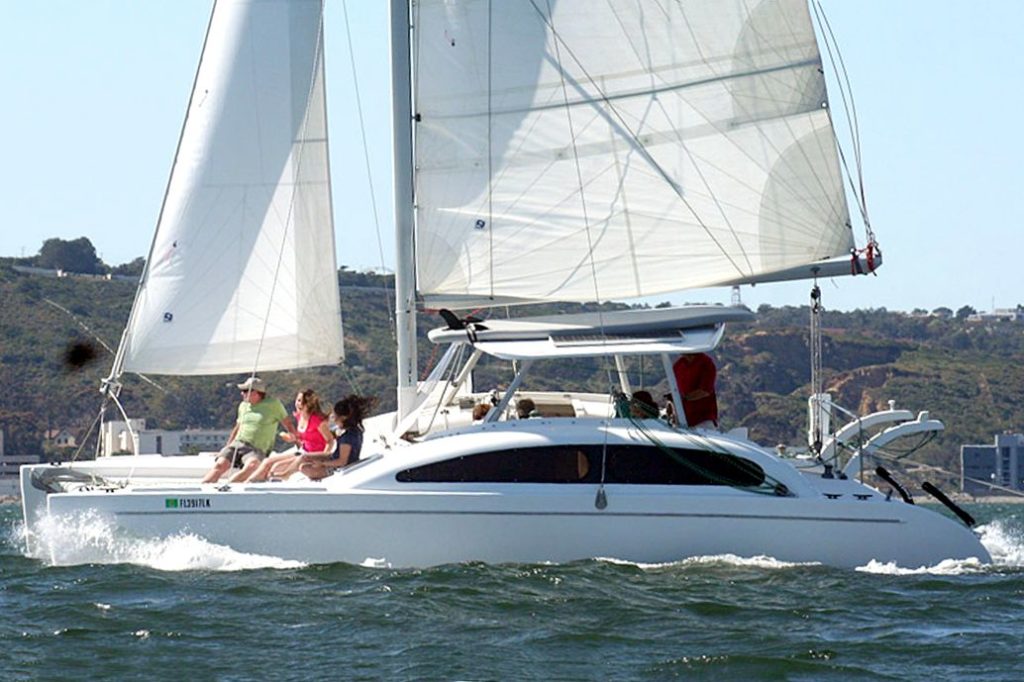
One of the more versatile and clever cats ever created, the central feature of the cool Maine Cat 30 is the open bridge deck/living room sandwiched between the hulls and canopied by a rigid, permanent hard top (the comfortable accommodations/ staterooms are stationed in the hulls). Ideal for a winter in the Bahamas but with the ability to sail offshore, it’s a boat for all seasons and reasons.
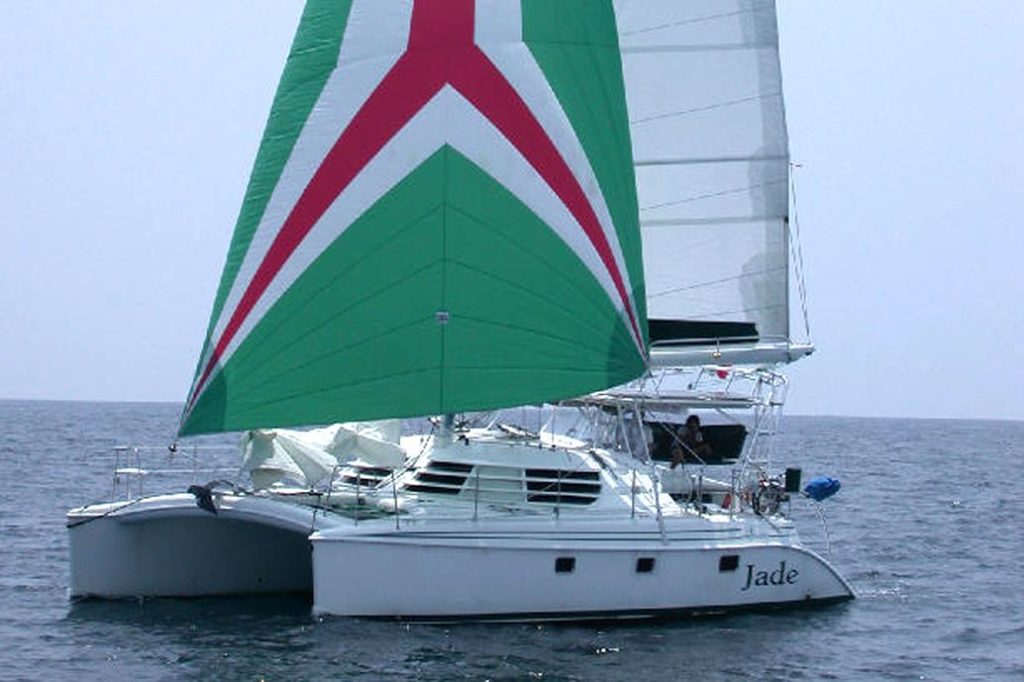
Built in Florida and beloved by the owners of the over 120 boats built during the company’s existence from 1993 to 2009, the Manta Catamarans range included 38-, 40- and 44-foot cats. For this exercise, however, we’re heralding the original Manta 42, which won the Best Value Overall prize in CW’s 2001 Boat of the Year contest.
Moorings 4800/Leopard 48
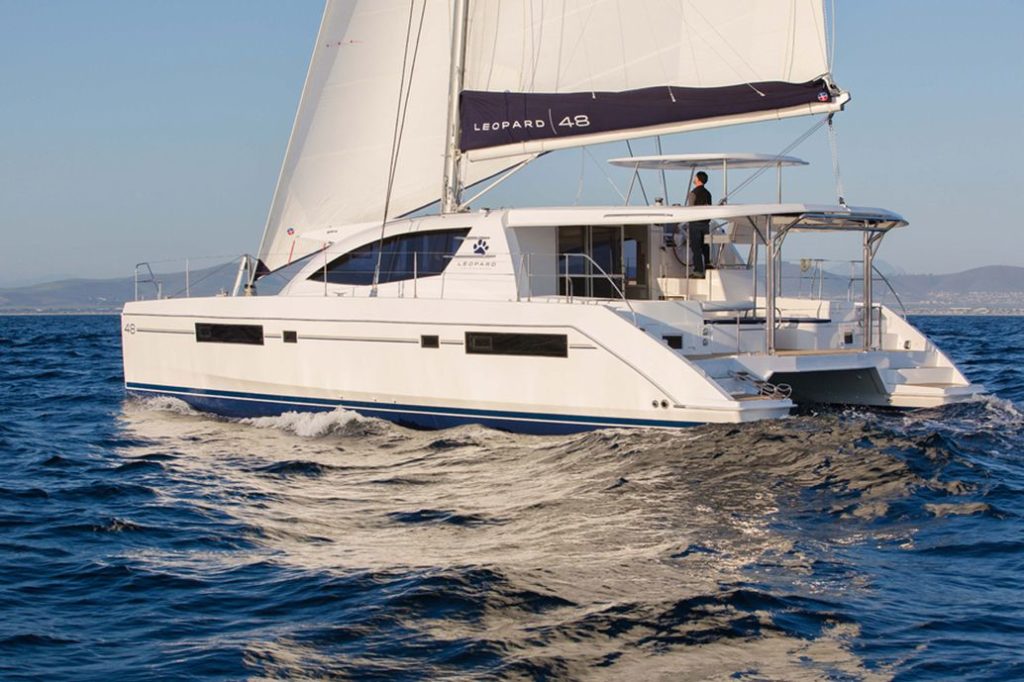
Another Leopard/Moorings collaboration built by the wizards at Robertson & Caine (though this boat was designed by fellow South African Alex Simonis), the Leopard 48 was another CW Boat of the Year winner with all the contemporary bells and whistles: forward cockpit, flybridge helm station and solid hardtop dodger, just to name a few.
Click here to read more about the Leopard 48, and click here to see more images.
Nautitech 441
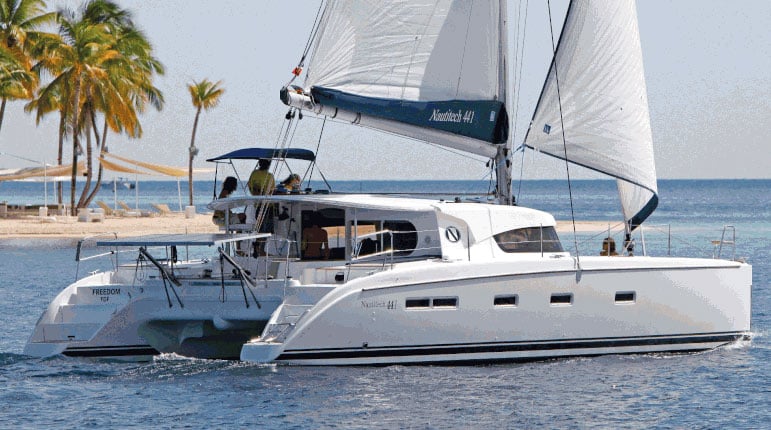
The Best Multihull Under 45 Feet: So said the CW judging panel in the 2013 Boat of the Year competition, regarding the Nautitech 441. But what makes this versatile platform so intriguing are the different helm set-ups. The 441 employs a single wheel, to starboard, ideal for solo sailors, while the 442 has a pair of helm stations aft.
Click here to see more Nautitech Catamarans.
Outremer 5X
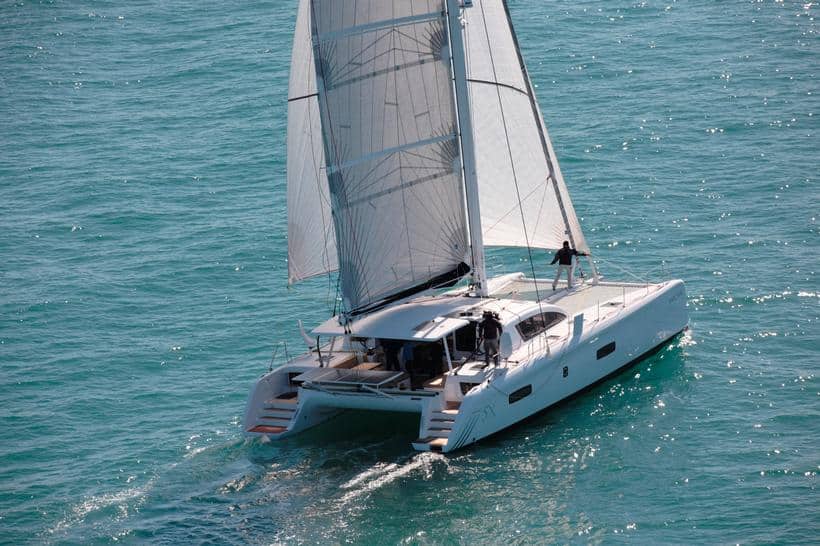
A state-of-the-art all-oceans cat that exemplifies how far multihull design has come, the 59-foot Outremer 5X was a winner on both sides of the Atlantic, taking top honors in the European Boat of the Year competition in 2013, and following up as the Best Full-Size Multihull in CW ’s contest a year later.
Click here to see more cats from Outremer.
St. Francis 50
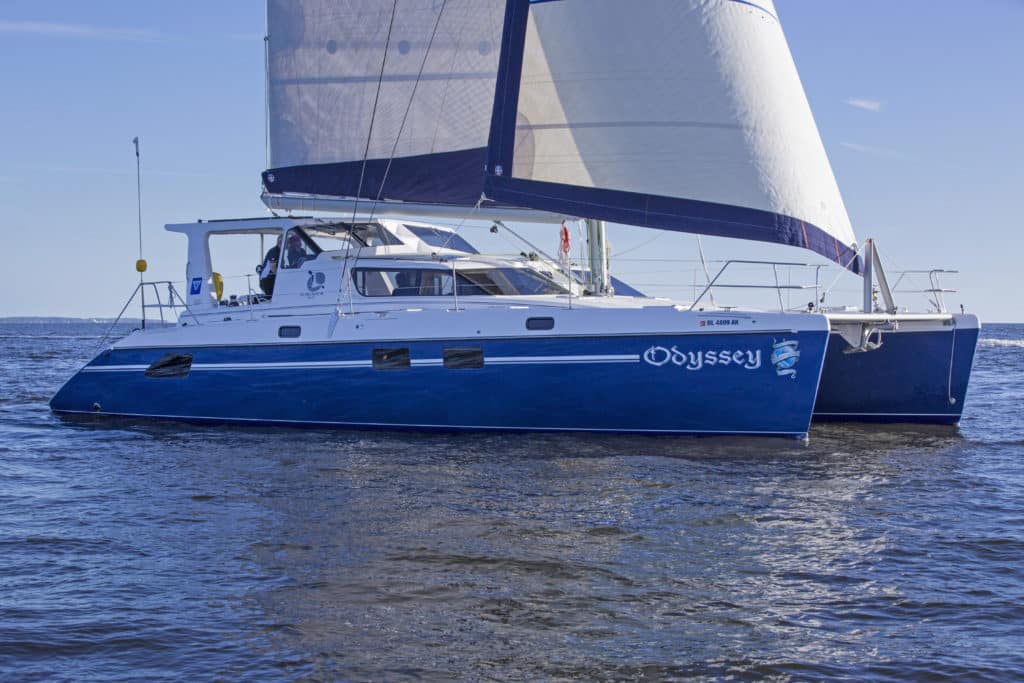
The flagship of the proud St. Francis line – built in South Africa since 1990 to designs by local legends Lavranos Marine Design – the St. Francis 50 is another “luxury cat” that shares much in common with an earlier 48-foot sister-ship, but packs even more payload into its roomier lines.
Click here to read more about the St. Francis 50
Seawind 1000
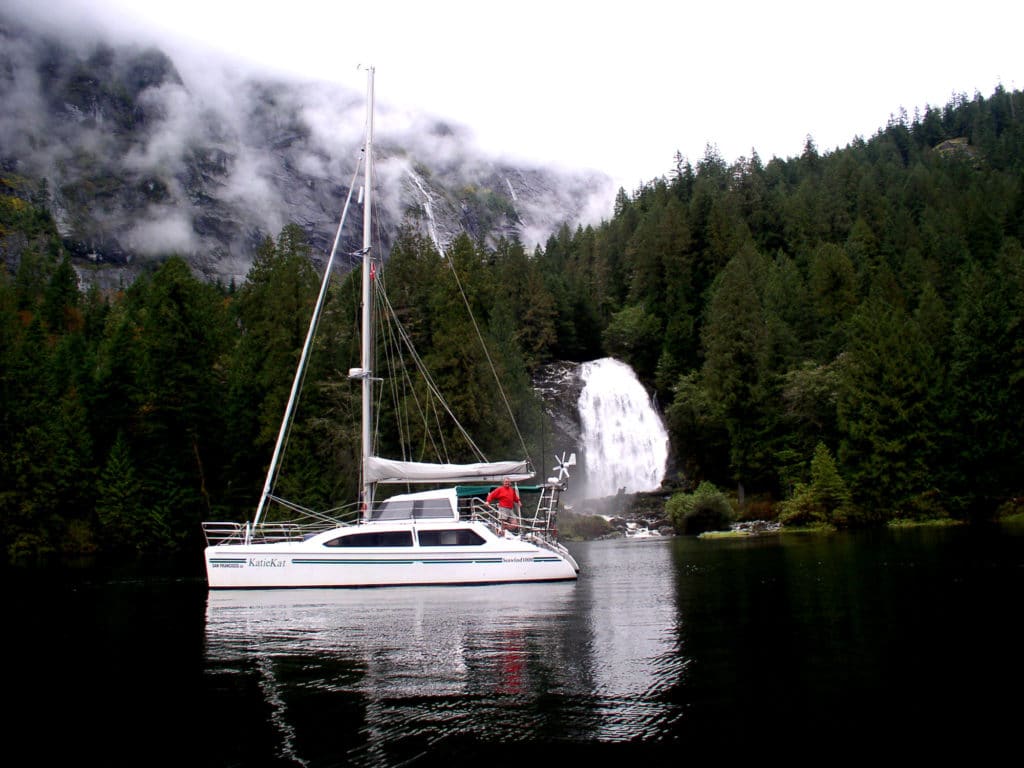
Founded by Aussie surfer and sailor Richard Ward in 1982, the 33-foot Seawind 1000 is easily the most popular cruising cat ever built in Australia (the company has since moved its manufacturing and management operations to Vietnam). Roomy and airy, these cats dot the coastline of eastern Oz.
Seawind 1160
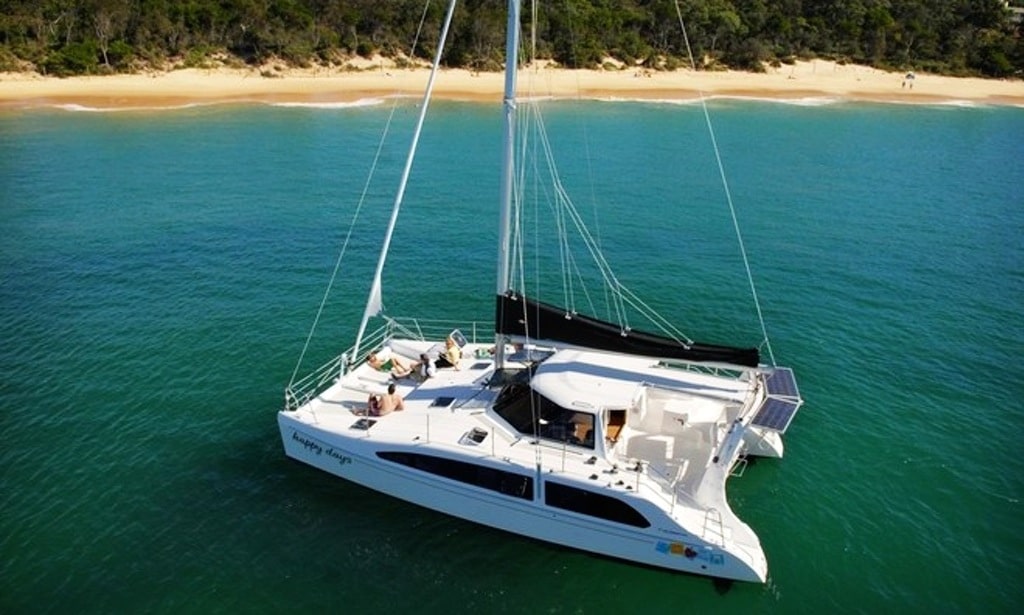
If the Seawind 1000 was a minimalist approach to cruising cats, the 38-foot Seawind 1160 is the flip side of the coin, a full-fledged long-range voyager. Among the reasons it was named CW ’s Most Innovative boat for 2007 is the unique “tri-folding” door that stashes overhead to open up the saloon and cockpit into a spacious living area.
Click here to read more about the Seawind 1160.
Sunsail 384
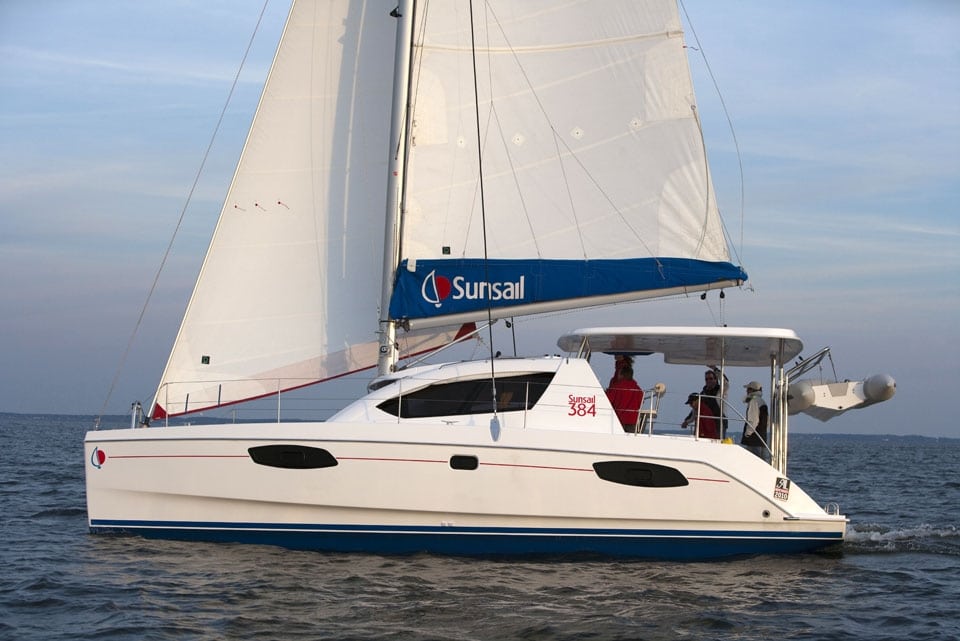
Every sailboat is a compromise, and in the case of the Sunsail 384 (also sold privately as the Leopard 38) that’s a good thing, because designers Morrelli & Melvin and builder Robertson and Caine got the balance just right with this relatively small catamaran. With four cabins, the 384 can carry the same size bareboat charter crowd as her larger siblings, but does so with a decided bounce in her step. Named CW’s Import Boat of the Year in 2010, you can gauge the success of the design by the grins on the crew as they barrel down Sir Francis Drake channel in the British Virgin Islands.
Victoria 67
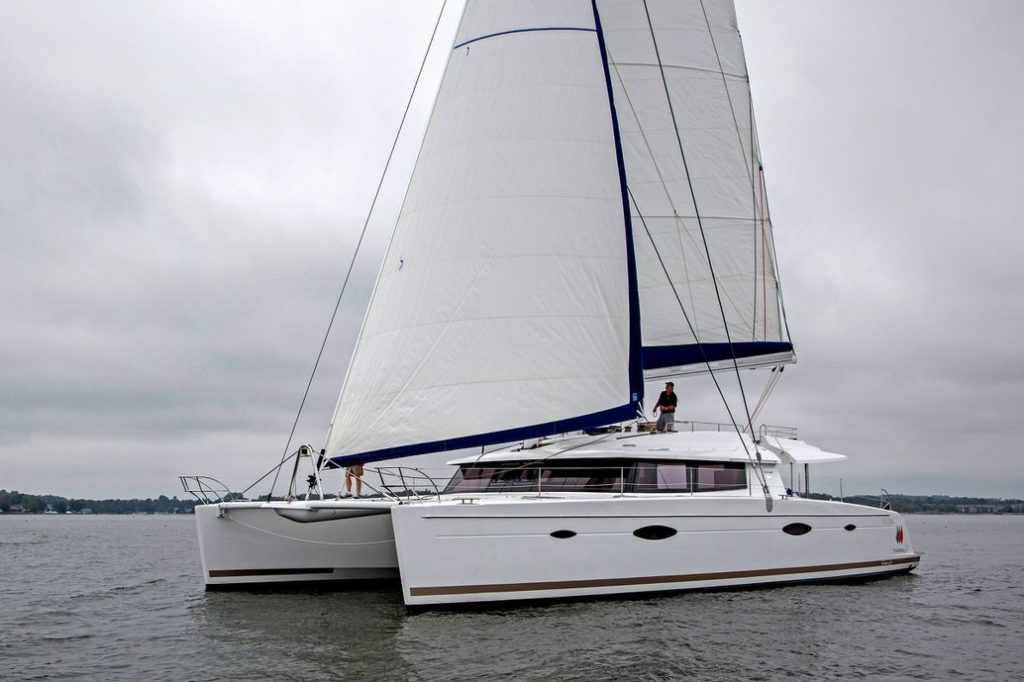
The French design office of Berret Racoupeau drafted the lines of Fountaine-Pajot’s new flagship, introduced in 2013, a magnificent world-girdling voyaging catamaran. Like other giant cats launched in recent years, the boat features a sensational upper deck with all sail controls, helm and lounging stations.
Click here to see more images of the Victoria 67.
Wharram Tanaroa
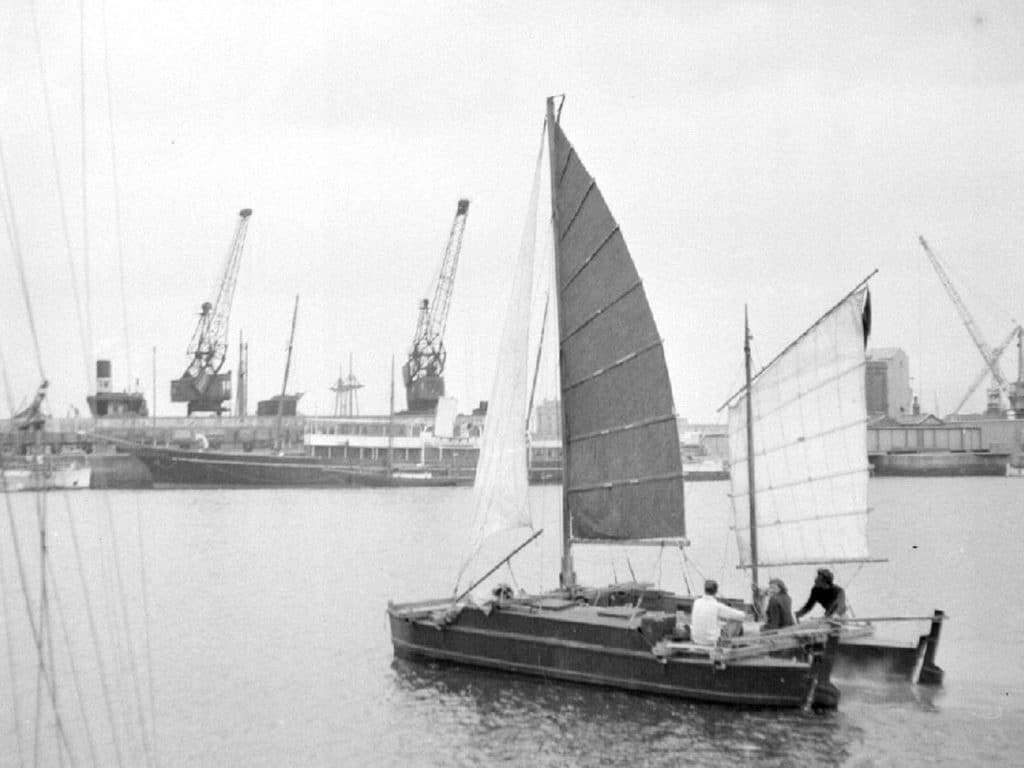
No list of influential multihulls would be complete without the work of James Wharram, and while Tangaroa wasn’t a production cat by any means, it showcases the British designer’s respect for ancient Polynesian craft. Wharram sailed this 23-foot-6-inch “double-hulled canoe” across the Atlantic in the 1950s, and sold countless plans for similar boats for decades afterwards.
- More: Boat Gallery , catamaran , multihull , Sailboat Reviews , Sailboats
- More Sailboats

New Sailboat Brand: Mishi Yachts

For Sale: 2005 Tayana 48

For Sale: 2015 Catalina 355

For Sale: 1998 Hinckley 51
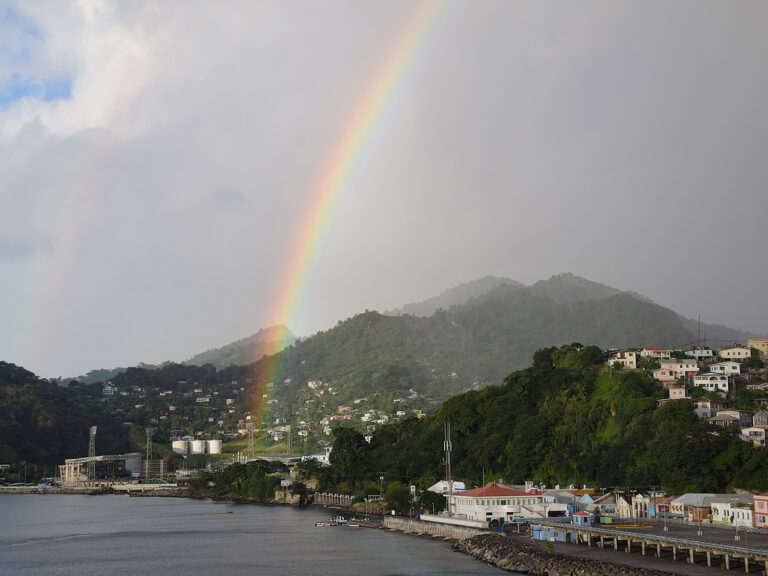
Hurricane Beryl Relief Efforts: How You Can Help

Gary Jobson To Talk U.S. Prospects in Upcoming World Sailing Competitions

Make Downwind Sailing Fun Again. Turn Off That Motor and Unfurl Your Kite!
- Digital Edition
- Customer Service
- Privacy Policy
- Email Newsletters
- Cruising World
- Sailing World
- Salt Water Sportsman
- Sport Fishing
- Wakeboarding

What Size Catamaran To Sail Around The World

Last Updated by
Daniel Wade
August 30, 2022
Catamarans are generally longer than monohulls, but their accommodations and handling vary widely between sizes.
The best size catamaran to sail around the world is 45 to 50 feet. The smallest catamaran with space for long-term provisions and a cabin is around 30 feet in length, and a 55 to 60-foot catamaran is the largest that can be accommodated at most marinas.
In this article, we'll go over the different sizes of catamarans and how they handle in the open ocean. Additionally, we'll cover each size category and the best sizes for traveling the Pacific and Atlantic Oceans.
We sourced the information used in this article from marine design guides and the consensus of experienced catamaran sailors.
Table of contents
What Sizes Are Catamarans?
Catamarans come in all shapes and sizes, but the smallest models don't have the accommodations required to sail around the world. Most catamarans under 30 feet in length don't have a cabin at all, which is a stark difference that they have with monohulls.
Small monohull sailboats often have cabins, as there's plenty of room below on a wide single-hulled sailboat. Monohulls can be as small as 16 to 18 feet and still have a cabin, but catamarans must be much larger to have suitable accommodations.
The smallest catamarans are about 12 to 15 feet long. These are small recreational craft used primarily for racing, and they aren't designed for the open ocean. Larger catamarans in the 20-foot range can (and have) been used on the ocean, but they're usually classified as day boats.
Catamarans become practical for longer excursions once they hit about 30 feet in length. A boat of this size is large enough for a cabin and can usually accommodate between two and four people comfortably. Catamarans commonly stretch beyond 50 feet, which is where they're the most useful and comfortable.
Smallest Catamaran to Sail Around the World
So, what's the smallest catamaran you could use to sail around the world? In theory, any catamaran can sail long distances—but you need one that's large enough for shelter and storing provisions. Generally speaking, 30 feet is the bottom limit for an ocean-crossing catamaran.
Let's take the ME Cat 30 (Maine Cat) as an example. This small and nimble 30-foot catamaran makes use of its limited space and provides comfortable accommodations for a few adults. The ME Cat 30 is a split design that houses the basic accommodations in either hull, with an open seating area between them.
Inside the ME Cat 30, there's barely enough room for all the living spaces. It features a head and a large bed in one hull and a galley and a smaller berth in the other. With that, all the useful cabin space is filled—and this is considered a very good design for the size. As you can see, the best catamarans for sailing across the world are usually much larger.
Typical Ocean Crossing Catamaran Size
Based on what we discussed above, a 30-foot cruising catamaran is really pushing the limits on size. However, it doesn't take a whole lot more length to make a catamaran exponentially more comfortable and suitable for long journeys.
The typical ocean-crossing catamaran is usually about 40 to 45 feet long. With the addition of 10 feet in length, designers can fit an enormous amount of additional accommodations in the hulls.
This is because adding a little extra length allows designers and boatbuilders to widen each hull significantly, which makes room for luxuries like private bedrooms, multiple bathrooms, and entirely separate dining and cooking spaces.
Cruising Catamaran Floor Plans
A 40-foot to 50-foot catamaran usually comes with a mirrored floor plan. The traditional catamaran has an identical layout in each hull. That means if one hull has a private berth in the bow and a shower and a toilet in the stern, the other hull will have the exact same layout except opposite.
This is usually because spaces like the galley and sitting area are kept in the center console, where there's much more space to move around. Spaces that are used at night or only occasionally are kept in the narrow hulls, as this has proven to be a more comfortable layout for crews.
Storage is usually kept deep in the hulls as well, as there's extra space to work with when the only other design purpose is for sleeping in bathing. Catamarans in this size range can also have separate hull layouts, but the mirrored design is by far the most common.
Best Catamaran Size for Pacific Ocean Cruising
Catamarans are very versatile craft, but some function better in the Pacific Ocean than others. One of the main considerations when choosing a catamaran for Pacific Travel is that the Pacific usually has greater distances between ports and stopping points.
This is especially true on the US West Coast, where there are only a handful of ports and safe anchorages. The best Pacific cruising catamaran size is between 45 and 50 feet in length, as you're likely to need more space to store provisions for extended cruising.
If you're starting in San Francisco or Seattle, even a 'short' trip along the coastline could mean you'll pass hundreds of miles of steep rocky cliffs and no stopping points insight. When crossing the Pacific, you may travel thousands of miles before you encounter a port or island with any infrastructure at all, let alone stocks of provisions and a full-service marina.
The Pacific is a huge ocean, and the last thing you want to do is run out of food or fuel a thousand miles from your destination. Larger boats store more supplies, and they also give you more breathing room when you're surrounded by empty blue water for months on end.
Best Catamaran Size for Atlantic Ocean Cruising
The Atlantic Ocean is smaller than the Pacific Ocean, and the coastlines of many countries that border it tend to be well-developed. This makes it easier to get away with owning a smaller boat, as you don't need to store as many supplies, and your voyages will be shorter.
Another factor to consider is that not all marinas on the Atlantic can accommodate extremely large catamarans, or it may be prohibitively expensive to dock a 55-foot or 60-foot double-wide vessel. That's why the ideal size for an Atlantic-crossing catamaran is between 40 feet and 50 feet. Today, 45 feet seems to be average.
The boat of this size will fit in at most marinas in developed countries around the Atlantic, and its draft is shallow enough for island hopping and exploring the coral reefs that the Atlantic Islands are known for. Additionally, 40 to 50-foot catamarans are usually just as seaworthy as the larger boats, and they're less expensive to maintain.
Unlike the US West Coast, where ports are few and far between, the Atlantic in the Gulf of Mexico is littered with marinas and safe anchorages. You can travel for weeks along the coastline of the United States and parts of South America and never be further than a hundred miles from a full-service marina.
There are also hundreds of islands, tourist destinations, and service locations that reduce your need for large stores of provisions aboard your catamaran. This gives you a lot more flexibility in choosing a size and a floor plan, as your needs are different than that of a Pacific sailor.
Best Catamaran Size for World Cruising
If you're planning to go on a world tour or a circumnavigation, you're going to need a catamaran that's large enough to fit your crew and your provisions comfortably.
You'll also need a boat that is small enough to be serviced and accommodated in most locations but also seaworthy enough to whether anything you're likely to encounter out of the water.
For most people, the sweet spot seems to be around 45 to 50 feet in length. A 50-foot catamaran is more than large enough to store enough provisions for many months of sailing. It's also roomy enough to house two to six people comfortably for many weeks at a time.
Catamarans between 40 and 50 feet in length are also extremely seaworthy and have been known to make circumnavigation frequently. You're almost guaranteed to find a 50-foot catamaran in almost any remote anchorage in the world where sailors are known to frequent.
Also, almost any marina can accommodate a 50-foot catamaran, and most boatyards can perform at least basic repairs on a boat of this size. Most marinas have fee schedules for boats based on size, and the cutoff for large boats is usually 60 feet. This keeps you in the 'medium' boat category, which can save you thousands.
How to Choose a Catamaran Size
Choosing the right size catamaran can be challenging, but there are a few things you can do to narrow it down. First, examine how you plan to use the vessel. You can travel the oceans in a catamaran between 30 and 40 feet long, so if you have a small crew, you may want to consider a compact model.
Larger catamarans can sleep eight or more people comfortably. This is large enough for most people, though some charter captains may need additional room. A 40 to 45-foot catamaran is usually large enough for a small family, though a 50-footer would be more comfortable, especially if there are kids running around.
Related Articles
I've personally had thousands of questions about sailing and sailboats over the years. As I learn and experience sailing, and the community, I share the answers that work and make sense to me, here on Life of Sailing.
by this author
Most Recent

What Does "Sailing By The Lee" Mean?
October 3, 2023

The Best Sailing Schools And Programs: Reviews & Ratings
September 26, 2023
Important Legal Info
Lifeofsailing.com is a participant in the Amazon Services LLC Associates Program, an affiliate advertising program designed to provide a means for sites to earn advertising fees by advertising and linking to Amazon. This site also participates in other affiliate programs and is compensated for referring traffic and business to these companies.
Similar Posts

How To Choose The Right Sailing Instructor
August 16, 2023

Cost To Sail Around The World
May 16, 2023

Why Do Catamarans Have Trampolines?
April 17, 2023
Popular Posts

Best Liveaboard Catamaran Sailboats
December 28, 2023

Can a Novice Sail Around the World?
Elizabeth O'Malley
June 15, 2022

4 Best Electric Outboard Motors

How Long Did It Take The Vikings To Sail To England?

10 Best Sailboat Brands (And Why)
December 20, 2023

7 Best Places To Liveaboard A Sailboat
Get the best sailing content.
Top Rated Posts
Lifeofsailing.com is a participant in the Amazon Services LLC Associates Program, an affiliate advertising program designed to provide a means for sites to earn advertising fees by advertising and linking to Amazon. This site also participates in other affiliate programs and is compensated for referring traffic and business to these companies. (866) 342-SAIL
© 2024 Life of Sailing Email: [email protected] Address: 11816 Inwood Rd #3024 Dallas, TX 75244 Disclaimer Privacy Policy
Yachting World
- Digital Edition

The best bluewater multihulls of all time: a complete guide
- Toby Hodges
- October 6, 2021
Toby Hodges and François Tregouet consider the best bluewater multihulls and look at the options for sailing the oceans in spacious comfort

What are the best bluewater multihulls for long term cruising? The one you own, or the one you can afford is the simple answer.
There is a wealth of proven designs to suit bluewater sailing and a variety of budgets. While we have focussed here on the best bluewater multihulls in production, we’ve also included some cracking pedigree multihulls which tour the planet and might occasionally pop up on the brokerage market.
If you can afford to, then pushing towards the 45-50ft length will buy you space, pace and that extra payload capacity needed to take all the items you’d want on your home afloat.
When looking at the best bluewater multihulls, the choice will come down to that perennial balance between comfort/space and speed/weight. Choosing a lighter weight performance design will obviously help you cover distance voyages more rapidly and potentially allow you to outrun weather systems. It means you can sail faster, with less sail up and less load and stress. But you’ll have to sacrifice some luxuries and need to be quite scrupulous about keeping weight down and centralised in order to maintain high average speeds.
For the majority of cruisers, however, it is the amount of space multihulls offer once you’ve reached your destination that really appeals. As well as the non-heeling living area and real estate they provide, they’re well suited to typical tradewind sailing .
If you’re considering your first or next multihull, we hope the following will serve as a taster.
Best bluewater multihulls for performance cruising
Outremer 51/55.
When you think of multihulls designed for bluewater cruising, Outremer will likely be one of the first names that comes to mind. Its heritage lies in building catamarans that can sail fast and are built strong enough to do laps of the globe.
The 51, the current version of which launched three years ago, is an archetypal example of what to look for in terms of blending speed and space is a dream design for a family circumnavigation.
The French yard’s new 55ft VPLP design may look boldly different from its past models, but the philosophy behind it remains the same. It is designed to match windspeed up to 12 knots and Outremer reasons that its ability to sail in 5 knots of breeze will allow it to sail for 95% of the time on a circumnavigation.
Read more about the Outremer 51 and Outremer 55.

Photo: Diego Yriarte
Seawind 1600/1370
For nearly four decades the Australian Seawind brand and its founder Richard Ward have been gearing catamarans around safe bluewater sailing, including performance, protection and ease of handling. Its Reichel Pugh-designed 1600, which launched three years ago, is an elegant looking cat with relatively low, long lines and some smart solutions for fast bluewater sailing.
Seawind also launches its new 1370 later this year, a staggering 60 of which have sold on plans alone.
This first 50 is built from a composite sandwich of basalt fibre, a cloth made from volcanic rock, and PET foam from recycled plastic bottles, which helps to reduce carbon emissions by nearly 50% when compared with traditional glassfibre methods.
This new 50 footer is perhaps a more appealing and practical prospect than Rapido’s previous 60 (with its significant fixed beam), particularly as the amas on this new model can fold to reduce beam to 18ft.
Infused carbon foam sandwich construction is used, along with beams, daggerboards and rudder in pre-preg carbon to keep displacement to 8,200kg.
Read more about the Rapido 50
This OC50 is designed as a more affordable cruising alternative, than the HH models which have preceeded it. This model targets ocean sailing.
It’s still stiffened and strengthened by carbon, but built in vinylester composites with a gelcoat finish. This adds an additional 300kg or so over a full carbon HH50, but cost savings are in the region of $400,000.
Read more about the HH OC50
Balance 526
The 526 launched four years ago, designed to suit short-handed sailors and families looking to sail long distances, hence it can carry large payloads and promises easy maintenance. It looks good too.
Berman’s Versahelm design is a key feature. The wheel cantilevers, allowing the helmsman to steer from outboard with clear sightlines or from the hardtop protection of the aft cockpit.

Photo: Christopher White
Atlantic 47
The A47 suits short-handed fast ocean sailing at an approachable size. Lengthening it to 49ft allowed for an aft cockpit. It is available as a sloop or with White’s patented MastFoil ketch rig – rotating aerofoil masts designed for easy short-handed cruising without sacrificing performance.
Read more about the Atlantic 47
A combination of sharp design from François Perus and high build quality brings plenty of appeal to this sporty Italian-built cat. The first example launched three years ago with a light displacement of 10.5 tonnes, thanks to an E-glass epoxy-infused build with carbon strengthening. The yard offers semi-custom construction and full hybrid packages.
Catana 53/Ocean class 50
Catana’s performance model from 2017, sports twin aft helms (which may not suit ocean sailors), reverse bows and carbon daggerboards. The high topsides help create good bridgedeck clearance and plenty of accommodation. Its new Ocean Class 50 seems more in the shipyard’s bluewater DNA. The light weight, and dynamic and modern shape with slim hulls and a relatively short nacelle suggests a seaworthy nature and high speeds.
Read more about the Catana 53
Best bluewater multihulls for pedigree performance
Veteran multihull designers Morrelli & Melvin designed this smaller model for the Gunboat range. It was built to be more manageable for an owner-driver yet still capable of up to 300-400 mile days.
The Gunboat 48 is something of a rare breed, just six 48s were built between 2004 and 2009. Oh, to have a spare €1.3m right now… one of them is actually on the market.
Read more about the Gunboat 48
At the start of the Millennium, Catana offered fully equipped boats as standard for long distance cruising. The Catana 471 or 472 (one or two helms respectively), represented at the time the optimum in ocean-going catamarans.
Chincogan/Lightwave
Tony Grainger has been drawing fast multihulls for 35 years, including racing trimarans and the Lightwave and Chincogan cruisers. The popular Lightwave 38 has admirable performance and comfort, and the Chincogan 52 (pictured) has the length to clock high average speeds.
Outremer 45 G. Danson
With its characteristic roof, narrow hulls and daggerboards, the Outremer 45 is a standout design which has become somewhat iconic. Despite a rather spartan interior, it has been a great success with fast cruising enthusiasts. On board, family ocean crossings at an average of 10 knots are the norm.
Best bluewater multihulls for family cruising

Photo: Nicolas Claris
The Lagoon 450 remains the most popular model in Lagoons already popular range. It exemplifies the VPLP/Nauta design partnership which has made these the very definition of modern mid-size cruising catamarans which can appeal to families and charterers alike.
Indeed the 450 marked the modern look of Lagoon and was the first with interior styling from Nauta. It originally launched over a decade ago as a flybridge design with central helming position (450F), before this ‘sport top’ option (450S) was offered with a starboard helm station and lower boom.
Read more about the Lagoon 450

Photo: Guilain Grenier
Fountaine Pajot Saona 47
The 47 has a modern shape, with straight bows and a reverse sheer line. It incorporates significant volume in the hulls below the bridgedeck to create room for the optional athwartships cabins. Cabin space is a prime selling point, particularly the owner’s suite to port, where there is also abundant natural light and headroom.

Photo: Tui Marine
Leopard Catamarans, together with designer Simonis Voogd and builder Robertson and Caine, produce the archetypal dual-purpose owner-operator or charter boat in their modern catamaran range.
Key features of the 45 are the amount of light in the saloon and the incredible volume and space on offer in the cabins above the relatively narrow waterlines. Vast social living areas include the flybridge, saloon and dual cockpits.
Read more about the Leopard 45

Photo: www.jfromero.fr
Nautitech Open/Fly 46
During the 1990s and noughties Nautitech earned a good reputation for its elegant catamarans. The 441 is a timeless example and the 44 can be credited with the ongoing trend in hardtop biminis. While its acquisition by Bavaria seven years ago helped Nautitech implement industrial build techniques, the French brand has retained its DNA at its Rochefort sur Mer yard.
The modern Marc Lombard designs have tall rigs with generous square-top mainsails. Twin wheels in the aft quarters of the Open 46 offer a direct feel on the helm, however those spending long periods in the tropics may prefer the shade of the bimini-equipped flybridge option. The layout is also open, with a saloon more outside than in. Styling is clean, modern and simple, and the standard of build and finish are good.

Photo: Olivier Blanchet
First impressions of the Neel 51 are sure to centre on its sheer size and space inside. But as you’ll see from our review of the Neel 43 on page 83, when you sail one overriding impressions quickly centre on its performance.
These trimarans are becoming a popular mass production-built option.

Photo: Christophe Launay
The Excess 11 packs plenty of potential as the smallest yacht offered by the big production yards. A little like the Lagoon 380 of old, it presents a good value new entry-level boat for genuine cruising in a more sporty, modern and enticing design. Some may argue against aft helms for ocean sailing, but those coming from monohulls will appreciate the more direct steering they offer.
Broadblue 385S
Broadblue is a UK brand which offers a distinct line of cruising and Rapier performance catamarans. Its staple 385 packs a lot of cruising comfort into its length, including generous tankage, and has been sailed all over the world. Broadblue built its first electric drive catamaran 12 years ago and offers the only all-electric production sailing catamaran under 40ft in Europe.

Photo: Christophe Breschi
Bali Catspace
For those looking for maximum volume within 40ft, it’ll be hard to beat the Catspace – although it is more of a holiday apartment than a traditional bluewater cruiser. Bali’s garage style sliding aft door does help offer an enormous amount of enclosed (or open) living space.
Best bluewater multihulls for luxury cruising

Photo: Nico Krauss
Privilège 510 Signature
The 510 is designed to take a serious amount of cruising gear – up to six tonnes of it in fact. The excellent helm station now has a fixed windscreen and all lines lead to hand. Finish quality including the electrical installation is first class and Privilege’s trademark, an admirable full beam (26ft) forward cabin, is sumptuous.

Photo: Jérôme Houyvet
Garcia Explocat 52
Garcia Yachts has cornered the market for series-built aluminium monohulls and multihulls in the last decade and this new Explocat 52 is sparking real interest. We ran a full test report in our February issue, describing it as a go-anywhere cat with an enticing combination of space, pace and rugged construction.
Read our review of the Garcia Explocat 52
Built in Argentina, the Antares 44 is the ultimate evolution of a model launched 21 years ago. Entirely dedicated to bluewater cruising, it is the yard’s only model and is constantly being improved according to owner feedback.
Time seems to have no hold on this boatyard and, against the trend, the standard equipment of the Antares 44 is extremely complete

Photo: Richard Langdon
Discovery Bluewater 50
This luxury Bill Dixon design may be a decade old now and into its third iteration, but the concept behind its original appeal remains. For those used to sailing high-end thoroughbred monohulls, here is an option to consider for a comparative level of build quality and fit out when moving to a multihull.
Read more about the Discovery Bluewater 50
St Francis 50 MKII
With this latest version of its original model, this experienced South African builder has optimised a catamaran cut out for the unforgiving seas of the Indian Ocean and the South Atlantic. The MKII allows for an increased load capacity, an important point in long distance cruising.
Xsquisite X5
Intelligent features on the X5 include the protected helm station with glass windscreen, integrated rainwater catcher, UV-protective glass and generous tankage.

Best bluewater multihulls for size & speed
Mcconaghy mc52.
The MC50 (now MC52) was the first and promises some high speed sailing, but it’s the open plan main living deck which will attract the majority. It incorporates an intelligent centreboard system, which hardly affects interior space, but arguably its exposed helms at the aft end of the flybridge will not suit serious ocean cruising.

Photo: Florian H. Talles
HH in Xiamen is building some really impressive large, luxury fast cats up to 90ft. This was its second model to launch, a high-end, high performance Morelli & Melvin design capable of rapid passagemaking speeds and enjoyable regatta sailing. Features include C-shaped boards and central or aft helms.

Photo: Mike Jones/Waterline Media
Ocean Explorer 60
If Nautor’s Swan made catamarans, they may look like this… The Ocean Explorer 60 uses the same designer in German Frers and some of the same builders who worked at the famous Finnish yard to produce this world cruiser. The resultant quality shines through. A new OE72 is due soon.
Kinetic KC54
A young company with plenty of experience, Kinetic produces custom fast ocean cruisers, which can occasionally race. Its 62 is a serious performance vessel with carbon hulls, rigs and rigging, daggerboards or centreboards. With fast bluewater cruising the goal, carbon is used to minimise weight so features/toys can still be added. The swim platform and hardware on the newly launched 54 weighs just 90kg, and the generous sized tanks are all in carbon too. Views from the saloon and forward cockpit also look special.
Best bluewater multihulls for ultimate performance
Marsaudon ts4/orc 42.
Few catamaran builders produce genuine performance cruisers at this ‘smaller’ size: this one is kept minimalist and light weight (around 6 tonnes) – the yard’s philosophy is ‘simplicity, then add lightness.’ The 42 is a cruiser-racer with the ability to outpace most yachts across the Atlantic, win a regatta and still offer some space for island hopping. Standard tankage is minimal however. Marsaudon recently rebranded its TS range to Ocean Rider Catamarans (ORCs) and has an ORC 57 in build.
Dazcat 1495
Dazcat builds fast, seaworthy cats from its Multihull Centre in Cornwall. The 1495 is a true ocean cruiser-racer, which is stiff and rewarding to sail, with direct steering linked to carbon rudders. The 1495 can hit 20+ knot speeds with relative ease, but it is the consistent high average speeds which will attract those looking to cover serious miles. Weight is centralised including engines, tanks, and systems all located amidships to help reduce pitching. Dazcat has a semi-custom build approach and creates all sorts of weird and wonderful craft for all abilities.
Dragonfly 40
Dragonfly trimarans are known for their high quality construction and ability to delight sailors with their ease of planing speeds. For those who can live without the space of similar length cats, the new flagship 40 is large enough to offer cruising space, while folding outriggers and retractable appendages mean you can dry out where others wouldn’t dare.
Looping 45/Freydis 48
These two designs by Erik Lerouge both offer a high-performance vision of ocean cruising. The Loopings were built individually and the Freydis in small series, and on both you can sail as fast as the wind in complete safety. Interior quality depends on whether finished by an amateur or by a shipyard.
Swisscat 48
An attractive combination of luxury, comfort and performance, the S48 is a stiff, go-anywhere premium cat that is easy to manage single-handed. The lightweight build (11t) is in epoxy infusion with carbon reinforcement.
Schionning Designs
Jeff Schionning has catamaran design in his blood. His designs exude performance and seaworthiness with flowing, even aerodynamic lines. On all tradewind routes you’ll find a G-Force (models from 12m to 23m) or an Arrow (12m to 15m) sailing more quickly than the rest. His latest venture is with Current Marine in Knysna, South Africa.
Best bluewater multihulls for pedigree cruising
The long-time best-seller from the world leader in catamarans, with more than 1,000 produced over almost 20 years from 1999. With its characteristic vertical windows, the 380 and its big brother the 410 made the purists scream when they were presented. But the 380 proved a pioneer of its kind. Safe bow volumes and light displacement (7,260 kg) helped its seaworthy behaviour. The high number of boats on the market makes this the most affordable bluewater cruising multihull for its size, even if price range is as wide as condition is variable.
Casamance 44/46
Between 44ft and 46ft depending on the year of construction and the length of its transoms, the Casamance was an impressive catamaran on launch in 1985. The design by Joubert/Nivelt offered good volume and load capacity. Of the 490 units produced, many joined the charter fleets. The exterior of the Casamance is dated, but the interior in grey ceruse oak has retained plenty of charm.
If you enjoyed this….
Yachting World is the world’s leading magazine for bluewater cruisers and offshore sailors. Every month we have inspirational adventures and practical features to help you realise your sailing dreams. Build your knowledge with a subscription delivered to your door. See our latest offers and save at least 30% off the cover price.
RetireFearless
Best Catamarans To Sail Around The World
Sailing the world on a catamaran is a dream for many, but it can be hard to know where to start. So, what are the best catamarans to sail around the world?

October 17, 2023
This article may contain affiliate links where we earn a commission from qualifying purchases.
It's no secret that sailing the world is a bucket list item for many people. But between the cost and the logistics, it can feel impossible to make this dream a reality.
The Lagoon 42 is known for its comfortable interiors and large outdoor spaces. The Astréa 42 from Fountaine Pajot is another great option for those looking for a spacious boat. Finally, the Nautitech 44 is a great choice for those who want a catamaran with all the bells and whistles.
Sailing the open seas on a catamaran is a dream for many people. There is something about the tranquility and freedom of being out on the water that just calls to us. If you have ever dreamed of sailing around the world, now is your chance. In this article, we will discuss some of the best catamarans to sail the high seas.
We spent countless hours researching the best catamarans for sailing around the world. We considered factors like price, comfort, and space in our decision-making process. In the end, we narrowed it down to three boats that we believe are the best of the best.
Table of Contents
1. Lagoon 42
The Lagoon 42 Catamaran is a sailing vessel that is designed for both comfort and performance. The catamaran features two hulls that are connected by a central platform, which provides ample space for both relaxation and recreation. The Lagoon 42 is also equipped with a large sail, which makes it ideal for both long-distance cruising and racing.
In addition, the catamaran is equipped with a state-of-the-art navigation system, which ensures that the vessel remains on course even in the most challenging conditions. As a result of its impressive design and capabilities, the Lagoon 42 Catamaran is one of the most popular sailing vessels on the market today.
This catamaran is designed for cruising and features a large main salon, four en-suite staterooms, and plenty of outdoor living space. The vessel features a large aft deck, which is perfect for entertaining or relaxing in the sun. In addition, the catamaran has a flybridge, which provides ample space for sunbathing or enjoying the views. With its sleek lines and modern design, the Lagoon 42 is sure to turn heads when out on the water.
The Lagoon 42 is constructed with a high-quality fiberglass hull and deck. The hull is designed to provide both strength and durability, while the deck is built for comfort and style. In addition, the catamaran features an aluminum beam that runs along the length of the vessel, which adds to its overall strength and stability.
The interior of the Lagoon 42 is both stylish and functional. The main salon features a large dining table, comfortable seating, and plenty of storage space. The galley is equipped with all of the amenities that you would need for long-term cruising, including a refrigerator, stove, oven, and microwave. The four staterooms are spacious and feature en-suite bathrooms, which provide added privacy and convenience.
One of the best things about the Lagoon 42 Catamaran is that it provides a comfortable and enjoyable ride no matter what the conditions are like. Whether you're sailing in calm waters or rough seas, you can be confident that this vessel will provide a smooth and stable ride. Additionally, the catamaran's large sail makes it easy to catch the wind and reach high speeds.
When it comes to performance, the Lagoon 42 does not disappoint. This catamaran is designed to provide a smooth, stable ride, even in rough conditions. The vessel is also equipped with a powerful engine, which allows it to reach speeds of up to 20 knots. In addition, the Lagoon 42 features a self-tacking jib and furling mainsail, which make it easy to sail and maneuver. As a result of its impressive performance, the Lagoon 42 is a popular choice for both racing and cruising.
While the Lagoon 42 comes standard with many features that will appeal to luxury boat buyers, there are also some drawbacks to consider. For example, the price of this catamaran can be quite high, especially if you opt for all of the available extras. Additionally, because it is a larger boat, the Lagoon 42 can be difficult to handle if you are not an experienced sailor.
Our Two Cents
If you are looking for a luxurious and feature-rich catamaran, the Lagoon 42 should definitely be at the top of your list. This vessel offers everything that luxury boat buyers could want, including ample space, a sleek design, and impressive performance. However, keep in mind that the Lagoon 42 comes with a hefty price tag. Additionally, make sure that you have the necessary experience to handle this catamaran before making your purchase.
- Price: $450,000-$650,000
- Length: 42 ft
- Displacement: 26455 lbs
- Fuel Tank Capacity: 79.3 gals
- Engine power: 45 Hp
- Luxurious and feature-rich
- Sleek design
- Spacious interior
- Impressive performance
- Difficult to handle if you are not an experienced sailor.
2. Fountaine Pajot Astréa 42
The Fountaine Pajot Astréa 42 is a luxury catamaran that was unveiled at the 2018 Cannes Yachting Festival. The Astréa 42 is the latest model in Fountaine Pajot's Astrea range of catamarans, and it features a number of upgrades from the previous model. The most notable changes include an increased overall length of 42 feet and a wider beam of 25.6 feet. The Astréa 42 also has an improved layout, with a more spacious cockpit and flybridge. The catamaran is powered by twin Volvo Penta engines, and it has a maximum speed of 27 knots. The Astréa 42 is available in three different layouts, and it can accommodate up to 10 guests.
One of the best things about the Fountaine Pajot Astréa 42 is its spaciousness. The boat has a wide beam, and this makes it feel very roomy both inside and out. There is plenty of space in the cockpit for relaxing or entertaining, and the flybridge offers even more room to enjoy the views. The Astréa 42 also has a large swim platform, which is perfect for swimming or fishing. Another great feature of this catamaran is its fuel efficiency. The Volvo Penta engines are very efficient, and they help to keep operating costs down.
The Fountaine Pajot Astréa 42 is a luxurious catamaran that is perfect for both families and couples who are looking for a sophisticated vessel that can take them on the vacation of a lifetime. The Astréa 42 has been carefully designed with both comfort and style in mind, and its build quality is second to none. The hulls are made from GRP (glass reinforced plastic), and the deck is constructed from teak, which gives the boat a beautiful natural finish. The Astréa 42 is also equipped with a state-of-the-art satellite navigation system and a wireless internet connection, making it easy to stay connected even when you're out at sea.
Like any boat, the Fountaine Pajot Astréa 42 has its pros and cons. One of the main advantages of this catamaran is its size. The Astréa 42 is significantly larger than most monohulls, and this makes it perfect for families or groups of friends who want to enjoy plenty of space on their boat. Another great thing about the Astréa 42 is its fuel efficiency. The Volvo Penta engines are very efficient, and they help to keep operating costs down. One of the drawbacks of this catamaran is that it doesn't have a lot of storage space. This can be an issue if you're planning on going on a long cruise, as you may need to bring along extra supplies. The boat is quite large, and this can make it difficult to dock in some marinas.
The Fountaine Pajot Astréa 42 is a very stable boat, and it performs well in both calm and rough conditions. The hulls are made from GRP (glass reinforced plastic), which makes the boat very strong and durable. The keels are also quite deep, which provides good stability even in strong winds. The Astréa 42 is equipped with twin Volvo Penta engines, and these provide plenty of power for cruising at high speeds. However, the boat does use a lot of fuel when running at full speed, so it's important to keep this in mind if you're planning on going on a long cruise.
Is the Fountaine Pajot Astréa 42 the perfect catamaran for cruising? It depends on what you're looking for in a boat. If you want a large and spacious catamaran that is perfect for families or groups of friends, then the Astréa 42 is a great option. However, if you're looking for a smaller and more fuel-efficient boat, then you may want to consider another option. Overall, the Fountaine Pajot Astréa 42 is a well-built and stylish catamaran that is perfect for those who are looking for a luxurious vessel to take them on the vacation of a lifetime.
- Price: $450,000-$700,000
- Length: 41 ft 4 in
- Displacement: 27999
- Fuel Tank Capacity: 124.2 gal
- Engine Power: 2x30 HP
- Fuel efficient
- Great aesthetics
- Modern amenities
- Limited storage space
- Uses a lot of fuel at high speeds
3. Nautitech 44
The Nautitech 44 Catamaran is a vessel designed for both pleasure and utility. Though its initial purpose was to be a comfortable live-aboard cruising catamaran, it has since been used in a variety of different ways. The Nautitech 44 Catamaran is easily recognizable by its twin hulls, which provide both stability and ample space. It is this stability that makes the catamaran ideal for fishing, as well as other activities that require a steady platform.
In addition to its utility, the Nautitech 44 Catamaran is also known for its comfort and luxury. The vessel features large windows and an open layout, providing panoramic views and plenty of natural light. It also includes a spacious flybridge, perfect for relaxing in the sun. Whether you're looking for a vessel to take you on an adventure or simply wanting to enjoy the good life, the Nautitech 44 Catamaran is sure to please.
The Nautitech 44 Catamaran is a popular choice for both experienced sailors and first-time boat owners. Its twin-hull design provides exceptional stability, making it ideal for cruising in rough waters. The spacious deck and cockpit are perfect for entertaining, and the well-appointed interior features plenty of storage and comfortable accommodations.
The Nautitech 44 Catamaran is powered by twin 40 horsepower engines. It also includes a 110-volt generator, making it ideal for extended stays at anchor. The catamaran has a fuel capacity of 105 gallons and a water capacity of 210 gallons. It also features a holding tank for waste. The Nautitech 44 Catamaran is designed for both speed and comfort. Its hull shape and twin engines allow it to reach speeds up to 20 knots. However, its cruising speed is more typically around 12 knots. This makes it perfect for those who want to enjoy the scenery while still having a good time on their journey.
This yacht is designed to perform well in a variety of conditions, thanks to its twin hulls and powerful engines. In calm waters, the Nautitech 44 Catamaran slices through the waves with ease, making it a great choice for cruising. When the winds pick up, the catamaran's stability and sharp handling come into play, making it a great choice for racing. The boat's sails are also designed to maximize performance in different conditions, with large mainsails that provide plenty of power in light winds and smaller headsails that help the boat tack quickly in strong winds. Whether you're sailing in calm waters or racing in windy conditions, the Nautitech 44 Catamaran is a great choice.
The Nautitech 44 Catamaran is a great choice for a variety of customers. Thanks to its stability and comfort, it is perfect for those who want to use it as a live-aboard vessel. Its spacious flybridge and well-appointed interior make it ideal for entertaining, while its twin-hull design makes it perfect for fishing or other activities that require a steady platform. The catamaran's sails are also designed to maximize performance in different conditions, making it a great choice for both racing and cruising.
The Nautitech 44 Catamaran is a well-built vessel. It features a fiberglass hull and deck with an aluminum frame. The catamaran also includes stainless steel hardware and composite materials in its construction. This results in a vessel that is both strong and lightweight. The Nautitech 44 Catamaran is also designed for easy maintenance. Its hulls are gel coated for durability, and the boat's rigging is designed to be easily accessible.
The Nautitech 44 Catamaran is a well-constructed vessel that will provide years of enjoyment. Thanks to its fiberglass hull and deck, aluminum frame, and stainless-steel hardware, the catamaran is both strong and lightweight. Additionally, the gelcoat hulls are easy to maintain. The boat's rigging is also designed for easy accessibility, making it a great choice for those who want to spend more time sailing and less time working on their vessel.
The Nautitech 44 Catamaran features a spacious and well-appointed interior. The catamaran includes three double staterooms, each with its own private head. The salon is bright and airy, thanks to its large windows and sliding glass door. The galley is well-equipped, with plenty of storage and counter space.
The Nautitech 44 Catamaran's interior is designed for comfort and convenience. Thanks to its three double staterooms, the catamaran can comfortably accommodate up to six people. Each stateroom has its own private head, providing added privacy and convenience. The salon is bright and airy, making it a great place to relax or entertain guests. The galley is well-equipped, with plenty of storage and counter space.
The Nautitech 44 Catamaran is an excellent choice for those in the market for a new vessel. It is well-built, features a variety of high-quality materials, and is designed for easy maintenance. Additionally, the catamaran's sails are designed to maximize performance in different conditions, making it a great choice for both racing and cruising. If you're looking for a catamaran to sail around the world, the Nautitech 44 Catamaran should definitely be at the top of your list.
- Price: $550,000-$850,000
- Length: 44.19 ft
- Displacement: 22712 lbs
- Fuel Tank Capacity: 105 gal
- Engine Power: 2x40 Hp
- Lightweight and strong
- Easy to maintain
- Spacious and well-appointed interior
- Can carry up to 11 passengers
- Low fuel tank capacity
Recent Articles

What Size Sailboat Can One Person Handle?

How To Tie A Sailboat To A Mooring Ball Ring

What Is The Ideal Wind Speed When Sailing?

How To Use a Sailboat Winch

Things You Need To Liveaboard a Sailboat

Types of Sailboat Keels
I'm Michael Moris. I've been sailing my whole life, and it has taken me to places I never imagined. From the Caribbean to Europe, from New Zealand to South America - there's nowhere that hasn't felt like home when you're on a boat!

Trending Articles

How Far Is Havana From Miami By Boat?

Yachting Vs Sailing

Who Is Sailing Doodles?
Subscribe To Our Newsletter
Thank you! You're signed up for our free newsletter!
Oops! Something went wrong while submitting the form
About Our Team
We are a publishing team of licensed Nursing Home Administrators, Nurses, Assisted Living Directors, Health Professionals, Gardeners, and individuals with vast experience with senior living and activities.

©2024 Retire Fearless. All rights reserved.
We can be reached via email at [email protected]
Retirefearless.com is a participant in the Amazon Services LLC Associates Program, an affiliate advertising program designed to provide a means for sites to earn advertising fees by advertising and linking to Amazon. This site also participates in other affiliate programs such as CJ, ClickBank and more, and is compensated for referring traffic and business to these companies.
Facebook Pinterest

16 Best Trimarans For Sailing Around The World (And a Few For Daysailing)
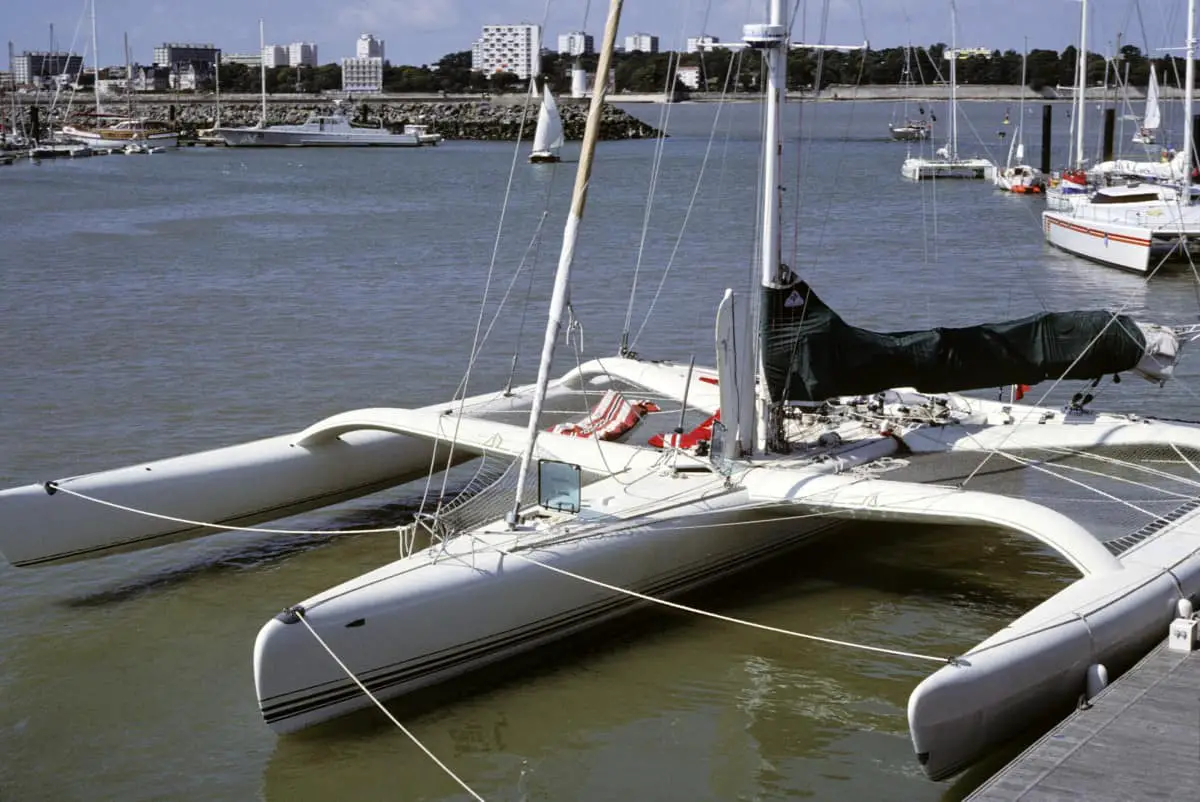
As an Amazon Associate, we earn from qualifying purchases. We may also earn commissions if you purchase products from other retailers after clicking on a link from our site.
Trimarans are growing in popularity worldwide, due to their light construction and high stability these multihulls are even faster than catamarans. Trimarans are still one of the lesser-known boat types so in this article ill be checking out some of the most popular models.
The best trimarans include:
- The Neel 43
- The Neel 47
- Dragonfly 28
- The Pulse 600
- Corsair 37
These tris are built with your safety in mind while also packing powerful speed and a wide array of comfort features to optimize your sailing experience , some are even foldable making them possible to load on a trailer and transport to the sailing destination of your choosing.
In this article, I have created a list of the 16 best trimarans in the market and their unique features. You’ll also learn the best options for different purposes such as circumnavigation, weekend sailing, racing, and more.
Table of Contents
What Is a Trimaran?

A trimaran is a multi hulled sailboat with three individual hulls; the main hull ( vaka ) and a pair of outrigger hulls ( amas ). These smaller outrigger hulls are attached to the main hull using beams.
While trimarans have a rich history dating back nearly four millennia, these types of sailboats have only gained popularity in the late 1900s and early 2000s.
Trimarans are primarily used as personal boats for sailing enthusiasts or racing. These sailboats draw their versatility from their lightweight design, making them faster and easier to handle at sea when compared to single-hulled boats (monohulls). Additionally, the three hulls also contribute to better stability, making it very hard to capsize (although more likely than a cat according to this study)
Trimarans come in various sizes, and some can be as small as 19 feet (5.8 meters) in length, while others go up to 60 feet (18meters). They’re also used for different purposes. Most trimarans are used for racing and recreational purposes, although some units are still used as ferries.
As with all things, to find out which is the best we need to understand what it will be used for. There is a big difference in requirements between a boat used for day sailing compared to offshore around the world sailing.
The list below highlights the best trimarans for different purposes.
Best Trimarans For Cruising, Liveaboard and Sailing Around The World
The Neel 43 is a French trimaran best suited for cruising. Its key features include:
- Easy maneuverability on the open sea by only a small number of crew members
This unit is also built for comfort, ideal for more extended travels. This 43-feet (13-meter) trimaran is also made with recyclable and bio-sourced materials, highlighting the manufacturer’s commitment to environmental consciousness.
This trimaran has a base price of €329,000 excluding VAT. This translates to approximately $370,138.
2.Neel 47 Possibly The Best
Named the best full-size multihull for 2020, the Neel 47 is a strong contender for one of the best trimarans in the market. This 47-foot (14.3-meter) long trimaran features optimized exterior and interior ergonomics for a unique design and look.
Still on design, the Neel 47 is ideal for couples looking to take a weekend off or spend some time as liveaboard. It has a spacious owner’s cabin and two bedrooms. It also features a spacious living room and kitchen and is optimized to ensure comfort for a couple.
The Neel 47 also has two basic guest cabins so your friends or children can tag along on your sailing adventure. Accordingly, this unit is ideal for those looking to explore the sea for the sheer joy of sailing.
The Neel 47 comes at a 571,139 euro ( $643,600 ) price tag, excluding VAT.
3. Rapido 60 The Fast and Comfortable Circumnavigator
The Rapido 60 offers a blend of performance, safety, and luxury, making it one of the best options for bluewater sailing. Measuring 59.3 feet (18 meters) in length, the Rapido 60 is an imposing unit. It’s made from lightweight sandwiches and carbon materials that provide speed and strength, allowing it to stand up to strong ocean currents.
The Rapido 60 also has spacious living spaces and is built for comfort at all points of the sail. Its design also optimizes safety. While it’s an ideal option for circumnavigating, it’s also an excellent choice for racing due to its speed.
This is also the same boat that The Youtube channel La Vagabond just purchased.
The Rapido 60 retails at $1,400,000 .
4. Rapido 40
The Rapido 40 measures 39.4 feet (12 meters) in length and is ideal for cruising around the world. The Rapido 40 features twin “C” foils, which provide added lift, enhancing its speed and performance whether you are sailing downwind or upwind.
Because it has C foils, this trimaran doesn’t have a central daggerboard, increasing interior space. Accordingly, it’s an excellent option for couples looking to cruise and enjoy great performances .
The Rapido 40 is made from high-tech all-carbon materials for a lightweight yet sturdy design. This material is also used for the countertops and furniture, and the cork flooring adds a touch of style.
This trimaran retails for $595,000 , making it a cheaper option than the Rapido 60.
5. Dragonfly 40
The Dragonfly 40 measures 40 feet (12 meters) in length. It features high-comfort standards, making it one of the best trimarans in the market for taking your family for a cruise. Because of its larger size, it has a better capacity, being capable of accommodating six to eight people, so you can bring your family and friends along.
It’s easy to navigate and extremely safe. With a maximum speed of 24 knots (44.5 km/h), this trimaran also provides fast speeds to make your cruise even more exhilarating.
The Dragonfly 40 retails from €509,000 exclusive of VAT, which rounds up to $572,000 .
6. Dragonfly 32
The Dragonfly 32 is a high-performance cruiser. Like the Dragonfly 28, this unit features a contemporary design for racing. This trimaran can accommodate five to seven crew members.
Although slightly longer than the Dragonfly 28 with its 32-foot (9.8-meter) length, the Dragonfly 32 has a max speed of 23+ knots (42.6+ km/h), making it one of the fastest trimarans for racing. This unit also has comfortable accommodation, which makes it an ideal option for a weekend cruise with family and friends.
The Dragonfly 32 has a base price of $350,000 .
7. Corsair 37
Thanks to a variable draft with a retractable rudder, the Corsair 37 is an ideal choice for shallow water exploration. This 37-foot (11.3-meter) long trimaran features advanced foam-cored construction designed for safety, making it virtually unsinkable.
The carbon hulls minimize weight, this makes for a lightweight ocean exploration sailboat with blistering speeds. One of its selling points is that this trimaran has previously been used for Arctic expeditions, possibly marking it as one of the better options for circumnavigation and offshore sailing in the northern waters.
This trimaran has a base price of $189,000 but can go up to $204,125 .
Best Trimarans For Day/Weekend Sailing
8. dragonfly 28.
The Dragonfly 28 is a 28-feet (8.75-meter) long sailboat that can accommodate up to five people. It comes in two versions:
- Touring version: This version is ideal for families.
- Performance version: This is built to provide optimal performance for the sports enthusiast within you.
It clocks a maximum speed of 22+ knots (22+ km/h) and is beam-folded. It’s an excellent option if you want a high-performance, comfortable yet smaller unit for your day or weekend cruise.
The Dragonfly 28 starts at €188,280 inclusive of VAT, which comes to around $211,600.
9. Dragonfly 25
Like other trimarans under the Dragonfly brand, this 25-foot (7.62-meter) trimaran is great for both racing and short term cruising. However, this high-performance boat delivers easy handling, making it perfect for couples looking to take a ride out over the weekend and seasoned sailors looking for an exhilarating racing adventure.
The Touring version features a lightweight build and offers comfort and accommodation to keep you, and the few guests you can fit, comfortable during the ride. This trimaran also has a Sport version, which is optimized for racing.
The Dragonfly 25 retails from EUR 86,800 .
10. Pulse 600
The Pulse 600 trimaran is a compact sailboat. It’s made from lightweight, carbon-reinforced construction and vacuum-formed materials for optimal speed. This trimaran is an ideal option if you are looking for speed.
It also features ample deck space, greater stability, and volume than most trimarans of similar size and build.
This trimaran measures 19.8 feet (6 meters) in length and can be sailed single-handedly by one person with minimal effort. The Pulse 600 has a base price of $38,800 , which places it in the lower price range.
The F-22 is one of the smaller trimarans in the market. Developed in New Zealand, the F-22 is a folding trimaran built for speed. The hulls are made from narrow fiberglass tied together using fiberglass beams and aluminum, minimizing bulk while optimizing speed.
The F-22 is roomy and is not as pricey as other models in the market. This trimaran has two main versions:
12. 2019 Weta Trimaran
The 2019 Weta trimaran is a 14.5-foot (4.4-meter) trimaran featuring a carbon frame, centerboard, rudder foil, and rudder shock. The hull is made from fiberglass and foam. The Weta is built for strength and speed based on these lightweight materials.
The 2019 Weta trimaran is easy to sail and is worth considering whether you want to take a quiet sail, race with your friends, or take kids to a sailing lesson. It has a simple design and is easy to set up independently. Thanks to its collapsible design, this trimaran is easily stored away with minimal space demands.
13. WindRider 17
The 17.4-foot (5.3-meter) WindRider 17 is one of the more versatile trimarans in the market. It packs high performance for a low cost. This trimaran has a light rotating mast to boost performance, and a full-battened mainsail optimizes visibility.
This sailboat is made from rotomolded polyethylene, which is more durable than fiberglass and demands less maintenance.
The WindRider 17 has a comfortable interior and can fit six adults. This is an ideal choice for social sailing for a couple or a family and friends. It’s easy to ride, and a shallow draft allows easy maneuverability.
14. Astus 22.5
If you’re looking for something small but still comfortable, this 22.5-foot trimaran is for you. Built for speed and maneuverability, the Astus 22.5 has optional foils to optimize speed. The modern design, coupled with the spacious interior, can fit up to four beds. Accordingly, this trimaran is suited for family outings.
This trimaran also has a foldable design, collapsing to only 16 feet (4.9 meters) for easy storage.
15. Multi 23 Trimaran
The Multi 23 trimaran has a contemporary design, featuring a vinyl ester and PVC foam core construction. The section below the waterline is made of solid glass for a sturdy base.
The beams are made of lightweight carbon, and the trimaran features a 33-foot (10-meter) aluminum rotating wing mast for optimal harnessing of the wind. While ideal for weekend excursions with family, once rigged with the asymmetrical spinnaker will get your heart pumping.
This trimaran packs high performance at a lower cost than most other options in the market. It’s a good choice if you are looking for a high-performing unit without spending an arm and a leg.
16. Challenger Class Trimaran
The Challenger Trimaran 15 is the best choice for persons with disabilities. It’s designed to provide disabled sailors an opportunity to explore their passion for sailing without worrying about aspects like safety or operation.
A man named Geoff Hold circumnavigated the British Isles in 2007, becoming the first disabled person to achieve this feat. He had quadriplegia.
Living up to its name, the Challenger can withstand harsh weather conditions while blending performance with speed.
Final Thoughts
Admittedly, no trimaran is best for everyone. But whether you are looking to race with your friends, take your loved ones or friends for a cruise over the weekend, or circumnavigate the ocean, you can rest assured that these lightweight trimarans will deliver speed, safety, and comfort to make it worth your while.
These brands are innovatively designed and feature intricate safety mechanisms that make them virtually unsinkable. Give them a shot and begin your ocean adventure.
- Basco Boating: A Comprehensive Guide & Introduction to Trimaran Yachts
- TheBoatAPP: New Trumarans: Which are the Best Ones
- Corsair Marine: Corsair 37
- Dragonfly: Dragonfly 28
- Rapido Trimarans: Rapido 60
- Neel Trimarans: Neel 43
- Yachting World: World’s Collect Yachts: Maxi Trimaran MACIF
- Yachting Monthly: Dragonfly 28 Performance
- Rapido Trimarans: Rapido 40
- Dragonfly: Dragon 32
- Dragonfly: Dragonfly 40
- Yachting World: Dragonfly 40 yacht tour: This cruising trimaran can do 24 knots
- Dragonfly: Dragonfly 25
- NauticExpo: Dragonfly 25
- Yachtworld: Corsair 37 boats for sale
- Cruising World: Neel 47 Trimaran: Best Full-Size Multihull0
- Neel Trimaran: Neel 47
- Multihull Solutions: NEEL 47 Boat Review | Cruising World
- Yacht World: 2022 Neel 47 for sale
- Farrier International: F-22
- Weta Marine: The Boat
- WindRider: WindRider 17 Trimaran Sailboat
- Astus Boats: Astus 22.5
- Boat-specs: Multi 23
- National Maritime Museum Cornwall: Challenger Trimaran #1 – BC26
Owner of CatamaranFreedom.com. A minimalist that has lived in a caravan in Sweden, 35ft Monohull in the Bahamas, and right now in his self-built Van. He just started the next adventure, to circumnavigate the world on a Catamaran!
Leave a Reply Cancel reply
Your email address will not be published. Required fields are marked *
Save my name and email in this browser for the next time I comment.
Recent Posts
Must-Have Boat Gear for Catamaran Sailors!
Sailing is probably the most gear-intensive activity I've ever done; there are so many decisions to be made about what gear to buy now, for tomorrow, and what to definitely never buy. The gear on...
6 Best Trailerable Trimarans For Bluewater and Coastal Sailing
Having a boat costs a lot of money, even when you are not using it, marina fees, etc. And once it is in the water most sailors never go very far from their "home marina" and sailing will be somewhat...


My Cruiser Life Magazine
Sail Around the World Route – Best Options Explained
Before you ponder your route to sail around the world, think about why you’re even thinking about such an undertaking.
There are countless sailing routes you can take to circumnavigate the globe, but each one is for a different sort of sailor. The two most common routes are the mid-latitudes “Milk Run” and the high-latitudes journey through the Southern Ocean or Northwest Passage.
Here’s a look at some of these very different trips and the types of sailors and vessels that accomplish each one every year.
Table of Contents
Basic planning factors – winds, currents, and storms, the classic sail around the world route – the milk run, circumnavigating in the southern ocean, an alternate sail around the world route the northwest passage, which sailing routes would you pick for your circumnavigation, sailing routes around the world faqs.
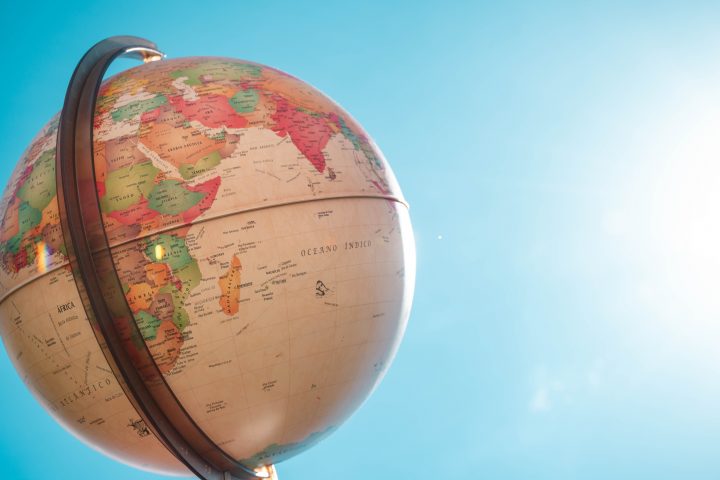
The Basics of Sailing Routes Around the World
First, some lingo. Sailors refer to a sail around the world route as a “circumnavigation.”
Taking a boat around the world requires some gumption. So why do it at all? For some, it is the goal of having done it. For others, it’s a fun way to combine their passions of sailing and travel. Some folks compete in races to see who can do it fastest. And some folks think it would be a good lark and a neat way to see the world.
Whatever reason draws you to the idea of completing a circumnavigation, you aren’t alone. Every year there are rallies or races that you can join to meet up with like-minded people. And for as many people who compete in rallies, there are likely an equal number of people doing it on their own.
No matter how you cut it, a circumnavigation is made up of numerous legs. So if traveling and seeing the sights is your goal, then it only makes sense to take your time and visit as many places as you can along the way.
Folks with a limited time frame will inevitably miss something or rush through someplace they want to see.
For sightseers, the goal of a circumnavigation might be secondary to seeing the places they want to see. In other words, someone with their heart set on circumnavigating might set a schedule of two years to get it done, while another sailor who wants to complete loops in the Atlantic and Pacific might have a lot more time to visit more countries and ports of call.
Every sailor and every boat comes into this adventure with different goals. Therefore, it’s important to think about your motivations and the sort of circumnavigation that you’d like to have. What’s the most important part to you, and how much money and time can you dedicate to the endeavor?
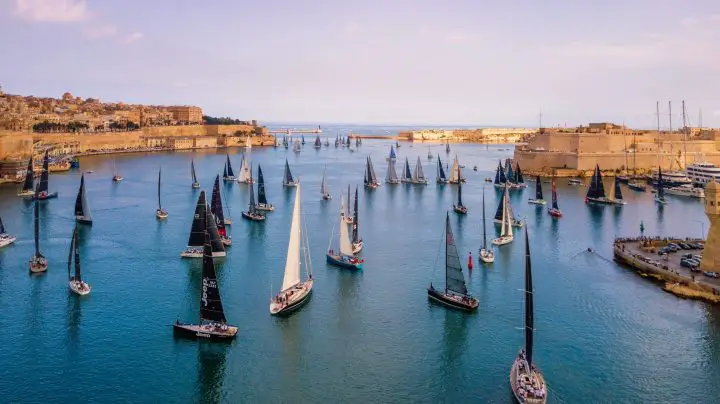
Most pleasure boaters contemplating a circumnavigation are interested in the safest route to sail around the world. Part of the safety and enjoyment of the crew comes from planning the trip to follow the prevailing wind patterns around the globe.
When sitting on land, you might think of the wind as unpredictable and variable depending on the day and weather conditions. And while that is true all over the world, at sea prevailing weather patterns tend to be more steady.
That means by understanding the causes and patterns in the winds, you can use them to your advantage on a circumnavigation.
For example, let’s look at the North Atlantic circuit. If a yacht wants to depart Europe for North America, its best bet is to head south first and follow the area between 10 and 30 degrees north latitude westbound. Why? Because this is the area where the winds flow from the east almost constantly. Since ships used these winds to get to the Caribbean in the old days, they are still known as the Trade Winds.
What if you want to go the other way, back to Europe? In that case, your best bet is to head north and make your easterly course between 40 and 60 degrees north latitudes. There, the prevailing winds are westerly and will push you back to Europe.
While sailboats can sail into the wind, doing so is called “beating” for a reason. It’s rough on the boat and crew; it’s tiring and unpleasant. You’ll have to do it occasionally, but a successful and comfortable passage is usually the result of planning so you don’t have to sail to weather.
Similarly, you can use the world’s ocean currents to your advantage. If the Gulf Stream can give you a knot or two of an extra push toward Europe, you should take it! It makes a big difference when your normal speed is six knots. Trying to fight against it for any length of time could double your trip planning and make for a very nasty ride.
And then there is the risk of storms at sea. With good trip and weather planning, a boat can circumnavigate without ever experiencing a bad storm at sea.
That requires conservative planning to avoid areas and times of the year when the weather is bad. To do this means you must plan to be in the right places at the right times. Pilot charts are published for every ocean sector on Earth, showing the prevailing winds for any given month and the probability of encountering a severe storm in the area.
Using pilot charts and the historical prevalence of hurricanes or cyclones, sailors can plan to transit these areas only during quiet times. In other words, no one wants to be in the middle of the North Atlantic during peak hurricane season or during winter gales, but being in the middle of the North Atlantic in May is pretty optimal.
Likewise, you don’t want to be in the middle of the South Pacific during February when it is peak cyclone season, but June or July is good.
The classic route for circumnavigating is based on the path of least resistance, making it the safest route to sail around the world. These routes utilize the prevailing winds to make as many downwind, fair-weather passages as possible.
The goal of this route is not speed but comfort and safety. This is the route you take your family on. This is the route that around the world rallies, like the World ARC Rally , use for every trip.
Starting from the Caribbean, this route travels westbound and keeps close to the equator. Of course, you can start anywhere, but many yachts cross their wakes (begin and end their voyage) somewhere in the Lesser Antilles.
After crossing the Caribbean Sea, transit is arranged through the Panama Canal. Canal transits are expensive and time-consuming, and they usually involve a broker to arrange all the paperwork and scheduling.
Before the canal was constructed, the only way to make the journey was to travel south in the Atlantic and pass Cape Horn. There, you can follow Drakes Passage through Argentina’s islands and Patagonia’s wild lands. Many expedition yachts still choose this route to see this remote and beautiful part of the world.
After the Panama Canal, most yachts take familiar sailing routes across the Pacific . The first stop is the Galapagos Islands. This takes you mostly south along the coast of Central America and across the equator into the Southern Hemisphere.
From the Galapagos, the single longest passage lies ahead–roughly 3,200 nautical miles to the Marquesas Islands of French Polynesia. This trip takes most sailboats about 14 days. An alternate route takes you farther south. It doesn’t shorten the trip but allows you to visit Rapa Nui (Easter Island) and Pitcairn Islands.
Once in French Polynesia, you can island hop your way through the South Pacific island nations, but with a weary eye on the weather. The point is to avoid the area during cyclone season, roughly the summer months (December through April or so).
At this point, many yachts find a hurricane hole where they can relax during storm season. Usually, it is time to haul out and complete some maintenance after so many sea miles. Some make it south and out of the cyclone belt to New Zealand or Australia. Others opt to stay in the islands but find a well-sheltered marina or boatyard where they can haul out.
Once cyclone season is winding down, the next big passage awaits. After passing through the Torres Straits, stops in Northwestern Australia and Indonesia welcome you to the Indian Ocean. There are only a few isolated stops after that. Many yachts make one long passage out of it, although many enjoy a few stops, like Cocos Keeling, Maldives, Diego Garcia, or Seychelles.
This is where the route branches in two directions. Traditionally, boats would transit on a northwest course and into the Gulf of Aden. From there, you follow the Red Sea to the Suez Canal and the Mediterranean Sea. The Mediterranean is, of course, one of the most storied cruising grounds on the planet. You can cruise from Turkey and Greece to Italy, France, and Spain, with countless famous ports of call along the way.
Unfortunately, the route to get there, through the Gulf of Aden and around the Horn of Africa, is home to bands of pirates who have been known to prey on leisure yachts and commercial vessels alike. For this reason, this route has fallen out of favor in recent years.
Instead, boats head to South Africa. The country makes a good landfall point from which you can travel home or take land excursions to see the rest of Africa. Popular stops on the way are the islands of Reunion and Mauritius. Some folks also like to visit Madagascar.
After rounding the Cape of Good Hope, yachts are back in the Atlantic and can head northwest toward the Caribbean. You can make a few stops along the way, mostly isolated island nations like St. Helena and Ascension Islands. After that, it’s a straight shot back across the equator and to the Windward Islands of the Caribbean.
When coming from the Mediterranean, boats heat westbound through the Straights of Gibraltar. The next stop is the Canary Islands. How long does it take to sail across the Atlantic? It’s a roughly 17-day passage downwind to the Windward Islands.
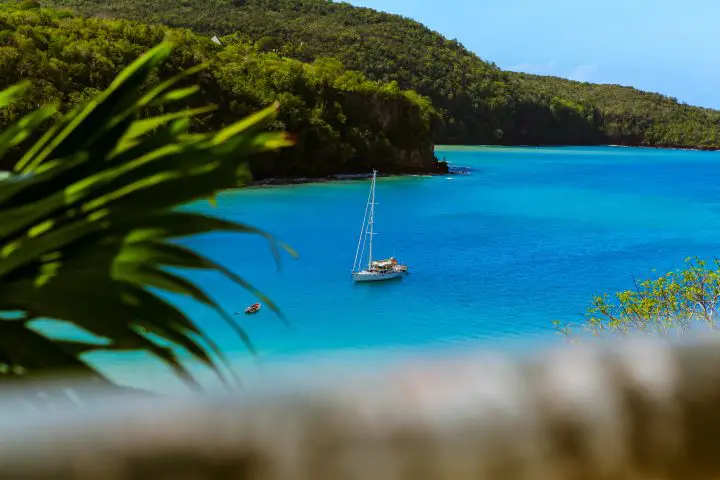
Most people take two full years or longer to complete a circumnavigation as described above, but even that only allows a little time to see the sights. So a more realistic number would be four or five years.
This route isn’t for those looking to get it done in the shortest amount of time. Instead, the Southern Ocean Route is the favored path for those looking to trade a bit of safety for speed. This route, due to the prevailing winds along the route, is completed from west to east.
Races like the Clipper Around the World , Vendee Globe , and the Golden Globe Around the World Race use this path. It utilizes the open expanses of the Southern Ocean. Once you get into these high latitudes, there are no real landmasses in your way, and you can steer a course all the way around the world in record time.
Of course, the Southern Ocean is not for the faint of heart. High-latitude sailing involves biting cold weather and dangerous gales. You’ll be rounding Cape Horn through Drakes Passage, one of the dicest stretches of water on the planet.
It’s a punishing stretch of ocean, and boats are often beaten and bruised. Dismastings and equipment failures are common. In other words, a sailor who chooses this route must be ready for anything, capable of handling whatever the sea throws at them, and sailing an extremely well-founded bluewater vessel.
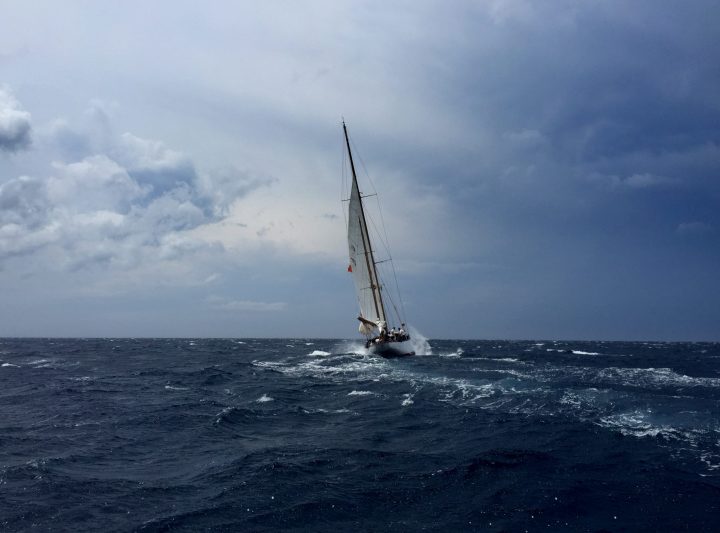
In recent years it has been in vogue to attempt a transit of the Northwest Passage, thereby making it possible to circumnavigate the high latitudes of the Northern Hemisphere. Obviously, this is a summertime endeavor only, and even then, only during years when the ice pack has completely melted. This is happening more and more, so the route is gaining popularity.
The leg that makes this possible starts from the United Kingdom going west across the Atlantic to Greenland through the Labrador Sea. The Northwest Passage itself then bisects Canada’s northern territories. Finally, you end up on the northern coast of Alaska. Then, keeping the mainland of North America to port, you continue south into the Pacific Ocean.
From the Aleutian Islands, the most favorable course is to transit to the west coast of North America. After that, you can make your way south along the famous Inside Passage, a network of fjords in British Columbia that can link you to Puget Sound and the Seattle metro area.
Once in the US, your next steps are southbound transits to Baja, Mexico, or jumps like sailing to Hawaii from California . You can then join the normal routes across the South Pacific islands to Australia or Southeast Asia.
Both the Southern Ocean and the Northwest Passage routes are high-latitude routes that carry more risk than the Milk Run. High-latitude sailing involves dealing with more frequent severe weather systems, stronger winds, and greater variability in the weather in general. They’re also farther from services and more remote, so self-sufficiency is even more vital.
While you can do the Milk Run in nearly any of best bluewater cruising sailboats , these high-latitudes routes are more comfortable in a robust expedition-level vessel. These are the perfect places for that aluminum sailboat you’ve been dreaming about.
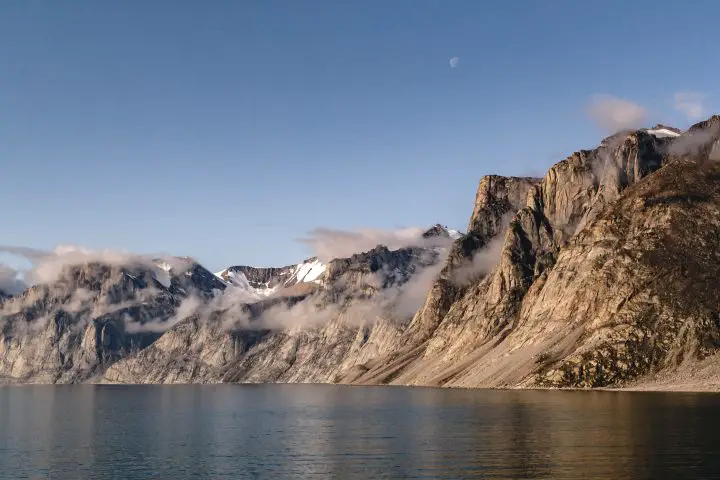
There is much to learn and think about if you want to circumnavigate. If you’re dreaming of sailing the world, consider starting your research by picking up a book or two written by someone who has done it. Here are three stories of circumnavigations, but there are countless others and blogs galore to be found on the internet.

- Add custom text here
Prices pulled from the Amazon Product Advertising API on:
Product prices and availability are accurate as of the date/time indicated and are subject to change. Any price and availability information displayed on [relevant Amazon Site(s), as applicable] at the time of purchase will apply to the purchase of this product.
Jimmy Cornell is the master of how to sail around the world. His “World Cruising” series of guides includes everything you’d ever need to know, from weather systems and route planning to legal formalities. This book, 200,000 Miles , combines some of those technicalities with a biographical story of his journey.

Sailing Around the World Alone is Joshua Slocum’s story of his journey. It’s not a modern tale–Slocum set out in the late 1890s from Nova Scotia. But his adventure is the OG tale of sailing around the world and is worth a read.

- Used Book in Good Condition
Lin and Larry Pardey circumnavigated several times (both eastbound and westbound), but if you totaled up the miles they sailed, it would be more like seven times. The difference, of course, is enjoying every port and stop along the way.
While they never wrote a book specifically about sailing around the world, their cruising tales live on in the various tales and how-to guides they produced over the years.
Capable Cruiser discusses techniques that will get you there, interwoven by the Pardey’s inimitable charm and wit. For more travel inspiration, check out their original series of books: Cruising in Seraffyn , Seraffyn’s European Adventure, Seraffyn’s Mediterranean Adventure, and Seraffyn’s Oriental Adventure.
What route do you take to sail around the world?
There are several ways to circumnavigate, but the most common is the “Milk Run.” This route goes from the Caribbean through the Panama Canal. From there, it heads south to the Galapagos Islands and into the South Pacific. After Tahiti, yachts head to Australia, across the Indian Ocean, and through the Suez Canal into the Mediterranean Sea. Finally, leaving the Med, boats cross the Atlantic to the Caribbean to close the circle, or “cross their wake,” as they say.
How long does it take to sail around the world?
The WorldARC around the world sailing rally usually lasts 18 months, but you can do it quicker by selecting fewer stops or taking faster routes. For most sailors, however, the length of the trip around the world really depends on how much they stop along the way and for how long. If the purpose of the trip is to travel and see the world, it makes little sense to rush and do it in the shortest possible time. Many circumnavigations take five or more years.
How much does it cost per month to sail around the world?
Sailing has been described as the most expensive way to get somewhere for free. The cost to sail around the world is extremely variable–it is impossible to pin down any price. On the one hand, the type of boat makes a difference. The larger the boat, the larger the costs. The lifestyle you choose while sailing matters, too–lavish resort marinas cost more than anchoring away from town. Hiring professionals to do boat maintenance costs more than doing it all yourself. There are ways to do it lavishly and ways to be cheap about it. Comfortable cruising is somewhere in the middle, but where exactly that depends entirely on you.
How big of a sailboat do you need to sail around the world?
Many solo sailors and couples have circumnavigated in boats less than 30 feet long. Lin and Larry Pardy wrote many novels as they circled the globe on 22-foot-long Seraffyn , a Lyle Hess-designed cutter. The size of the boat has everything to do with your cruising style and budget. So long as the vessel is well-founded and designed to take the rigors of bluewater passages, size matters less than many people think.
Matt has been boating around Florida for over 25 years in everything from small powerboats to large cruising catamarans. He currently lives aboard a 38-foot Cabo Rico sailboat with his wife Lucy and adventure dog Chelsea. Together, they cruise between winters in The Bahamas and summers in the Chesapeake Bay.
Leave a comment
Your email address will not be published. Required fields are marked *
Save my name, email, and website in this browser for the next time I comment.

Better Sailing
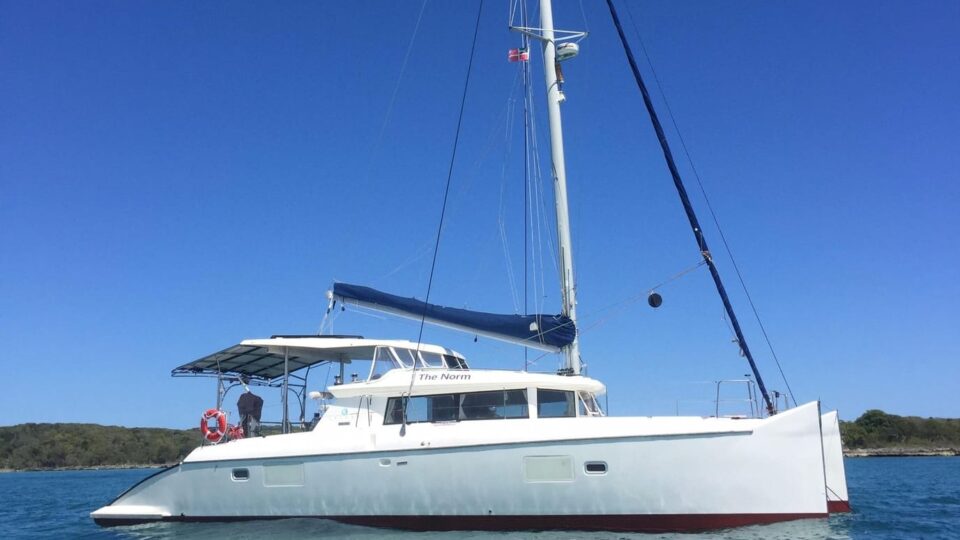
10 Best Catamaran Brands
Shopping for a new catamaran can be intimidating, even as consumers have more resources than ever to help them research from the comfort of their own home before they even contact a yacht broker. The great news is that there are a lot of great catamaran brands on the market right now. For us consumers, the catamaran market has evolved rapidly from what it was only just a few short years ago when monohulls were favored. On the flip-side, this can make it even more challenging to figure out which catamaran brands are the very best.
If you are a beginner in cruising catamarans, this article will help you learn the best brands that are out there with the best reputation amongst boaters. This article will help you get started in the world of catamarans, and I am trying to make it as beginner-friendly as possible. The catamaran brands on this list are mainly production boat companies, but some of them do offer custom designs. However, the added benefit of most of these brands is that there are many options on the used market. You will always be able to shop around for a good deal no matter where you are in the world.
Here are some of the best catamaran brands on the market today:
Lagoon – Groupe Beneteau
Lagoon is a French boatbuilder with an excellent reputation and sells the largest number of catamarans per year. The brand started back in 1984 and was one of the first catamaran brands to really convince people of the concept of multihulls. The philosophy of the Lagoon brand is good design, high-quality construction, and a decent cruising performance under sail. In other words, a Lagoon is the dream of every fan of sailing that looks for a catamaran that can provide everything, whether that is a fun toy for summer sailing trips or a year-round liveaboard yacht. What Lagoon did right, and the reason it has proven to be so popular is that it listened to its customers. That is why every new Lagoon catamaran has more space, more efficient layouts, and is always more comfortable than their previous version. There is no wonder why they have so many repeat customers.
Lagoon makes 9 sailing catamaran models and 2 powercat models, ranging in length from 40 to 78 feet. It also used to make shorted boats like the Lagoon 380 at 37 feet, but unfortunately, it was discontinued. You can find a Lagoon on the used market starting at $150,000 (like a 2002-2007 Lagoon 380) and as high as $5 million USD for their top of the line fully spec’d Lagoon Seventy 7, which comes with a jacuzzi on deck.
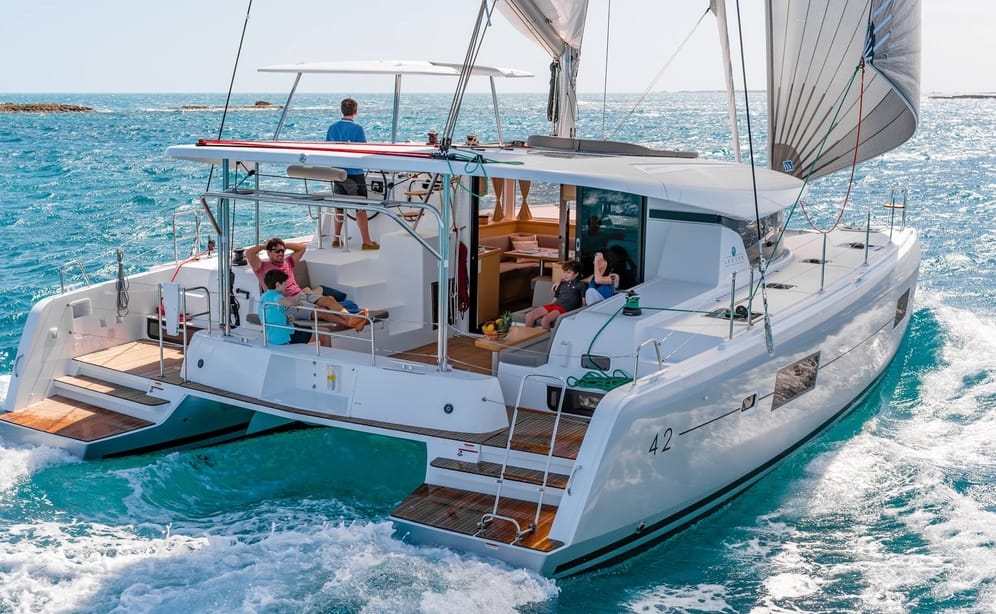
>>Also Read: Best Sailboat Brands
Fountaine Pajot
Fountaine-Pajot is a French maritime construction brand that is specializing in catamarans. The company was established in 1976, but it launched its first sailing catamaran in 1983 and its first powercat in 1998. This brand is now famous for building both sailing and power catamarans that have a beautiful and innovative design, superior handling, excellent seaworthiness, and cruising comfort. Also, Fountaine Pajot was one of the first catamaran brands that was manufacturing their boats with environmental protection in mind. So, all of their models have options to include renewable energy sources. Their ECO-Cruising and SMART-Cruising options considerably reduce their yachts’ carbon footprint and provide the necessary clean energy for their sailboats.
Fountaine-Pajot makes both sailing catamarans and powercats, ranging in length from 40 to 67 feet. It also used to make shorted boats like the Lagoon 380 at 37 feet, but unfortunately, it was discontinued. You can find a Lagoon on the used market starting at $100,000-150,000 (like a 1990-2005 Fountaine Pajot Athena 38) and as high as $3.5 million USD for their top of the line fully spec’d Fountaine Pajot Alegria 67, which comes with a jacuzzi on the front deck.

Leopard is a boatbuilder located in South Africa and produces some of the best and most luxurious catamarans. You will find Fountain Pajor catamarans for sale also under the name “Robertson & Caine” because some Leopard cats are built by Robertson & Caine company. Leopards are mainly designed to be luxurious, big, and comfortable, but that usually comes at a cost, both in price tag and sailing speed and maneuverability.
Leopard Catamarans was established in 2000 their partnership with South African builder Robertson and Caine. This company was manufacturing custom-designed catamarans for the global yacht charter company The Moorings. While Leopard was focusing on sailing catamarans in the beginning, in 2007, they started making powercats as well.
Leopard is always designing their boats to have the optimal balance between interior space and performance, sheltered helm cockpit designed for offshore cruising and single-handed sailing, large lounge areas, optimal comfort, and ease of maintenance.
Nowadays, Leopard is making sailing catamarans between 42 and 58 feet and powercats between 50 and 53 feet. You can find a Leopard on the used market starting at $180,000 (like a Leopard 38) in good condition and as high as $2 million USD for their top of the line fully spec’d Leopard 58; however, they are not as luxurious as some of the other brand’s top-of-the-line models.
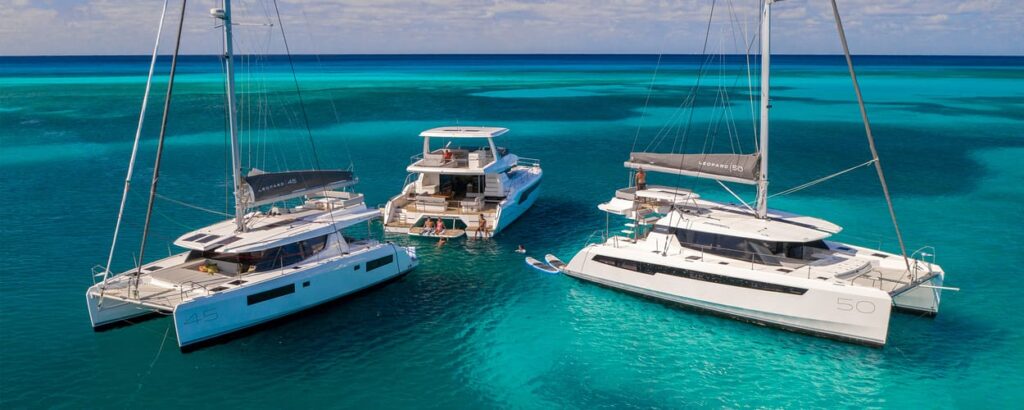
>>Also Read: 10 Best Catamarans Under 200k
Catana catamarans are a little bit more performance-oriented. They have features that make them sail faster and be more easily maneuverable than some of the other catamaran brands on the list. Many of their boats come with a feature called daggerboard that will help you sail faster upwind, something that most catamarans struggle with. Catana Group was originally called Poncin Yachts and has been building catamarans in France since 2001. It is famous for producing catamarans for owners who most often want to go bluewater sailing around the world comfortably and safely with a high-performance boat. This is not a famous brand, but it grows in popularity very fast. Year by year, I have noticed more and more Catana catamarans in the marinas I visit.
Catana Catamarans are built using foam sandwich vacuum infusion technology combined with carbon and aramid fiber. This combination guarantees the strength of the hull, significant weight savings, and because of this fact, higher speed.
Catana offers new boats from 42 to 70 feet. In the past, they were building boats as long as 90 feet. You can find a Catana on from the early 2000s’ on the used market for as low as $250,000, and as high as $4 million USD for a top of the line full spec’d brand new one.
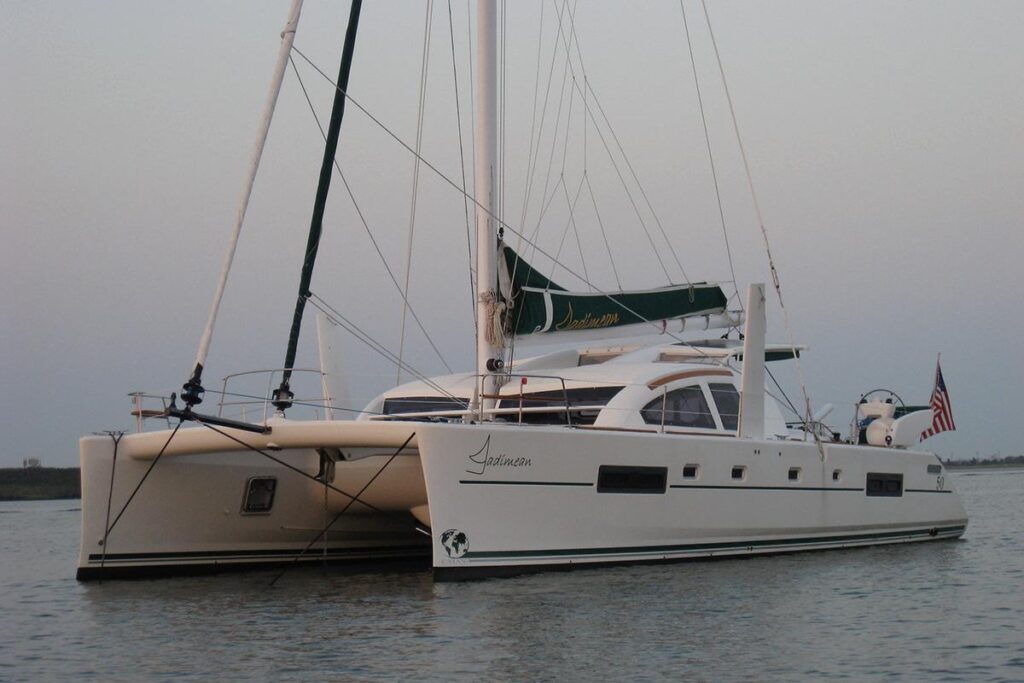
Nautitech is another catamaran brand located in France; I guess there is a pattern here. They have built a reputation for designing catamarans that are robust, seaworthy, and capable of putting sailing back into the heart of the liveaboard experience without compromising on comfort. Anyone familiar with catamarans can quickly appreciate the innovative nature of a Nautitech cat design. The brand was also the first one to introduce the concept of liveaboard living, which combines the saloon and cockpit into one spacious, functional living area.
Nautitech offers new boats from 40 to 57 feet. You can find a Nautitech on from the early 2000s’ on the used market (Like the Nautitech 40) for as low as $180,000. However, a new top-of-the-line Nautitech 54 can be spec’d up to $1.5 million USD; though, they are not as luxurious as some of the other brand’s top-of-the-line models.

The brand was founded in 1985 in France. Privilège Catamarans offer unparalleled expertise, know-how, and experience that facilitates the construction of some of the best catamarans on the market today. They can provide luxurious liveaboard life beyond coastal borders. Its elegant hull design ensures superb stability and comfort making then one of the best catamaran brands in the world right now. Every catamaran is custom-built according to the owner’s preferences and handcrafted with great craftsmanship and the finest materials.
The company specializes in the design and manufacture of some of the best, and luxurious bluewater catamarans on the water. Every new Privilege cat is built after multiple consultations between the shipyard and the owner. You can decide to either keep the catamaran in its pure and elegant look and also keep the cost as low as possible or to change it to your personal preferences and make it as high-end as you can afford.
Privilège makes both sailing catamarans and powercats, ranging in length from 51 to 75 feet. It also used to make shorted boats like the Privilege 435 at 43 feet, but unfortunately, they are now focusing on larger yachts. You can find a Privilege from the early 2000s’ on the used market starting at $300,000 (like the Privilege 435) but can easily surpass $5 million USD for their top of the line fully spec’d Privilege 745 or 740.
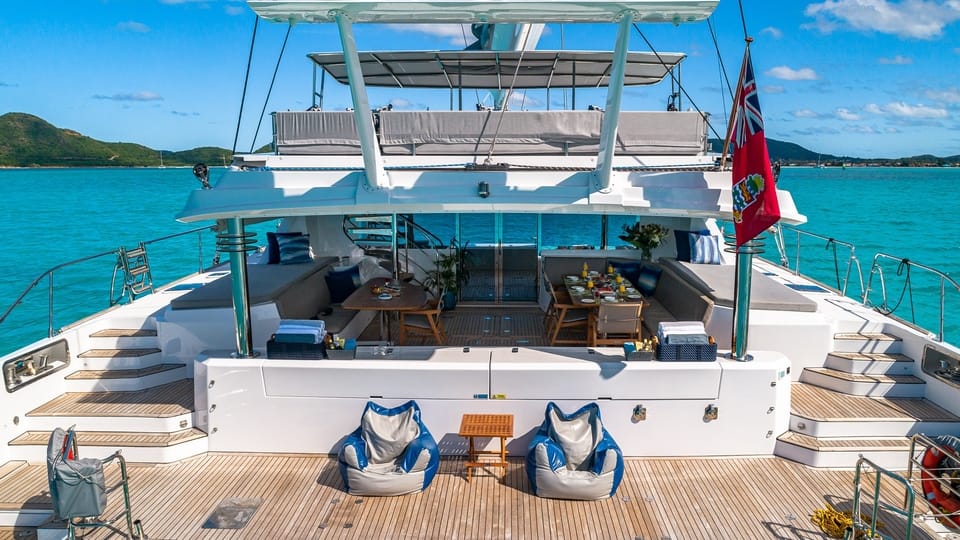
>>Also Read: Best Small Sailboats To Sail Around The World
Gemini
Gemini is one of the few catamaran brands that make its boats in the US. It is a subsidiary of Performance Cruising Inc., and they have been making catamarans since 1981. Honestly, Gemini catamarans might not be the most good-looking and luxurious, but they are affordable and sail well. For that reason, they definitely deserve a spot on the list with the best catamaran brands.
You can find a used Gemini cat in good condition in good condition from the early 1990s, starting at around 50k and a newer model for as high as 500k. Overall this is a very affordable brand, and you will definitely enjoy one without breaking the bank.
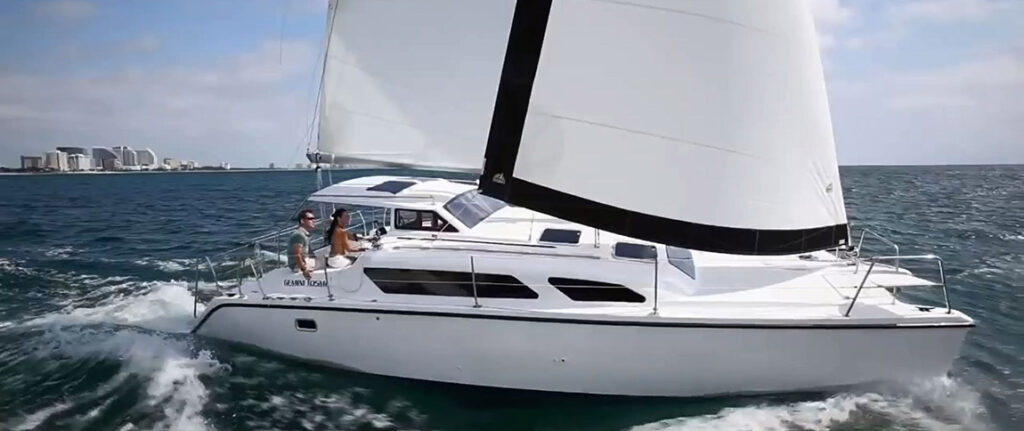
Seawind
Seawind Catamarans is a catamaran designer and builder located in Australia, producing high-end performance cruising sail catamarans since 1982. They have produced some of the world’s best and award-winning designs.
The Seawind brand is especially good for people looking for a catamaran that is not overly luxurious or expensive and is probably looking for a more reasonably sized yacht; however, they do offer a couple of larger, more luxurious models as well.
Seawind offers new boats from 35 to 52 feet. You can find one on from the early 2000s’ on the used market for as low as $150,000, like a Seawind 1000. However, a new top-of-the-line Seawind 1600 can be spec’d up to around $1 million USD.
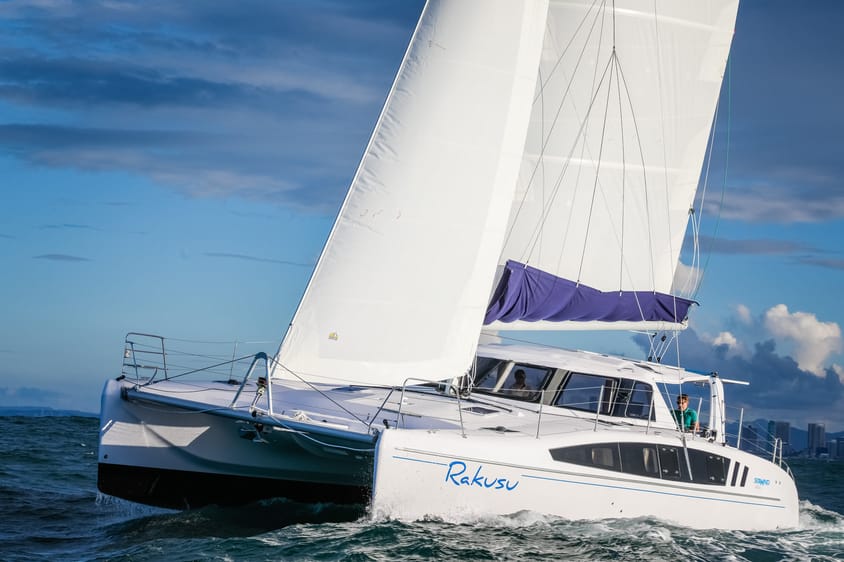
Sunreef Yachts
Sunreef is the world’s leading manufacturer of luxury sailing and power multihulls. Each catamaran, motor yacht, and superyacht they make is a custom vessel. The company was established in 2002 in Gdansk, Poland but a Frenchman and was the first brand to build a 74-foot bluewater cruising catamaran.
This brand has pulled all the stops when it comes to luxury and comfort. Whether you are looking for a family-friendly liveaboard cat, a luxurious private floating villa, a dazzling party boat, or a fishing expedition superyacht fantasy, their designers will turn your vision into reality. Just be prepared to pay the price.
Sunreef makes both large sailing catamarans and powercats, ranging in length from 50 to 150 feet! You can find a Sunreef from the early the Mid-2000s on the used market starting at $700,000 (like the Sunreef 62) but can easily surpass $15 million USD for Sunreef 102. They also have the Sunreef MM460 CAT on their catalog, which is one of the largest catamarans even created. However, unfortunately, I was not able to get even an approximate price quote on it. If I had to guess, I would say at least $50 million to have one built.

>>Also Read: Best Sailboats Under 100k
Bali Catamarans is another brand of the well-known Catana shipyard. And it is also the newest brand on the list established in 2014. Catana catamarans are the golden standard when it comes to high-speed cats. However, in 2014, they decided to start a production brand of fast, light, and easily maneuverable cruising catamarans. The Bali Catamarans collection has a unique design mainly; it has no mesh “trampoline” in the front cockpit. It features an open-space interior, a huge refrigerator in the inner saloon, and many other uncommon features.
Bali offers new boats from 39 to 50 feet. You can find a Bali on from 2014-2015 on the used market for as low as $300k (like the Bali 4.0). However, a new top-of-the-line Bali 5.7 can spec’d up to over a $2 million USD.

Final Thoughts
In order to compile the best list of catamarans, I took into account the built quality, comfort seaworthiness but also the number of yachts for sale on the used market. In my point of view, I shouldn’t have put a custom catamaran builder on this list because you wouldn’t be able to find one for sale anyway. For most of these brands, there are many boats for sale on the used market in pretty good condition and at reasonable prices.
Peter is the editor of Better Sailing. He has sailed for countless hours and has maintained his own boats and sailboats for years. After years of trial and error, he decided to start this website to share the knowledge.
Related Posts

The Ultimate Guide to Choosing the Best Fishing Line for Trolling

Lagoon Catamaran Review: Are Lagoon Catamarans Good?

Best Inboard Boat Engine Brands

Are O’Day Sailboats Good? A Closer Look at a Classic Brand
- Buyer's Guide
- Destinations
- Maintenance
- Sailing Info
Hit enter to search or ESC to close.
- Outremer 45
- Outremer 4X
- Outremer 4.zero
- Outremer 52
- Outremer 55
- Outremer 51
- Outremer 5X
- All the Outremer Fleet
- Personalized support
- Blue Water Sailing Seminars
- Our concept
- The Outremer team
- Our commitments
- Construction principles
- Our catamaran services
- After-sales customer service & Quality control
- Offshore Connected Catamaran Maintenance
- Concierge Services
- Our owners’ stories
- FAQ – Outremer catamarans

- Brokerage: used catamarans for sale
- Privacy Policy
- Legal Notice
- Grand Large Yatching
Virtual tour
Characteristics, technical specifications.
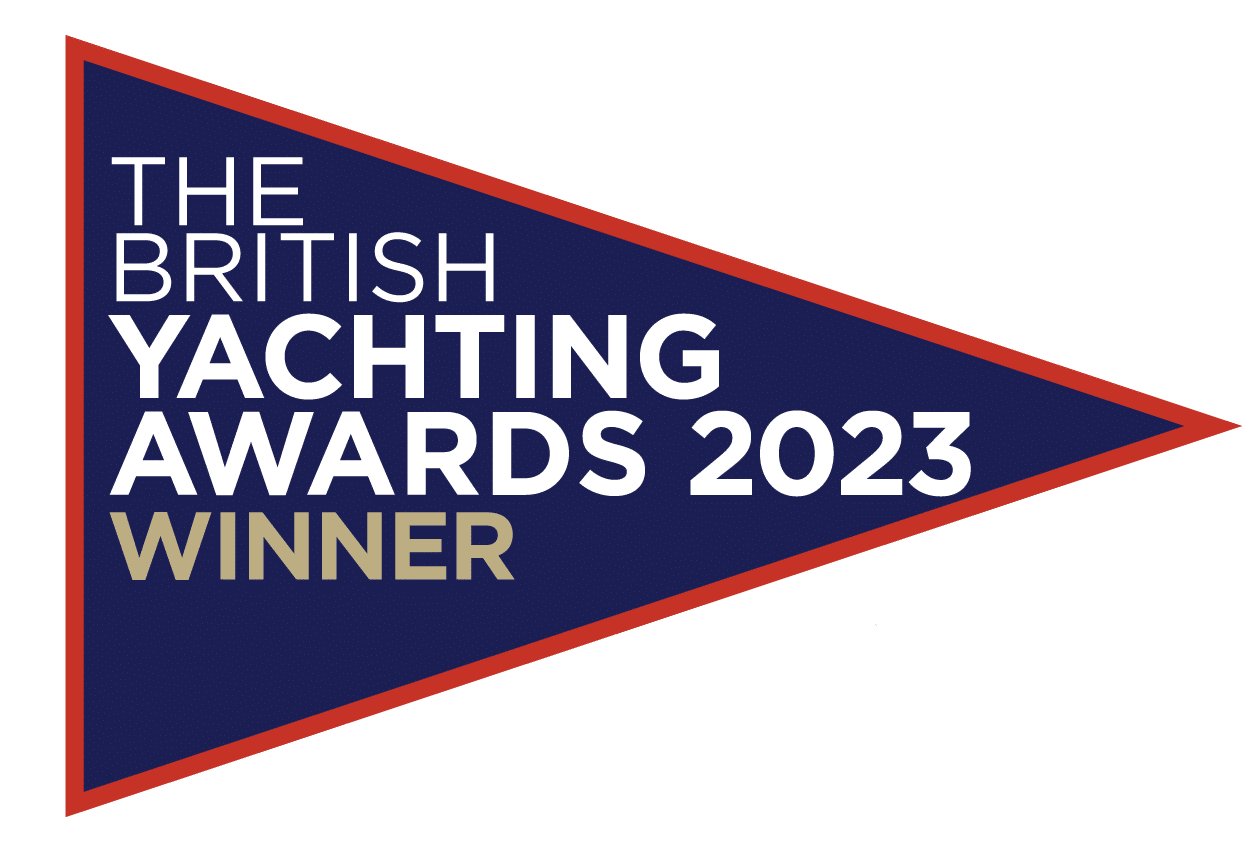
Our 52-foot catamaran, the best of two iconic models
Request information.
Seaworthy and smart for the ultimate cruising experience
The avant-garde, new benchmark for blue-water cruising
The Outremer 52 has been designed based on the observation of the owners’ needs and uses. While performance and safety have always been the basis for the design of Outremer blue water catamarans, simplicity of navigation and quality of life on board are the two essential components that completes the specifications of Outremer teams. Surrounded by the best naval architects (VPLP), and great names in French design (Patrick Le Quément, Darnet Design, Saguez & Partners), the Outremer shipyard has engineered a smart and seaworthy 52-foot catamaran for the ultimate bluewater cruising experience.
Download the brochure

Outstanding visibility
Since the performance of a catamaran is largely determined by its weight, ingenuity was required to build the structure of this new model. An innovative technology developed by the Gunboat shipyard (also a member of the Grand Large Yachting Group), has made it possible to reduce the weight of the structure, while maintaining a high level of resistance. This has made it possible to increase the glass surfaces and openings in the boat that allows crews the reassuring benefit from increased visibility during navigation, regardless of their position in the saloon or cockpit.
Whether for ocean crossing, sailing around the world, or along the coast, this 52-foot catamaran will make sailors and their families feel both safe and comfortable on their liveaboard boat.
Improved user experience
This new model has been designed to make life on board easier in all circumstances. While it benefits from the upgrades of the Outremer 55, such as the different helm positions, the front view from the saloon and the helm bench adapted for two people, the Outremer 52 goes even further. The architectural communication between the interior and exterior living spaces allows for better watchkeeping on board: at the bar area in the cockpit, for example, it is possible to have a meal while continuing to keep watch ahead. At night, watches can be taken from the saloon’s bench which was designed in the direction of the navigation.
Inviting space
Everything has been carefully thought out to allow the enjoyment of every aspect of life on board. The Outremer 52 is a blue water cruising catamaran filled with natural light, offering living spaces adapted to long voyages. The common living spaces have been designed to facilitate circulation on board, to extend the feeling of wide-open spaces and to allow for festive moments with family or friends. The full opening of the bay window allows easy circulation and creates a convivial space between the cockpit and the saloon. The kitchen’s work surface is open to the interior and exterior spaces of the catamaran, and will undoubtedly be a privileged place to meet at any time of the day.
Customized and modular interior designs
To meet the very different needs of each catamaran owner, Outremer has designed a modular space called My Free Space. Located in the port forward cabin, this space can cover five different uses:
- a double cabin
- a convertible office with bunk beds
- a modular cabin, with an office convertible into a workshop, a folding bench and numerous storage spaces
- a dressing room
- a child’s cabin
| Architects | VPLP Design |
|---|---|
| Design consultant | Patrick Le Quément |
| Interior designer | Darnet Design |
| Length | 51.6 ft |
| Beam | 25.9 ft |
| Draught | 3.5 ft/ 6.7 ft |
| Air draught (without antenna) | 75.5 ft |
| Displacement | 12,5 t / 15,7 t |
| Sail plan - Mainsail - Genoa - Selftacking jib - Gennaker (optional) - Spinnaker (optional) | |
| CE approval | 8/26 p |
| Engines | 2 x 50 HP |
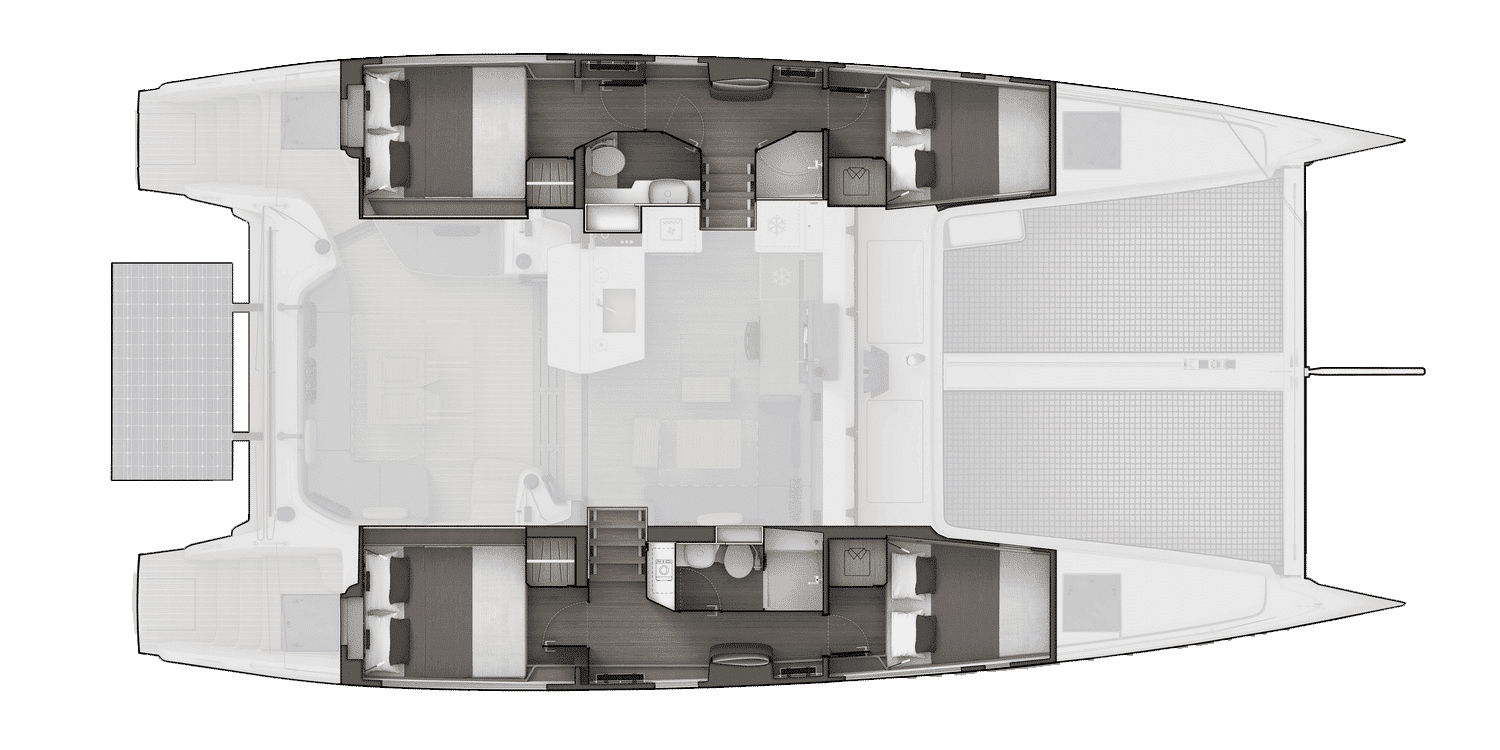
Beyond building your boat, Outremer brings your dreams to life by being by your side at every stage of your project. To always better support you, we have created Outremer Services. This structure, integrated within Grand Large Services is able to meet all your needs, from the start of your project to the resale of your catamaran.
Seminars on the theme of blue-water cruising, training on land and at sea, charter, concierge services, refit, a network of approved partners around the world, OCM ™ e-maintenance and lastly brokerage. We offer complete and personalized support according to best fit your needs.
Impatient, not sure you can invest in a new catamaran or simply curious? See our latest second-hand boats on offer. Please note that the demand is high, don’t wait to contact us.
Charter an Outremer
SHORT TERM CHARTER WITH SKIPPER
From the legendary Outremer 45 to the acclaimed Outremer 55, not to forget the 51 and the 4X, you will find a wide range of Outremer catamarans to charter, depending on your model of interest.
672 Wine Club
- Motorcycles
- Car of the Month
- Destinations
- Men’s Fashion
- Watch Collector
- Art & Collectibles
- Vacation Homes
- Celebrity Homes
- New Construction
- Home Design
- Electronics
- Fine Dining
- Aston Martin
- Dubai Tourism
- Gateway Bronco
- On Location – Olympic Games Paris 2024
- One&Only
- The Ritz-Carlton, Kapalua
- St. Regis Costa Mujeres Resort
- Sports & Leisure
- Health & Wellness
- Best of the Best
- The Ultimate Gift Guide
- This New 94-Foot Foiling Catamaran Can Fly Across the Seas at Over 50 Knots
Voodoo's new XF95 also has a range of 3,500 nautical miles.
Rachel cormack.
Digital Editor
Rachel Cormack's Most Recent Stories
- Queen Camilla Wore the Historic Diamond Diadem at the State Opening of Parliament
- Ray-Ban Owner EssilorLuxottica Is Buying Supreme for $1.5 Billion
- Share This Article

Voodoo Yachts has conjured up some more marine magic.
Related Stories
- Ferrari Confirms Its First Electric Car Is Coming Next Year
- Lucid Says Its New Electric Car Is the Most Efficient Production EV Ever Made
- How the Dodge Viper Brought Chrysler Back From the Dead

The X95 can be equipped with two engines rated at either 2,000 or 2,600 hp. The latter option enables a cruising speed of 37 knots and a top speed of 45 knots. Voodoo says there is also another, more powerful setup that results in a top speed of more than 50 knots. In terms of range, the vessel can cruise for 1,200 nautical miles at 30 knots or cover 3,500 nautical miles at eight knots. Owners can add a larger tank to increase the range or install a large solar array to generate clean, green power at sea.
With a beam of 31 feet and an interior volume of 245 GT, the X95 offers nearly 5,400 square feet of space on board. The yard says the spacious living quarters are on par with yachts spanning 118 to 125 feet. The model is highly customizable, too: Owners can opt for an enclosed or open bridge and choose between several different layouts.
As standard, the yacht is outfitted with five guest staterooms and two crew cabins. One configuration has a full-beam owner’s suite in the bow of the lower deck, four en suite guest cabins amidship, and a garage aft. The main deck features a large salon and dining area, while the upper deck showcases a plush lounge. Owners can add other interior features such as a sauna, gym, or home theatre.
Marine magic, indeed.
Rachel Cormack is a digital editor at Robb Report. She cut her teeth writing for HuffPost, Concrete Playground, and several other online publications in Australia, before moving to New York at the…
Read More On:
More marine.

This New 170-Foot Sailing Yacht Has a Jacuzzi Hidden Beneath Its Mast

Maserati’s First Electric Boat Delivers Style and Fun on the Water—We Took It for a Spin

The Ritz-Carlton’s Massive New 790-Foot Megayacht Just Hit the High Seas

This New 55-Foot Sailing Catamaran Will Be Made From Scrap Metal and Reclaimed Wood

Meet the Wine Club That Thinks Differently.
Receive editor-curated reds from boutique California producers four times a year.
Give the Gift of Luxury
Latest Galleries in Marine

‘Reposado’ in Photos

Admiral Quaranta Superyacht in Photos
More from our brands, dior and armani respond to italian competition authority probe into supply chain, florida ag lands look at acc media rights contracts, charlize theron says ‘old guard 2’ post-production got ‘shut down’ by netflix, but the sequel will come out ‘soon’: ‘i really love this movie’, new art initiative 0xcollection is on a mission to institutionalize digital art, the best yoga mats for any practice, according to instructors.

Son of the late inventor of the modern catamaran follows in his father’s legacy
H ONOLULU (HawaiiNewsNow) - Woody Brown Jr. is the keeper of a family legacy. The treasure in his chest is a twin-hulled sailing craft commonly called a catamaran.
“You see catamarans all around the world, but a lot of people don’t know it was created right here in Hawaii,” he said. “I want to make sure we keep that going for as long as we can.”
He says that because the modern-day catamaran was created by his father, Woody Brown Sr., a legend to many who know about his history and his love of the sea.
“He was a glider pilot, a surfer, and a sailor,” Woody Jr. said.
His catamaran, the Manu Kai, started the family business that’s been a fixture on the Waikiki Beach shoreline for decades.
Woody Sr. had his son very late in life. Woody Jr. didn’t fully grasp what his dad had done until he was older.
“Hearing all the stories from all the old-timers and realizing how much of an impact he gave to all these people, that’s when I started realizing, ‘Dang! I’m really lucky and blessed to be a part of this family and legacy,’” he said.
That’s why he has been living in Washington State for the past two years. He built a new catamaran for the family’s company, seeing it through design, construction, and trials at sea. It’s named Hawea after his daughter.
“The boat sails amazing!” he said. “It’s a pretty quick book. Very smooth, quick, slick. Beautiful boat. It’s a little more modern than the original style that was built.”
Now, he and his crew are sailing the boat from the mainland West Coast to the shores of Waikiki, a trip he hopes will take a couple of weeks. It’s his first trans-Pacific crossing.
“It’s not crazy out there in the Pacific Ocean with the exception of hurricane season. They call it the Golden Month where in July you get the nice consistent trades that take you right to Hawaii,” he said.
After it’s docked at Ala Wai harbor, Woody Jr. will file the paperwork to put Hawea to work for the Brown family’s Waikiki Sailing Company. It replaces his brother’s boat, which has been working off Waikiki Beach for about 50 years.
This is how Woody Jr. is paying tribute to his father, who passed away in 2008.
“I think he would be very proud of me. He built his own. My brother built his own. So I felt I needed to do this myself and be a part of the whole build process from state to finish,” he said.
To follow Hawea’s journey across the Pacific and to see video updates of the crew and catamaran at sea, go to this link here .

Meet the only sport in the world awarding competitors for sustainability
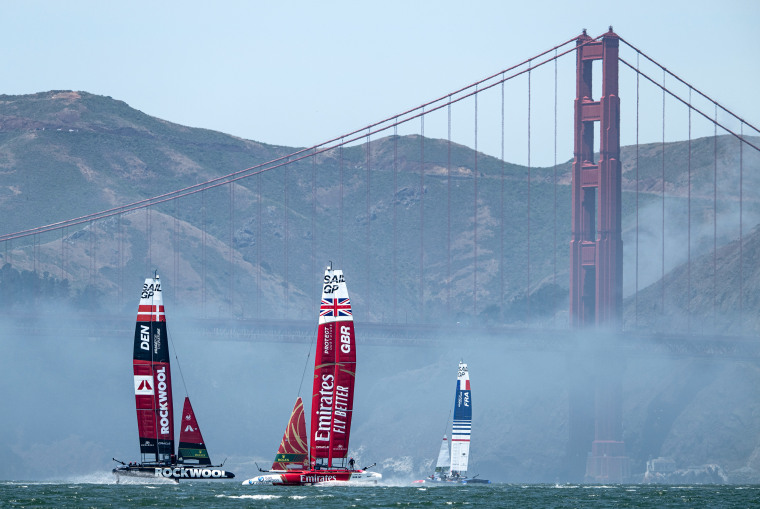
SailGP, in which 50-foot catamarans race at more than 60 mph in seas and bays around the world, is a grand prix sport comparable to Formula 1 but on water. One big difference: It is seeking to make a positive impact on issues of sustainability.
In addition to vying to be the fastest, teams also compete to have the biggest impact on the league and in host cities. An entirely different scoreboard, called the Impact League, measures teams' impact on things such as sustainability, commitment and strategy; their use of new technologies and innovation; their promotion of clean energy; and their ability to avoid waste and single-use plastic.
The champion for this season on positive impact is the Emirates Great Britain team, the league shared first with NBC News.
The team partnered with a bespoke renewable energy provider to incorporate solar panels on its team base that not only powers its base, but a number of other nation’s team bases.
“I’d be lying if I said that it doesn’t get just as competitive as it is on the water,” said Ben Ainslie, CEO of Emirates Great Britain SailGP team. “But at the same time we also get points for collaboration. And of course that’s the right thing to do when you’re looking at tackling issues around climate change. … Collaboration is key.”
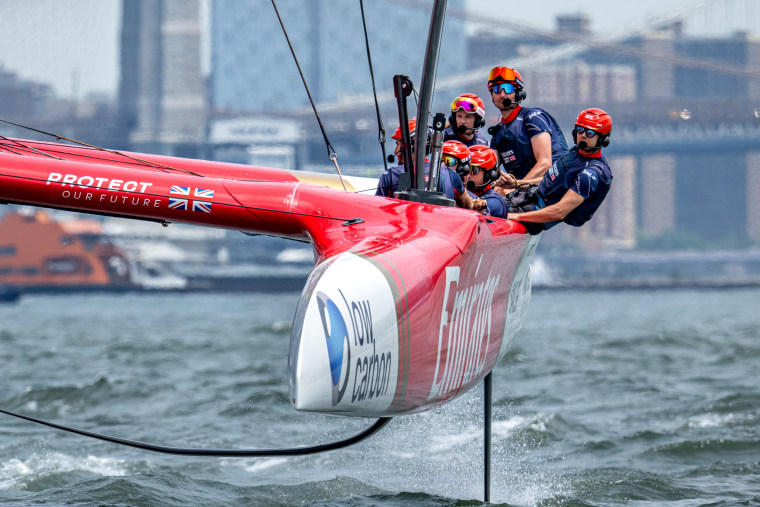
Grand Prix races that burn fossil fuels are currently trying hard to figure out how to curb their carbon emissions. According to Formula 1, with 10 teams, 20 cars and 23 races in different countries, F1 emits approximately over 256,000 tons of carbon dioxide every season, the same amount as a small nation. Meanwhile, travel for players and fans, in addition to stadium power use, contributes to high emissions by the NFL, MLS, NBA, NHL and MLB.
Which is why SailGP, a sport powered by the wind, tries to take it a step further. At each race around the world, teams undertake an impact project to leave the environment in the area better than they found it. Those projects range from engaging youth in climate education and literacy to beach and ocean cleanups.
These events bring together leaders, sustainability champions, partners, industry leaders and athletes to promote, and educate on, climate action and inclusivity through sailing. Since its initial launch in 2021, the impact league has hosted 14 events across 11 cities, nine countries and four continents.
“It’s something that we’ve found has been really inspiring, both for the teams, and also for the fans,” said Ainslie.
Fiona Morgan, the league's Chief Purpose Officer, joined in 2020 to spearhead SailGP’s sustainability and impact agenda both within the league and through external partnerships. The goal is to transition the league to net zero carbon emission and use sport to inspire global change.
“Sport has this power to talk to fans like no one else. And if we can educate them to be kind of imperfect climate activists, or even understand their carbon footprint, or even do one thing differently, we will help change the world,” she said. “Sometimes people look at sport (and) criticize where you race or who you sponsor. It’s like our superpower is engaging our consumers, and we have billions of them globally. So that’s what I think I really want sport to kind of lean into that talk to its fans.”
Although the catamarans are powered by nature, the league still relies on dozens of chase boats that burn fossil fuels. Morgan said the general lagging of decarbonization solutions within the maritime industry leave the league no other options.
“I think what’s really cool about our sport is that our playing field is the ocean,” said Mike Buckley, CEO and member of the United States SailGP team. “No other sports property in the world can say that.”
Ainslie encouraged other sports with large fan bases to start making more of an impact in the sector.
“Some of the more established sports, imagine the number of people that they could reach,” he said. “A really great thing about sport is it’s so inspirational, particularly for younger generations. So I think it’s on all of us as sports people to be good role models and set the examples to, and that’s where the impact league really is really standing out.”
The push from SailGP comes as much of the U.S. has already dealt with extreme weather fueled by human-caused climate change this summer. Due to high ocean water temperatures, the tropics saw its earliest ever major hurricane in Beryl and, according to Climate Central, the recent heat wave in the West was five times more likely due to climate change, with the city of Las Vegas currently in its seventh day of over 115 F temperatures.
Lucas Thompson is a producer for the NBC News Climate Unit.
Ariel Weil is an intern on the NBC News Climate Unit.
Local News | Photos: SailGP Season 4 Grand Final this…
Share this:.
- Click to share on Facebook (Opens in new window)
- Click to share on Twitter (Opens in new window)
- Click to print (Opens in new window)
- Click to email a link to a friend (Opens in new window)
- Click to share on Reddit (Opens in new window)
Today's e-Edition
- Things to Do
- Real Estate
- Marketplace
Breaking News
Local news | santa clara county coroner: 3-year-old ellie lorenzo died from ‘head trauma’, local news | photos: sailgp season 4 grand final this weekend in san francisco, top sailors from around the world compete on f50 foiling catamarans.

Top sailors from around the world will reach speeds of up to 60 miles per hour as they compete in this weekend’s Sail GP Season 4 Grand Final in San Francisco.
Boats from Australia, Canada, Denmark, Emirates Great Britain, France, Germany, New Zealand, Spain, Switzerland, and the USA. Following 13-events of intense racing at the most iconic venues in the world, the F50 fleet returns to San Francisco to decide the ultimate winner of Season 4 and battle it out for a $2 million-dollar prize pot.
To achieve these top speeds, the F50’s hydrofoils lift the boat out of the water to reduce drag, and they use a vertically-mounted airplane wing as a sail. Each boat has a crew of five members, consisting of a helmsman, wing-trimmer, flight controller and two grinders.
SailGP has an ongoing commitment to embed environmental and social sustainability into the fabric of sport and they also run the Inspire program, a community, education and outreach initiative for youth.
The event takes place on Saturday and Sunday near the St. Francis Yacht Club by Marina Green. Click here for more info on the races and to buy tickets for special grandstand viewing.
Update: The Spanish SailGP Team won their first SailGP Grand Final, upsetting the Australian team who’ve won the title the past three years.
“Beating the Kiwis and Aussies in the Grand Final here in San Francisco – it’s amazing. We’re over the moon. It’s been a big grind and we’ve been through a lot in this League,” said helmsman Diego Botin of the Spain SailGP team.

- Report an error
- Policies and Standards
More in Local News

Crime and Public Safety | Oakland police ID teen killed in shooting falsely reported as San Francisco homicide

Crime and Public Safety | Alameda man charged with sexual assault spree: Police say he raped pregnant woman, attacked two others

Transportation | SamTrans to study building a bus-only lane connecting Dumbarton Bridge with several cities on the Peninsula

Local News | Milpitas unveils 102 affordable apartments near Great Mall
- Election 2024
- Entertainment
- Photography
- AP Buyline Personal Finance
- AP Buyline Shopping
- Press Releases
- Israel-Hamas War
- Russia-Ukraine War
- Global elections
- Asia Pacific
- Latin America
- Middle East
- Election Results
- Delegate Tracker
- AP & Elections
- Auto Racing
- 2024 Paris Olympic Games
- Movie reviews
- Book reviews
- Financial Markets
- Business Highlights
- Financial wellness
- Artificial Intelligence
- Social Media
Delapierre steers French cat toward a spot in SailGP’s $2 million, winner-take-all Grand Final
- Copy Link copied
Quentin Delapierre skippered France to finishes of 1-3-3 in a remarkable performance Saturday on San Francisco Bay to move close to advancing to SailGP’s $2 million, winner-take-all Grand Final, the biggest payday in sailing.
Three-time defending SailGP champion Tom Slingsby steered Australia’s Flying Roo 50-foot foiling catamaran to finishes of 5-1-8 to all but assure a spot Sunday in the Grand Final, which will follow the conclusion of the San Francisco regatta.
Peter Burling and the Team New Zealand Black Foils have already secured a spot in the Grand Final after winning five of the previous 12 regattas in Season 4 of tech billionaire Larry Ellison’s global league. The Kiwis finished fourth in all three fleet races and simply need to get through Sunday’s fleet racing in one piece and with no major penalties to move on to the start line of the Grand Final.
Delapierre needs to leapfrog Spain’s Diego Botin in the season standings to reach the three-boat Grand Final. He’s on track after he and his crew had great starts and expertly sailed their catamaran around the course.
Botin came into this regatta in third place overall, five points ahead of Delapierre. But he struggled in the strong wind and had finishes of 7-6-5 to sit in seventh place in the regatta.
Slingsby won all three previous three SailGP championship races on San Francisco Bay. The prize money was doubled this season from the previous $1 million. San Francisco Bay is also where Slingsby helped Ellison’s Oracle Team USA stage a stunning rally against Emirates Team New Zealand to defend the America’s Cup in 2013.
Bernie Wilson has covered sailing for the AP since 1991.
AP sports: https://apnews.com/hub/sports

- CLASSIFIEDS
- NEWSLETTERS
- SUBMIT NEWS
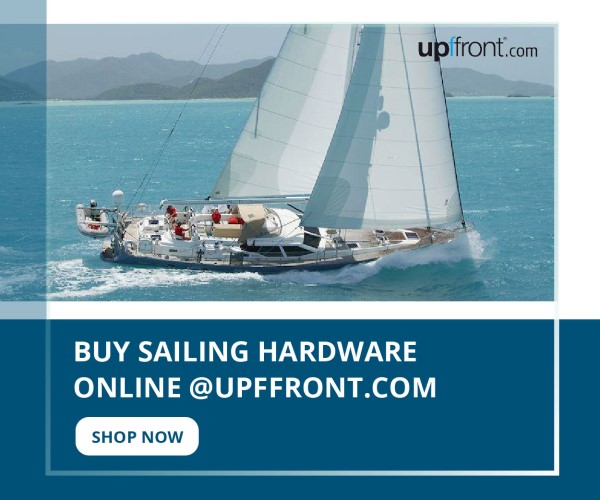
Canadians in fight to survive into SailGP Season 5 and recover Halifax venue
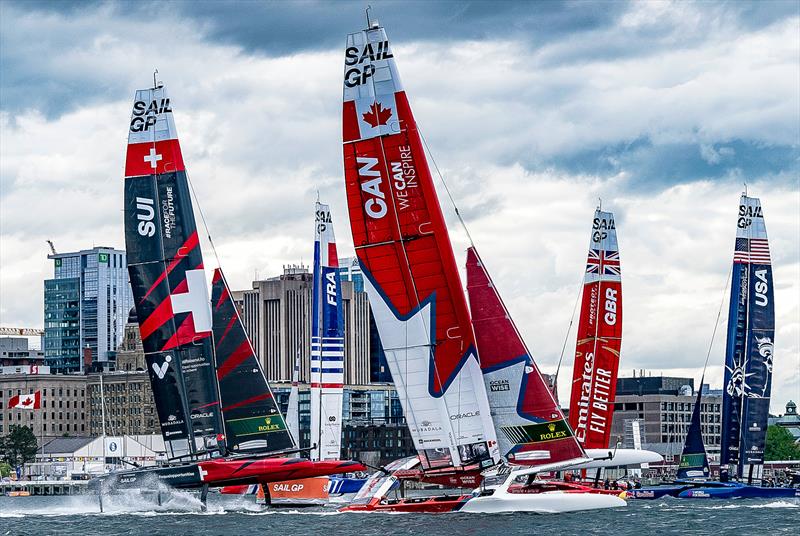
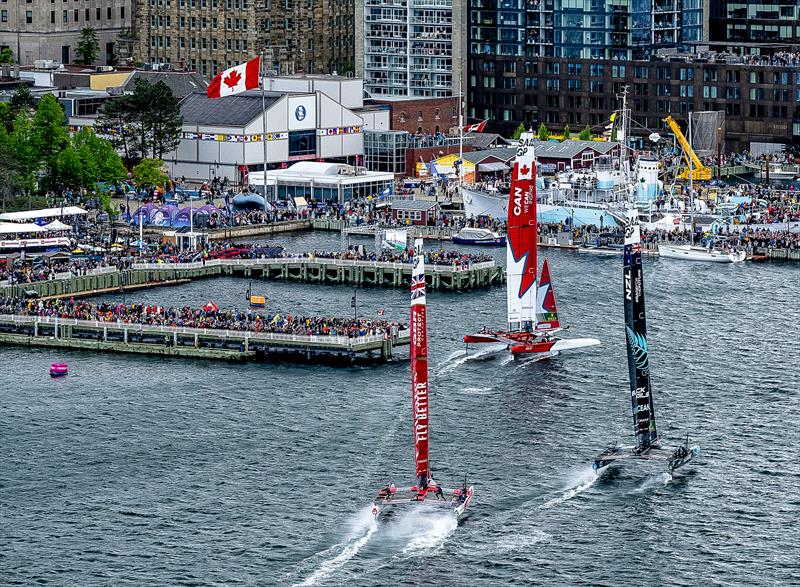
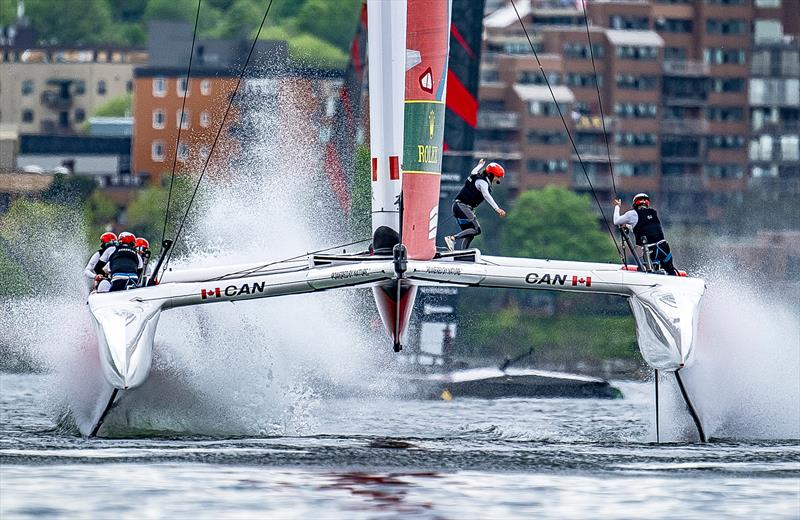
Related Articles
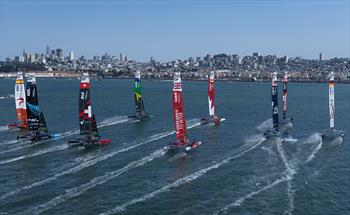

IMAGES
VIDEO
COMMENTS
The Best Catamarans for Sailing Around the World A catamaran is a double-hulled boat with a deck or cabin area in between (bluewater cat definition in this article ). The double hull design means that the boat rocks less, sits higher on the water, uses less fuel to sail, and can be sailed in shallower waters than a single-hulled boat without worrying about grounding.
Are you looking for a boat that is equal parts comfort and speed? Then the best sailing catamaran might be your dream boat. In this article, we'll look at how to choose the best catamaran for sailing around the world, point out some of the coolest boats on the market and try to answer the most common questions around catamarans.
You can absolutely sail a catamaran around the world! In fact, catamarans are preferred by many sailors for long ocean voyages, and dozens circumnavigate in all seasons each year. The number of catamarans continues to rise every year, and some of the world's most influential long-distance sailors have switched to them from monohulls. There ...
12 Best Catamaran Sailboats The appeal of the catamaran sailboats in terms of speed, stability, and the ability to embark on long-range cruising has made them hugely popular with today's sailors. But what are the best catamaran sailboats?
The type of boat best suited to sailing around the world is a well-built, long-distance cruising boat. Many sailboats fall into the camp, both monohulls and catamarans.
Another obvious observation: the best route around the world when sailing a catamaran, is the one where the wind always blows in the right direction, in other words the one where you're heading. With following seas. With the wind and waves on the stern, catamarans are made for sailing an average of 160 to 200 nautical miles per 24 hours.
Best catamaran and multihull: We sail the very best yachts on two and three hulls. Toby Hodges takes a look at all the nominees and the winner of the best catamaran and multihull category in the ...
A circumnavigation sailing trip on a catamaran : a 1,546-day adventure across 27 countries. The couple sailed their catamaran around the world for no less than 546 days, covering more than 34,140 nautical miles and 27 countries.
Cruising catamarans have been around for decades, but early models—often plywood and fiberglass vessels built by their owners from plans and kits, kept the boats on the fringes of mainstream sailing. That all changed, though, as big roomy cats were discovered by sailors who went off to charter in the Caribbean, where the multihulls proved their worth as comfortable liveaboard and party boats.
The fastest boat to sail around the world is a trimaran, and the shortest time recorded is 40days. If you are on a sailing cruiser, it will most likely take you somewhere between 1.5 to 5 years until you have reached a full circumnavigation.
The best size catamaran to sail around the world is 45 to 50 feet. The smallest catamaran with space for long-term provisions and a cabin is around 30 feet in length, and a 55 to 60-foot catamaran is the largest that can be accommodated at most marinas.
We reviewed the best Catamarans from Lagoon, Balance, and more. See what sets each multihull vessel apart in the buyer's guide.
Discover the wonders of sailing around the world. Explore the most beautiful ports of call on a catamaran, from the West Indies to the Indian Ocean.
For nearly four decades the Australian Seawind brand and its founder Richard Ward have been gearing catamarans around safe bluewater sailing, including performance, protection and ease of handling.
Sailing the world on a catamaran is a dream for many, but it can be hard to know where to start. So, what are the best catamarans to sail around the world?
Below, we have selected ten of the world's largest power and sailing catamarans, which offer guests stylish and stable cruising experiences with oodles of space.
Leaning towards the upper-sized catamarans for around-the-world voyages, the maximum size is 55-60 feet which offers significantly enhanced levels of comfort. Can you sail a catamaran around the world? As touched upon above, the answer to the question "Can you sail a catamaran around the world" is yes you can but traveling in comfort can ...
Trimarans are primarily used as personal boats for sailing enthusiasts or racing. These sailboats draw their versatility from their lightweight design, making them faster and easier to handle at sea when compared to single-hulled boats (monohulls). Additionally, the three hulls also contribute to better stability, making it very hard to capsize (although more likely than a cat according to ...
The Classic Sail Around the World Route - The Milk Run. The classic route for circumnavigating is based on the path of least resistance, making it the safest route to sail around the world. These routes utilize the prevailing winds to make as many downwind, fair-weather passages as possible.
Sunreef Yachts. Sunreef is the world's leading manufacturer of luxury sailing and power multihulls. Each catamaran, motor yacht, and superyacht they make is a custom vessel. The company was established in 2002 in Gdansk, Poland but a Frenchman and was the first brand to build a 74-foot bluewater cruising catamaran.
Every boat is a compromise, no one boat is perfect. But IF you have the money, THIS is the absolute dream to live on, and sail around the world! Welcome to S...
Whether for ocean crossing, sailing around the world, or along the coast, this 52-foot catamaran will make sailors and their families feel both safe and comfortable on their liveaboard boat.
Heavy Weather in a Sailing Catamaran - Adventure 39 of Sailing Around the World Sailing Nahoa 401K subscribers Subscribed 5.7K 445K views 5 years ago
Voodoo Yachts just unveiled another innovative foiling catamaran. Christened the XF95, the new 94-foot cat can reach more than 50 knots at full tilt.
The treasure in his chest is a twin-hulled sailing craft commonly called a catamaran. "You see catamarans all around the world, but a lot of people don't know it was created right here in ...
SailGP, in which 50-foot catamarans race at more than 60 mph in seas and bays around the world, is a grand prix sport comparable to Formula 1 but on water.
Saturday was the first day of the SailGP Grand Final in San Francisco, where high tech catamarans zipped across the Bay.
(Jane Tyska/Bay Area News Group) Sail GP F50 foiling catamarans from around the world practice for this weekend's Season 4 Grand Final in San Francisco, Calif., on Thurday, July 11, 2024.
Quentin Delapierre skippered France to finishes of 1-3-3 in a remarkable performance on San Francisco Bay to move close to advancing to SailGP's $2 million, winner-take-all Grand Final, the biggest payday in sailing.
Sail World - The world's largest sailing news network; sail and sailing, cruising, boating news ... like skipper Phil Robertson dressing as Justine Beaver, the team's mascot, and helming their F50 wingsailed foiling catamaran. ... they received a scolding from the organizers for having an untethered beaver running around the F50. Still, they ...